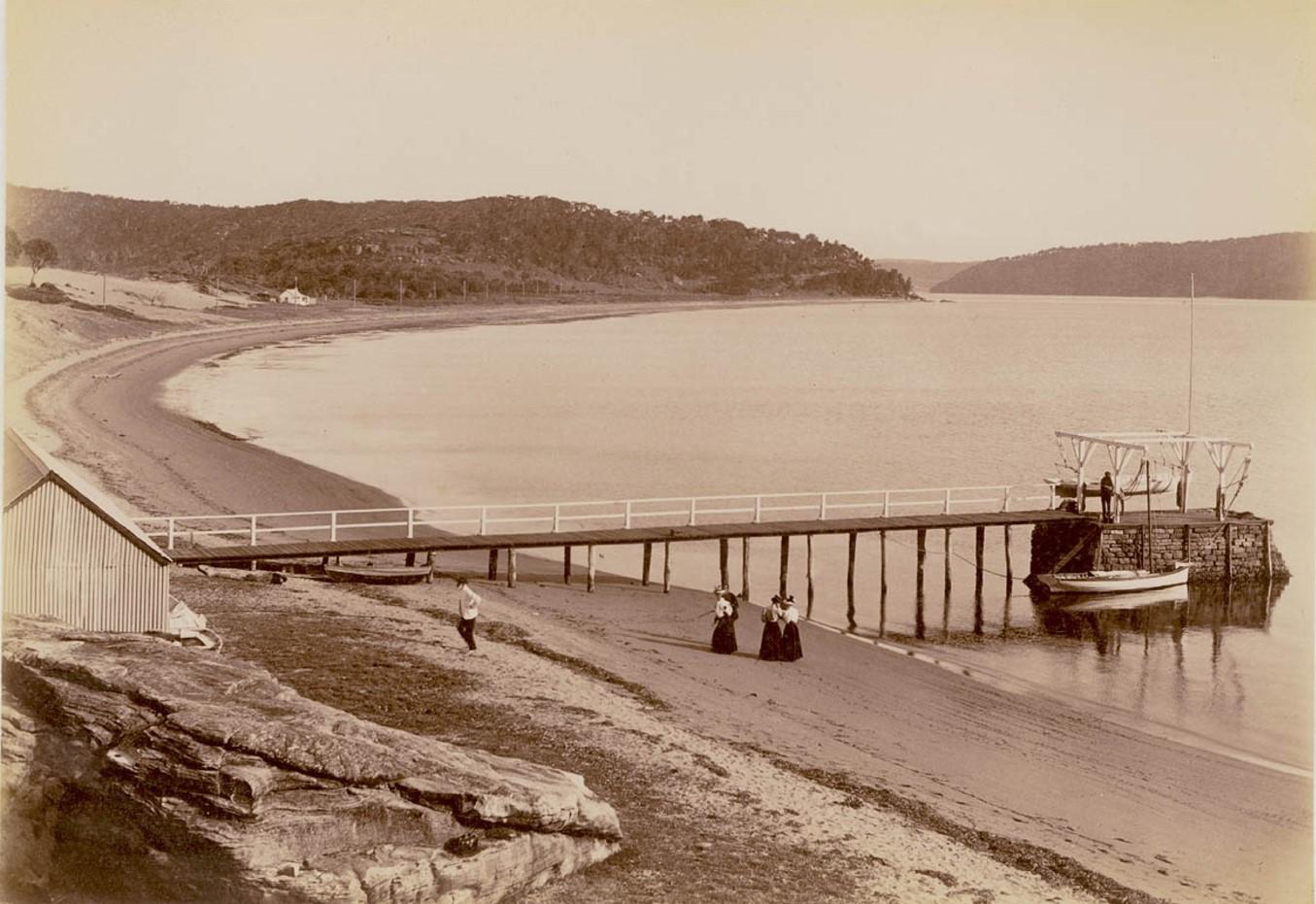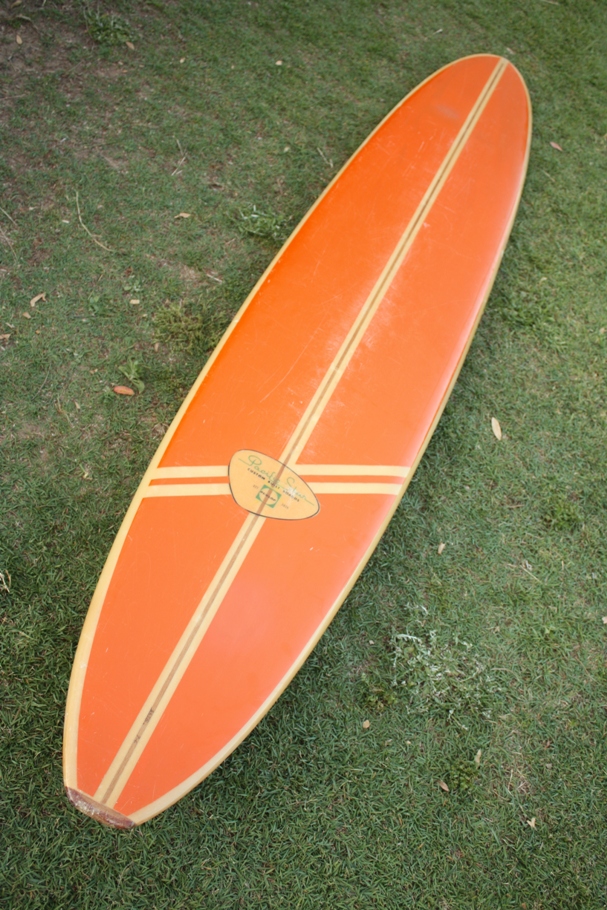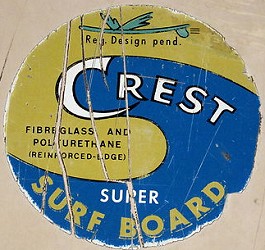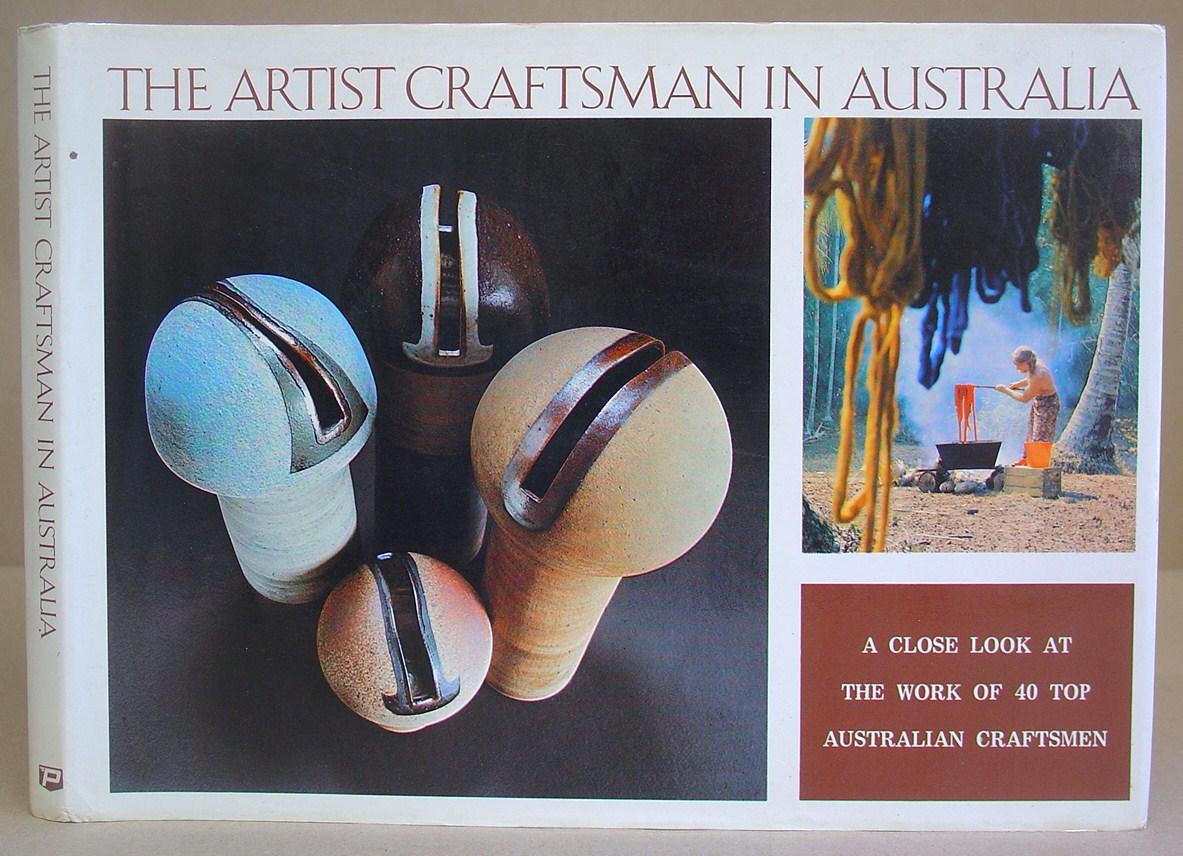Barrenjoey artists' commune in the lighthouse cottages: Post WWII Social Infrastructure investment enriched australia's cultural evolution
At Palm Beach they had a keen supporter in John ‘Johnny’ Morgan Hawkes, who had also served in WWII, was an early supporter of the Palm Beach SLSC, and a proponent of surfing at that end of the peninsula during the formative years of this sport. Mr. Hawkes also had a fondness for Art although, born in 1911 at Mount Lofty in South Australia, he was older than this group.
They were also joined by Moira Claux, an Artists model from aged 14, whose working career encompassed dancing, and then film and television production, and well over 50 years of working in the Arts.
Along with a few South Australian connections threaded through their lives tracks there is also a few New Zealand connections as Collinridge was born there and Bruen's father had been a New Zealander, serving in WWI first as a private and then as a war artist, prior to coming to Sydney in 1920, and meeting and marrying his mother at Mosman in 1922.
Bruen, Collinridge, Betty and Fay had served during the war in one capacity or another. This made them able to access and be beneficiaries of the Commonwealth Reconstruction Training Scheme (CRTS), introduced in March 1944 to provide educational and vocational training to those who had served in Australia's armed services during World War II. It was administered by the Central Reconstruction Training Committee (CA 357). The Scheme provided training for ex-servicemen and women necessary for them to be re-established in suitable civilian occupations. The last date for acceptance of applications was June 30th 1950 and by the middle of 1951 over 300,000 people had been accepted by the Scheme, making it one of the most significant strategies for social change in Australia.
In order to be eligible for assistance under the Scheme, servicemen and servicewomen were required to have had a minimum of six months service and to have been honourably discharged. Training was available in one of three categories – professional, vocational or rural – and could be undertaken either full time or on a part time basis. Individuals embarking on full time training had tuition and other fees paid and received living allowances.
Bruen, Collinridge, Betty, Colin, John and Fay were creators in many different mediums from painting, to sculpture, to working with fabrics.
Most of them made a living from what they had learnt either in the arts or in associated vocations and professions; Fay Bottrell becoming a renowned teacher of her craft, Collin Rivett going on to form an Art and later Historical Society in Parramatta as well as continuing to produce landscapes and cinderella stamps, Bruen using the elements learned in sculpture and applying these to industrial design as his own Brookvale business 'Crest Surfboards'. David Hain had been an economics student to begin with, Colin Brown
All of the above Artists attended the East Sydney Technical College, known as The National Art School. The National Art School today has its inner-city campus on the heritage-listed site of the former Darlinghurst Gaol. In 2022 NAS celebrates 100 years teaching art at this location, but its history dates back to 1843, when regular art classes were held by John Skinner Prout at the Sydney Mechanics’ School of Arts in Pitt Street, Sydney.
Forty years and several re-organisations later, in 1883 the Technical and Working Men’s College became known as the Sydney Technical College, which included the Department of Art. This department was relocated to the former Darlinghurst Gaol in 1922, and was then part of East Sydney Technical College. The 1920s saw the development of NAS’s distinctive studio model of teaching, offering its first five-year Diploma in Art in1926 under Lecturer-in-Charge Samuel Rowe and the English sculptor George Rayner Hoff.
In the 1950s and 1960s, the size and reputation of the Department of Art expanded. Renowned artists such as Colin Lanceley, Ann Thomson, Elisabeth Cummings, Peter Powditch, Ken Unsworth, Martin Sharp, Garry Shead, Janet Mansfield, Tim Storrier and Vivienne Binns graduated from the Diploma Course. At this time the NAS was part of the NSW Government’s Department of Technical Education.
During the 1930s and '40s the impact of surrealism became a subtext to artistic expression in Australia. While the surrealist movement's concern with the subconscious terrains of dreams and desires were not always directly addressed, artists strayed from purely formal concerns. The 1950s and 1960s saw the emergence of Abstract Expressionism, Colour field painting, Conceptual artists of Art & Language, Pop art, Op art, Hard-edge painting, Minimal art, Lyrical Abstraction, Fluxus, Happening, Video art, Postminimalism, Photorealism and various other movements.
Although we hear a lot about those who came home and 'just got on with it' what wasn't widely or commonly spoken about was those who struggled to adapt to or simply return to the life they had prior to serving in this conflict. Many of those who served could not 'settle down' afterwards. Records show some did not gain employment for up to 10 years after they served and were haunted by the memories of what they had experienced as well as dealing with the residue impact of wounds received during combat. Along with wounds many suffered from the ongoing impacts of diseases contracted through service - malaria, dysentery.
Undiagnosed as suffering from shock those 'sent home' without treatment were also faced with a housing shortage.
They were surrounded by people who had not seen what they had seen or been placed in the position they had been placed in; seeing their mates being killed, being responsible for 100-150 men, some of who died. So many felt essentially isolated and alone in their own communities. Interviews with men who had served in New Guinea or Europe show a lot of these did not like Anzac Day commemorations; it triggered too many still not dealt with memories. Who was there to talk to in such a society other than those who had served too; and even there the silence of the shock still predominated.
For everyone who had witnessed first-hand the atrocities or looked after loved ones who screamed through the night afterwards, or, as in America, the rise of so-called 'motorcycle gangs' formed from former Air Force members, the shiny 1950's surface did not betray what was occurring beneath, or in the case of those who no longer cared if they 'stuck out'.
Faced with their own mortality, those who did not want to 'fit in' afterwards sought alternative means to foster what was in their own natures and personalities. This generation commenced the social change that is noticed most in people speaking for themselves rather than having others speak for them - they spoke out loud or created or worked in the arts. To choose to live some other form of life would have been an obvious way forward, even if still 'outside the pale' and the perception that taking a 'job for life' and having a home and family was the safest way to live your life after war.
However, some among this group already had a background or had been raised in an atmosphere focussed on the Arts, that choice would have been a natural one.
One such instance is plain in the initiator of the Barrenjoey Artists Commune, Bruen Finey, the son of Artist and Cartoonist George Finey, who was called a Master of Modern Art during his last, 1980's, exhibitions.
Bruen Finey
Bruen Finey (October 10, 1923 to November 10, 2014) was born at Manly, the eldest son of George Edmund Finey and Nellie Phoebe (nee Murray). His parents married at Mosman's St. Clement's Rectory, by the Rev. C. T. L. Yarrington, on Saturday March 25, 1922. They lived at 'Finchley', Rosedale-avenue, Manly, where Nellie's father passed away soon after Bruen was born:
MURRAY.-July 8, 1925, suddenly, at the residence of his daughter (Mrs. Finey), Finchley, Rosedale-avenue, Manly, Samuel Isaac Murray, late of Bondi, aged 75 years. Family Notices (1925, July 9). The Sydney Morning Herald (NSW : 1842 - 1954), p. 10. Retrieved from http://nla.gov.au/nla.news-article16230624
George Finey (1895-1987), was born on March 16th 1895 at Parnell, Auckland, New Zealand, son of English-born Solomon Finey, mariner, and his wife Rose Emily, née Newton. He studied (1912-14) at the Elam School of Art, Auckland, and sold his drawings to local newspapers. Enlisting in the New Zealand Expeditionary Force, he served as a driver in the Army Service Corps in Egypt (1915-16) and on the Western Front (1916-18), and rose to sergeant (1918). Given leave to study art at the Regent Street Polytechnic, London, he admired the political caricatures in the German magazines Simplicissimus and Jugend. He was repatriated and discharged in 1919.
He moved to Sydney in 1921 and commenced a long career drawing caricatures for Smith’s Weekly from 1921, the Labor Daily (1931-33),Truth, the Daily Telegraph and by the Sunday Telegraph which, in 1940, published a book of war cartoons by Finey, Wep [W. E. Pidgeon] and Bill Mahony. Finey’s war cartoons savaged Hitler and Mussolini. In 1944 he and Mahony were dismissed, allegedly for refusing to draw a political cartoon dictated by the editor, Brian Penton. He was later reinstated for three years (1953-56).
George Finey was also a supporter of other New Zealand artists, a trait his son Bruen would also foster. Cartoonist Joseph Lynch was one artist who came to Sydney in 1922, encouraged by reports sent to him from George. Lynch was considered a rising cartoonist when one night in May 1927, dead drunk, he jumped off the 7.45 p.m. Neutral Bay-Mosman ferry Kiandra en route to a party at George Finey’s house at Manly and drowned near Fort Denison, inspiring Kenneth Slessor’s elegy “Five Bells”.
ARTIST DROWNED
Mr. Joseph Lynch of "Smith's"
SYDNEY, Monday.
Mr. Joseph Lynch, a black-and-white artist, employed on "Smith's Weekly." fell into the harbour from the ferry steamer Kiandra on Saturday evening and was drowned. With Mr. Frank Clancy, of the "Labour Daily," he left Circular Quay by the Kiandra at 7.45 p.m. The steamer had half completed its journey to Mosman, when the alarm was given that Mr. Lynch had fallen overboard. A fireman on the steamer, Sydney Taylor, jumped to the rescue, but was still a few yards away from Mr. Lynch, when the latter ceased to struggle and sank. Deceased was a single man. ARTIST DROWNED (1927, May 16). Goulburn Evening Penny Post (NSW : 1881 - 1940), p. 2 (EVENING). Retrieved from http://nla.gov.au/nla.news-article99310260
LIFE'S TRAGEDY
JOSEPH LYNCH, youngest member of "Smith's" Art Staff, was drowned in Sydney Harbour last Saturday night.
Lynch, who was New Zealand born, first contributed to "Smith's Weekly" four years ago, and at once attracted attention by his whimsical humour. Later, he joined the staff of Melbourne "Punch," and even his two years there failed to kill his sense of the comic. Last year Lynch was added to "Smith's" permanent black and white staff, and at once established his position among the men already there, men who had long since won for themselves Australian-wide reputations. Lynch specialised in social humour. In a way he was a black-and-white version of the late Ernest O'Farrell ("Kodak"). At the time of his death he was fast approaching the point where his technique would catch up with his imagination. Had he lived Lynch might have illustrated the comedy of life. Instead he died to illustrate its tragedy. LIFE'S TRAGEDY (1927, May 21). Smith's Weekly (Sydney, NSW : 1919 - 1950), p. 3. Retrieved from http://nla.gov.au/nla.news-article234447595
A "BOHEMIAN Night" will be staged at the Workers' Art Club, George Street, next Thursday, under the auspices of the Bertha McNamara Hostel Committee. Contributors to an excellent programme will include Roderick Quinn (who will read his narrative poem, "And Arnold Rode Behind"), George Finey (lightning sketches), Miss Bertha Lawson (A Henry Lawson sketch with Mr. Montgomery Stuart), Mr. A. E. Y. Benham, Mr. E. Hogan, Mrs. Alma Forrest; and others. In about out of Town (1933, September 3). The Sun (Sydney, NSW : 1910 - 1954), p. 31. Retrieved from http://nla.gov.au/nla.news-article229156116
Finey also drew for communist publications including Len Fox’s 1946 pamphlet Wealthy Men. Early in the 1940s he had left Sydney, which he called `the garbage can’, and moved to Springwood in the Blue Mountains.
In a 1950's Women's Weekly feature he stated that the cartoons and caricatures were 'bread and butter' jobs so he could pursue his Art works - the same article also states he commenced drawing and painting when six years of age.
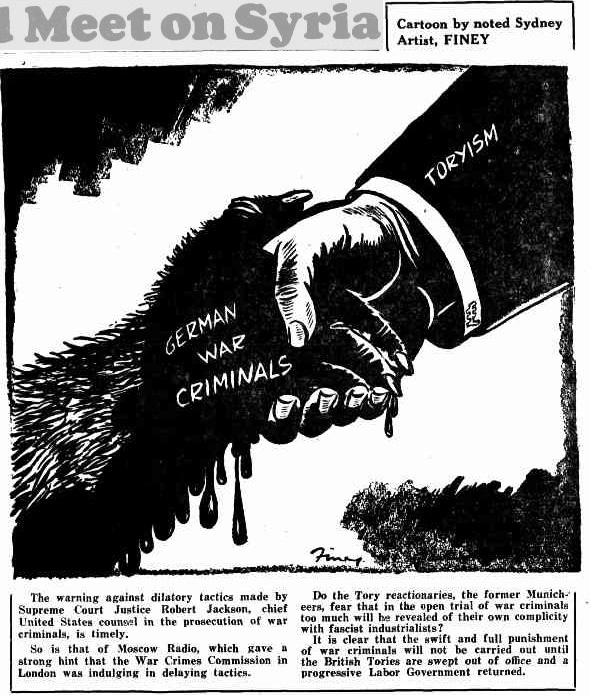
15 Jun 1945 - Cartoon by noted Sydney Artist, FINEY - Trove -
Bruen Finey had served in the Army and on being demobilised returned to his home, and married, a marriage which ended in divorce in 1954.
During WWII the troops of the 18th Battalion were based on Barrenjoey Headland and reported every hour to their Headquarters at St Ives using the telephone from the Beacon Store in Governor Phillip Park.
The cottages, past their use as a lookout point and barracks for the 18th had been the targets of vandals so the then Department of the Interior saw their being occupied, and refurbished, as a deterrent.
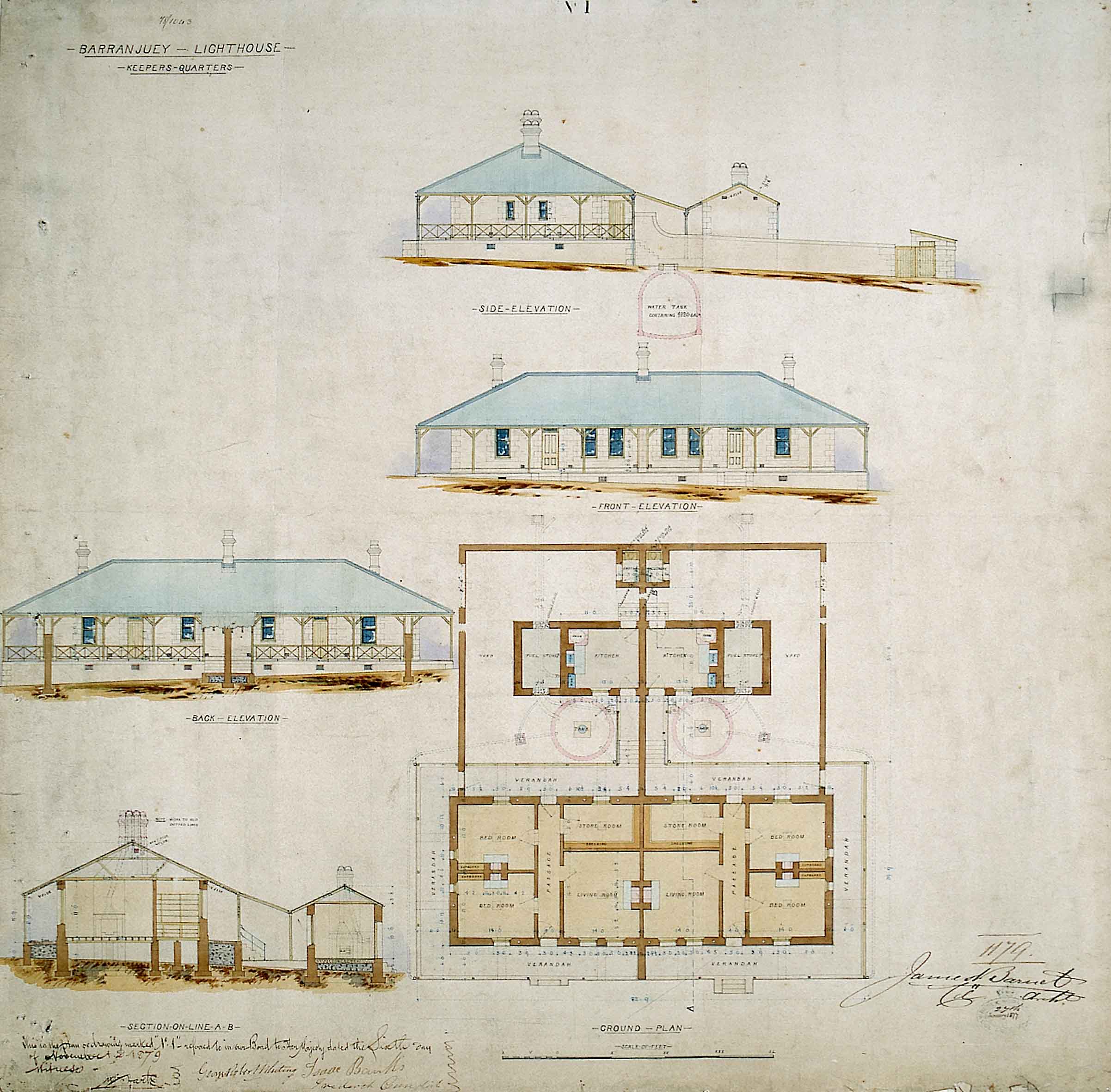
Pictures by staff photographer Ron Berg.
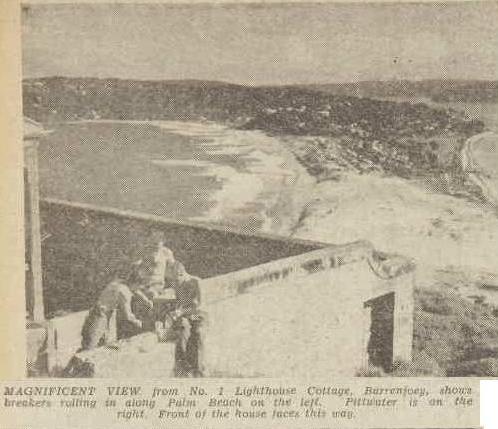 A spirit of adventure and plenty of enterprise have enabled a 26-year-old Sydney sculpture student to solve housing and studio problems by leasing a lighthouse-keepers' abandoned cottage for 5/- a week. The student is Bruen Finey, son of well-known artist George Finey. The house is a six-roomed cottage at Barrenjoey, Palm Beach, N.S.W. For years it has been ravaged by rats during the week and vandals at week-ends.
A spirit of adventure and plenty of enterprise have enabled a 26-year-old Sydney sculpture student to solve housing and studio problems by leasing a lighthouse-keepers' abandoned cottage for 5/- a week. The student is Bruen Finey, son of well-known artist George Finey. The house is a six-roomed cottage at Barrenjoey, Palm Beach, N.S.W. For years it has been ravaged by rats during the week and vandals at week-ends.
ALL that is left of the once snug dwelling is a stone shell with an iron roof.
Bruen, who is at East Sydney Technical College under the Commonwealth Reconstruction Training Scheme, is in his last term and wants somewhere to live and work. He has found in some fellow students equally ardent spirits, who will share the back-breaking job of making the house comfortable and form the nucleus of a small community with the arts as their great common interest.
The idea of taking the house first came to him when he was spending a day at Palm Beach in 1947. Enchanted by the position, more than 300 feet above the Pacific, with a magnificent view in all directions, Bruen was ready to tackle anything to make it his home. His first step was to find out which Government department controlled the house. It proved to be the Department of the Interior.
Barrenjoey headland, once the 400-acre farm of Larkfield, granted to an early settler in 1816, is now Commonwealth land reserved for use by the Army when it is required for defence, but at present administered by the Department.
Young Finey immediately applied for a lease, but it was not until January, 1949, that the transaction was complete, and Bruen received his passport to paradise-an official letter notifying him that he had a five years' lease of No. 1 House, Barrenjoey. Since then he has sweated and toiled week-end by week-end to make the house habitable. To make it so you would need what Bruen has-youth, enthusiasm, an undaunted spirit, and plenty of muscular strength-or a bottomless purse.
From the water's edge he and his friends carry on their shoulders every piece of material used. The only road is a narrow, steep track, strewn with big boulders and cut by deep gutters. It would be impassable for any vehicle except a jeep with a four wheel drive, or a horse and dray, such as the former Lighthouse keepers' furniture was brought in. One glorious day, with the pleasure-seeking Palm Beach week-end crowd forming a background to the hard slogging of the Barrenjoey boys. I joined the working party. David Hain and John Giles, two other members of the group, were with Bruen.
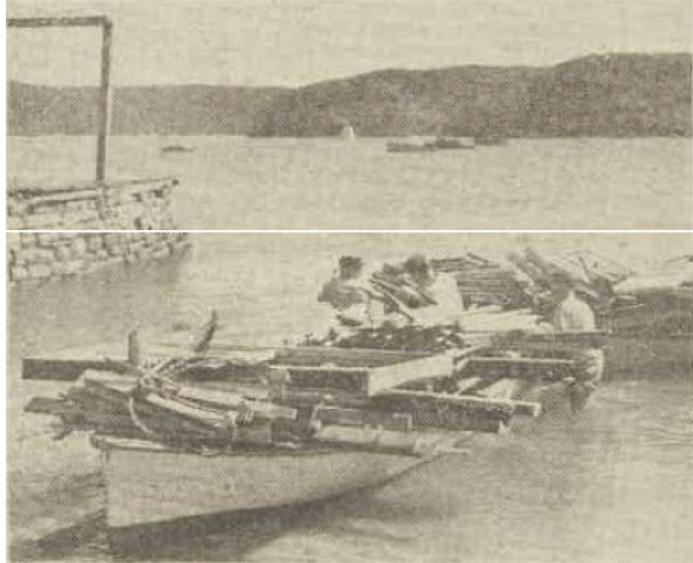 WADING waist-deep into the water, boys bring ashore two launches laden with materials for repairs. Old jetty was once busy scene when Broken Bay was port.
WADING waist-deep into the water, boys bring ashore two launches laden with materials for repairs. Old jetty was once busy scene when Broken Bay was port.
First scene of operations was alongside the golf links. Each lad in turn trundled a barrow, laden with materials, from the roadway to a nearby beach, where two launches were loaded to the Plimsoll line.
Cargo varied from huge doors to chair legs, and included an iron bedstead. It was a job lot the new tenants had picked up from a city hospital, and it had been stripped from an outpatients' section.
Working hard in the sun, the boys aroused the interest and sympathy of Mrs. E. Silverton, who brought from her home beer and biscuits to give them fresh heart.
It was a gesture you would expect from Mrs. Silverton, who remarked: "Well, dear, what I say is a little kindness never hurts you and I can't tell you all the happiness that has come to me because
I've been kind to people."
When I asked Mrs. Silverton how I would address something she asked me to send her she replied: "Just sent it to 'Auntie, Palm Beach.' Everyone here knows me.
"Auntie"' Silverton has a special interest in Barrenjoey, for the house next to Bruen's was once her home. She came from New Zealand, and brought with her some beautiful furniture made of a prized New Zealand wood. Mrs. Silverton and a friend used to run a tea-room in the house, but they were driven out by snakes, although the business brought in £5 a week.
Snakes have not daunted them, David has already stood on two.
When they were fully loaded the launches chugged off down the bay to the beach at the foot of Barrenjoey Headland. Bruen stores all his materials in a roomy, ramshackle boatshed near, the old jetty on the Pittwater side.
"Every time we climb to the top we carry something," he said.
First job Bruen did was to fill in the great windows from which even the frames had been taken, and to make a strong door for at least one room so that tools and materials would not "go off."
As everything is on the spacious scale of last century, the shutters for each window measure seven feet by three. That means a lot of carrying and a lot of carpentering. The shutters will be painted yellowand the wooden posts around the long stone-paved verandahs white.
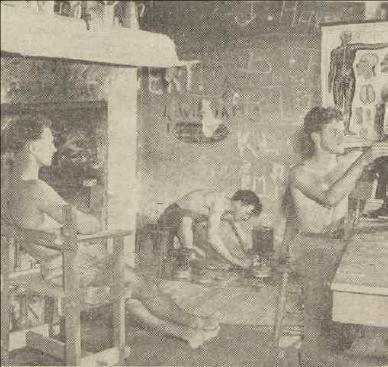 Picture left: HOMEMADE FURNITURE in the kitchen is the work of Bruen. Although primitive, it is solid. Defaced walls are typical of the vandalism in the old house, but the boys are confident that they will restore it in time. Each will have a room to himself.
Picture left: HOMEMADE FURNITURE in the kitchen is the work of Bruen. Although primitive, it is solid. Defaced walls are typical of the vandalism in the old house, but the boys are confident that they will restore it in time. Each will have a room to himself.
Big rooms
On the first floor, which is the level on which the house is entered, are six beautiful big rooms, each with its own fireplace, and a fines hallway, 33 feet long and six feet wide. Old sandstone steps, worn into hollows in the centre, lead down to the kitchen and bathroom, on the floor below. So far the bathroom is still a shambles, and the bath is still on the beach.
Opening from the kitchen is the courtyard, surrounded by a 12ft. wall of solid stone, where the boys “hope to have a vegetable garden," sheltered from the winds that sweep around the solid old house. In this courtyard is a huge well, more than 15ft. deep, which was filled with junk when the boys took over. They had to siphon out the water, then climb in, and remove; all the oddments that had been- thrown in, including galvanised iron pipes and bedsteads.
An eager volunteer loader and unloader on the day of my visit was John Arblaster, grandson of one of the lighthouse-keepers. She recalls settling into the fine six-roomed house. All her furniture, brought from Newcastle, where her husband had been stationed, was landed on the jetty, and taken by horse-drawn lorry up the steep slope.
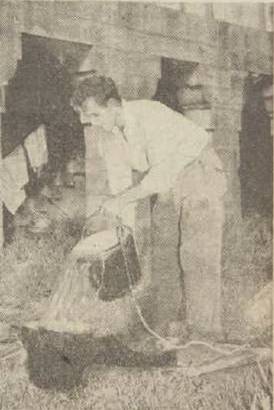 Picture right: WATER SUPPLY for No. 1 House, Barrenjoey, is a huge underground well in the courtyard. David Hain lowers one bucket, fills it, and then pours it into a second one.
Picture right: WATER SUPPLY for No. 1 House, Barrenjoey, is a huge underground well in the courtyard. David Hain lowers one bucket, fills it, and then pours it into a second one.
There was a light on the headland as early as 1855, but it was only lit in rough weather. The first permanent light was established in1868, at a cost of £300 for the tower and £85 for the light. In 1880 the foundation stone was laid of the present splendid tower, which is 38 feet high, and whose beam can be seen 25 miles at sea. It gives four flashes every 20 seconds.
The last of the keepers left the house in 1932, when the present unattended light first operated. In the lighthouse visitors' book there is this rather wistful record: "On the night of 13th August, 1932, no person was on the station for the first time since the light was established in 1868."
Bruen showed us, near his house, the gravestone of George Mulhall, who died at his lighthouse job in1881. His grave bears this message: "All ye that come my grave to see, Prepare in time to follow me, Repent at once without delay, For I in haste was called away."
The jetty, with its solid stone base and old loading gear, is a reminder that from 1843 until 1900 this quiet little spot was the landing stage for a customs house, used as long as Broken Bay ranked as a port.
There is a firm belief among the residents' of Barrenjoey headland that the first big thefts from Bruen's house took place overnight in a well organised raid. One theory is that the thieves lowered their loot on ropes from the cliff to a great flat rock below, where it is possible for a sea-going boat to pull alongside. The thieves left all the nails in neat piles when they stripped it of fixtures.
To the fishermen and their families who live in the shelter of the great cliff, the activities of the Barrenjoey Boys are a source of much interest.
Said Bruen, standing on the huge stone wall of his courtyard, and looking round: "There's only one trouble here-you're working away at some job or other, and you lookup, get lost in a dream, just looking, and looking, and before you know where you are you've wasted ages."
But I doubt if Bruen regards that time as really wasted.
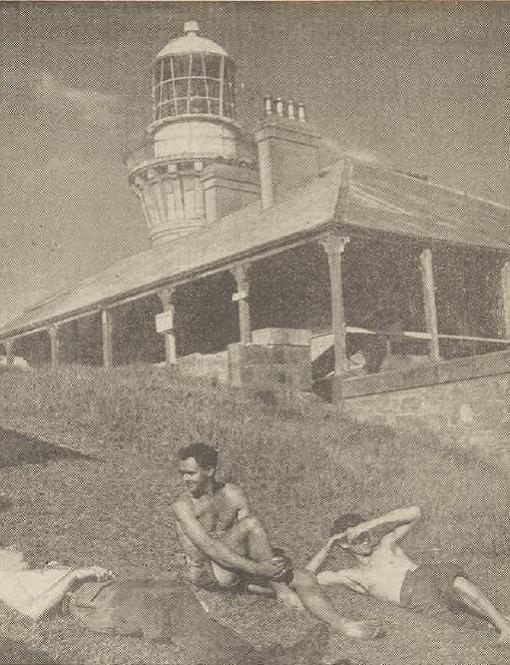 Picture left: WELL-EARNED REST for David Hain, Bruen Finey, and John Giles after carrying materials from the beach to the house they are making liveable. It had been stripped by vandals.
Picture left: WELL-EARNED REST for David Hain, Bruen Finey, and John Giles after carrying materials from the beach to the house they are making liveable. It had been stripped by vandals.
Old lighthouse cottage now sculptor's studio. (1950, May 20).The Australian Women's Weekly (1933 - 1982), p. 32. Retrieved from http://nla.gov.au/nla.news-article46455535
PALM Beach, I'm happy to prophesy, should be slightly less dreary this summer.
The melancholy mass of socialites who normally fill The Beach with their aimless chatter will be leavened by the colony living in the old stone house up on the heights of Barrenjoey.
Chief of the colony is sculptor, Bruen Finey, son of artist George.
Helping Bruen to restore the convict-built house are economics student, David Hain, and textile designer, Fay La Bottrell, while Susie Jane Rivett and her restaurateur husband, Collin, whizz up Continental dishes to keep up the artists' strength.
The colony, slaving like beavers, is turning the house into a show place, and week-end visitors who can do something are welcome.
The power to carve your name on a wall or gossip about night clubs is not regarded as sufficient proof of ability to do something. —The Cad. The Cad About Town (1950, September 9). Smith's Weekly (Sydney, NSW : 1919 - 1950), p. 27. Retrieved from http://nla.gov.au/nla.news-article235982909
THERE are busy scenes at the Lighthouse Settlement at Barren joey, which was torn about by vandals a few years back. A bunch of artists under sculptor Bruen Finey is restoring the settlement, hopes to have it ready in the New Year. Textile designer and weaver Fay Bottrell is in charge of the furnishings, Colin Brown looks after the garden landscape, restaurateur and art patron Col. Rivett and his wife look after the eating end. None of the work is easy; everything has to be hauled up the precipitous slopes by sheer muscular effort. ARTHUR POLKINGHORNE'S Sydney Diary-- (1950, November 11). The Sun (Sydney, NSW : 1910 - 1954), p. 5 (FINAL SPORT LAST RACE). Retrieved from http://nla.gov.au/nla.news-article230345145
RECOGNISED, despite funereal disguises, at Sydney Art Students' Costume Ball at the Trocadero last week, Parramatta personalities, Peggy and Joan Leve, Pauline McKenzie, Collin and Sue Rivett, and John Mackey of Coogee, who's well known up this way. All were in Bruen Finey's party of 30 characters whose representation of fantastic funeral cortege (complete with ethereal spirit and "corpse" in coffin,) was awarded a special prize by the judges, '"Sun"- columnist, Jim Macdougall, artist, 'Maurice Bramley and sculptor, Paul Beadle. Other Parramattans sighted in the crowd of 1200 at the- ball included Kevin Martin, Joy Jarvis, Spencer Bates, Wel Penbirthy, Stuart Carmichael and Sid Elliott. Many others reported present were too well disguised to be identified. I'm Told That.... (1950, December 6). The Cumberland Argus (Parramatta, NSW : 1950 - 1962), p. 5. Retrieved from http://nla.gov.au/nla.news-article110012149
MOTOR launch trip up the Hawkesbury last Wednesday, for party of eight included artists Collin and Sue Rivett, Bruen Finey, Fay Bottrell, David Hain, Colin Brown and Betty McMillan. Group went to investigate stone cottage up remote arm of river, hoping to purchase it for community week-ender for art group — to find, to their chagrin, someone with same idea had arrived before them and sale was already completed. They consoled themselves by spending day making sketches for oil paintings of picturesque cottage and surroundings. Social Spotlight. (1951, April 11). The Cumberland Argus (Parramatta, NSW : 1950 - 1962), p. 4. Retrieved from http://nla.gov.au/nla.news-article132146367
ARTHUR POLKINGHORNE'S
Some of these artistic people are a little remote from reality. Sculptor Bruen Finey took his Barrenjoey Lighthouse Settlement flock up the Hawkesbury the other day. Their launch stopped, Bruen thought it had run out of petrol, hailed a passing launch and asked if they could buy any farther up the river. "Yair" said the boatman. Off an ol' bloke at a boat-shed. Yer won't get any now though. He died this morn-m'." Anyhow, he looked at Bruen's boat, said there was plenty of petrol, found the engine had broken down and fixed it. ARTHUR POLKINGHORNE'S (1951, April 17). The Sun (Sydney, NSW : 1910 - 1954), p. 17 (LATE FINAL EXTRA). Retrieved from http://nla.gov.au/nla.news-article230069330
THE arty inhabitants of the fabulous Barrenjoey Lighthouse settlement dug up some odd bits in a stocktaking recently. They found a 19th century block-press, a black cat (female), a paper guillotine, a large loom, a more-than-modern barroom with murals and paintings created by George Finey for the walls, and a spinning wheel. A bushfire around the 380ft. high peninsula also revealed some unclassified antique iron work of exquisite workmanship. ARTHUR POLKINGHORNE'S (1952, March 3). The Sun (Sydney, NSW : 1910 - 1954), p. 11 (LATE FINAL EXTRA). Retrieved from http://nla.gov.au/nla.news-article229631739
Doggone! It's a dugong
Barnacle Bill, the first dugong seen hear Sydney since Captain Cook landed, is living in Broken Bay.
Mr. Bruin Finey, son of artist George Finey,
has cruised around Bill in a motor boat. Mr. Finey said last night he had seen the dugorig near the beach between Palm Beach golf links and Barrenjoey lighthouse each day for some weeks. The - dugong. encrusted with barnacles, fed most mornings or evenings on weed-beds near, the beach. The mammologist at the Australian Museum (Mr. E. Troughton) said last night
that the news of Barnacle Bill was "most exciting." He appealed to the public to let Bill alone. Mr. Troughton said: "Dugongs are totally protected. "Once they used to inhabit waters south of Sydney. "But that was many years before the memory of white men. "Aborigines hunted dugongs for food and oil and drove them out." Mr. Troughton said the dugong was closely related to the elephant. "Dugongs show great family devotion," Mr. Troughton said. "They sigh and groan if any member of the family is hurt or killed." Doggone! It's a dugong (1952, July 4). The Daily Telegraph (Sydney, NSW : 1931 - 1954), p. 3. Retrieved from http://nla.gov.au/nla.news-article248646256
John Hawkes, of Palm Beach, has a healthy attitude to art. He's invited a group of young artists to put on a show over the holidays in his on-the-beach homestead. The show started yesterday, will run for a week, and the idea is that the holiday-makers will be able to take in art as easily and informally as they take in the surf and the sun. Sculptor Bruen Finey and artist Des Connor will be among the exhibitors. ARTHUR POLKINGHORNE'S Sydney Diary- (1952, December 31). The Sun (Sydney, NSW : 1910 - 1954), p. 9 (LATE FINAL EXTRA). Retrieved from http://nla.gov.au/nla.news-article229639502
DEPARTMENT OF THE INTERIOR LEASE OF COTTAGES NOS 2 and 3 AT BARRENJOEY.
Offers closing with the Chief Property Officer Department of the Interior 5 Hickson Road Millers Point at noon on the 1st September 1952 are invited for the lease of the old Lighthouse Cottages Nos 2 and 3 at Barrenjoey for a period of 5 years with an option of renewal. The lease Is terminable at one months notice without compensation should the premises be required for Commonwealth purposes and subject to the usual conditions Including Insurance of premises and past rent of oil rates and taxes etc by the lessee. The premises are to be let as they stand and no expense In connection with renovation or repair will be borne by the commonwealth. No offer necessarily accepted WS KENT HUGHES Minister for the Interior . Advertising. (1952, August 23). The Sydney Morning Herald(NSW : 1842 - 1954), p. 17. Retrieved from http://nla.gov.au/nla.news-article18278568
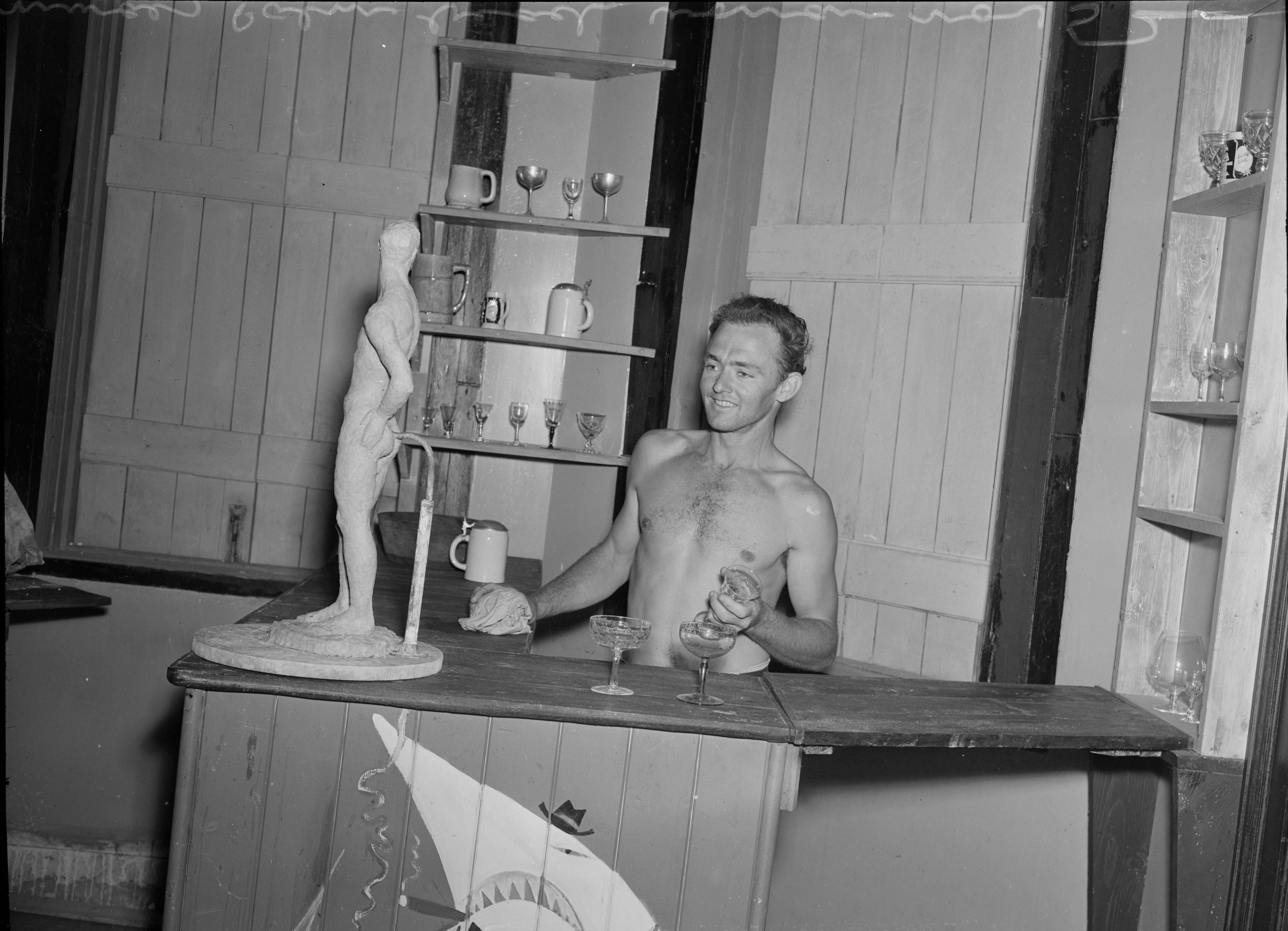
Murals, Palm Beach. Lighthouse, November 1952 / photographs by Fred Murray, items e16000_0001_c to e16000_0008_c courtesy Mitchell Library, State Library of New South Wales - NB: these look alike works by Bruen's father George Finey from 1951 onwards - see below and full 1951 Women's Weekly article under Extras - so he was either copying his father's style or his father either gave them these as decorations or his father visited here as well. This is Bruen behind the 'Barrenjoey Bar' (above).
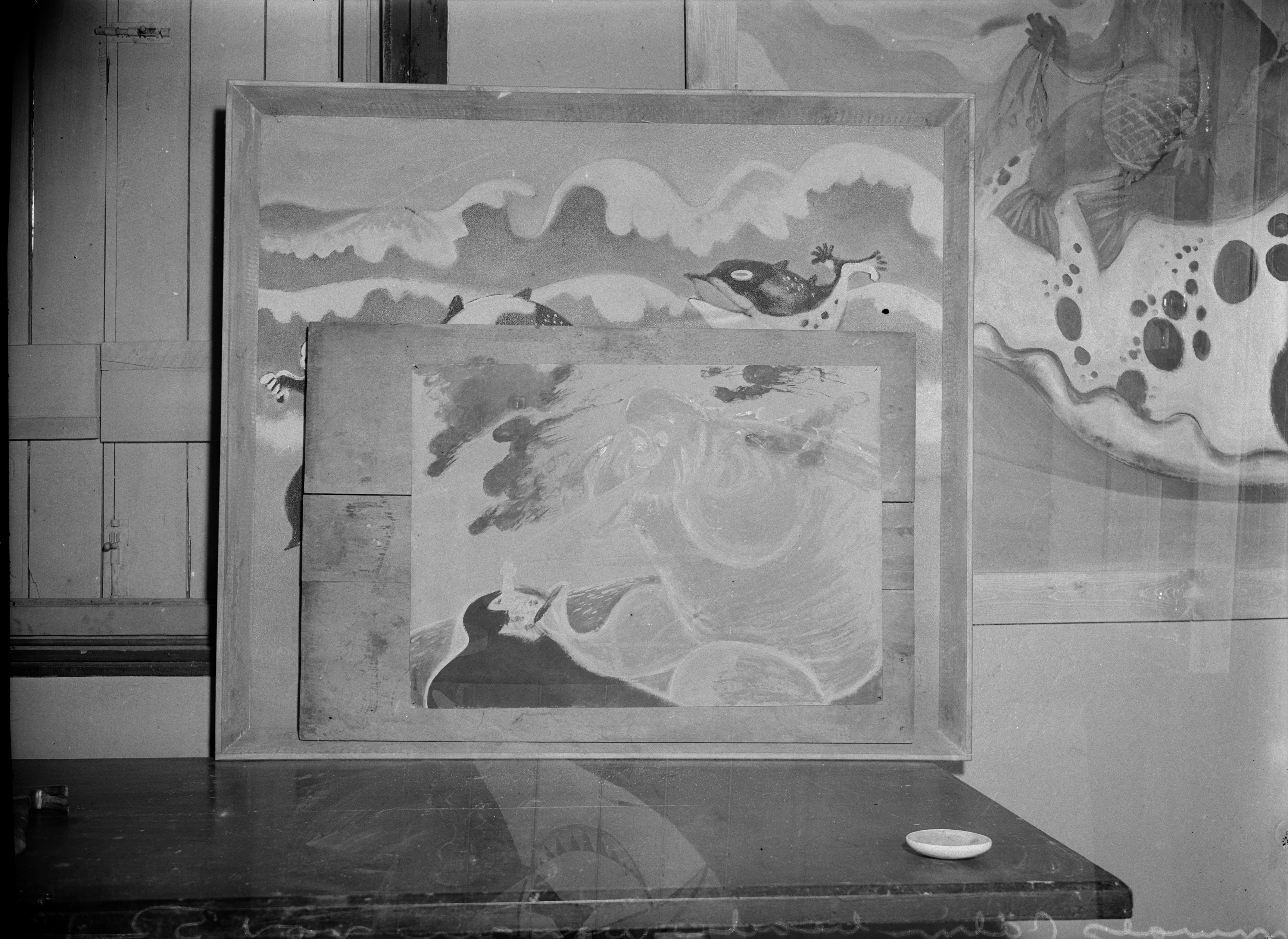
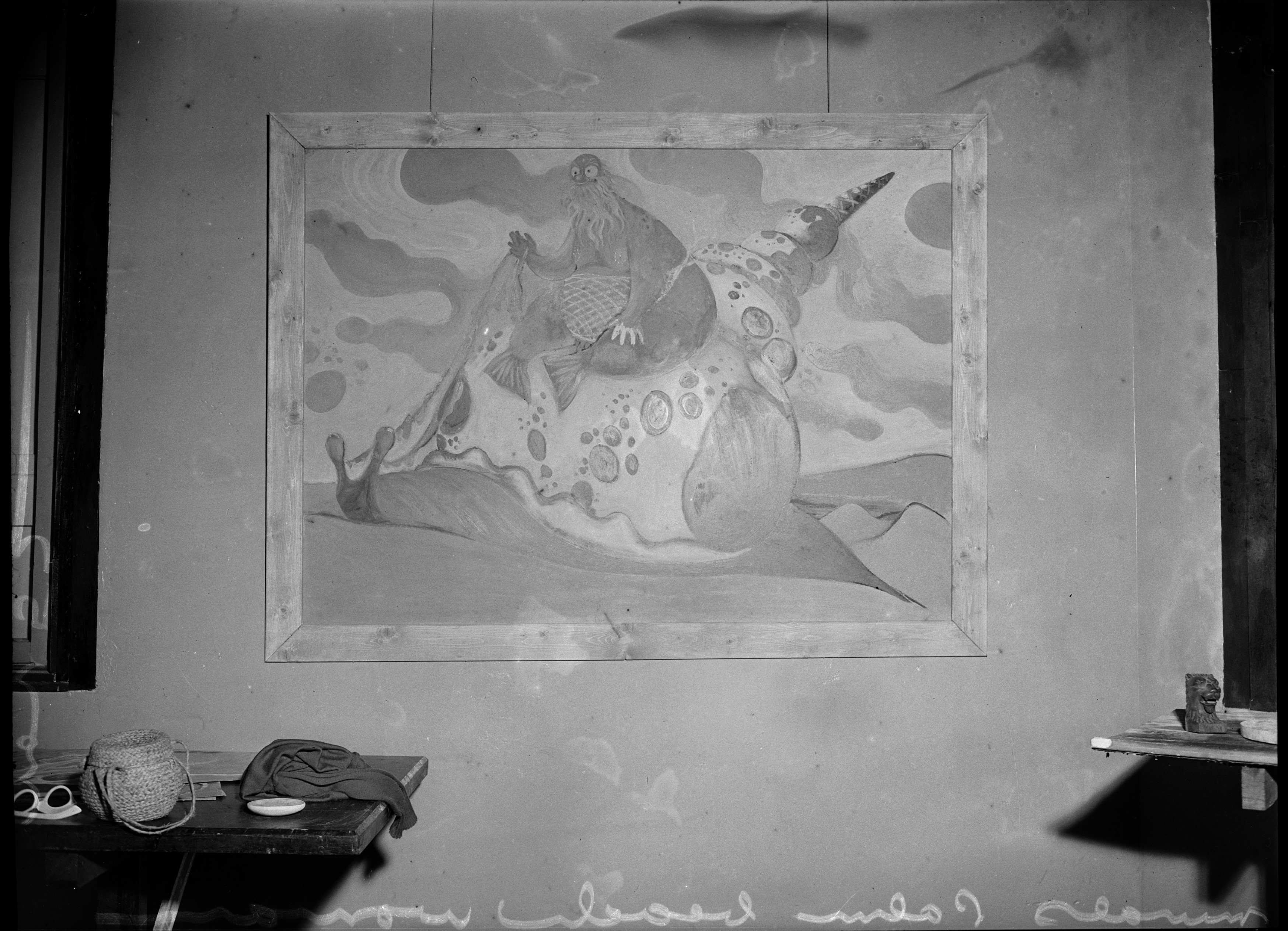
.jpg?timestamp=1648503533667)
FIGURE FOR BREWERY
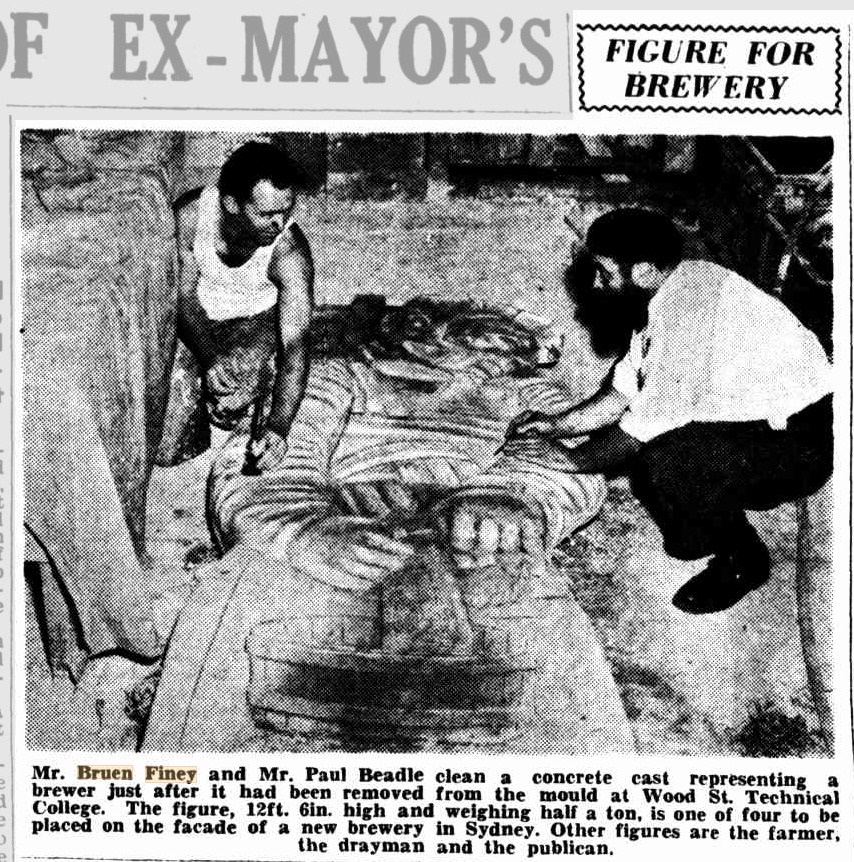
Mr. Bruen Finey and Mr. Paul Beadle clean a concrete cast representing a brewer just after it had been removed from the mould at Wood St. Technical College. The figure, 12ft. 6in. high and weighing half a ton, is one of four to be placed on the façade of a new brewery in Sydney. Other figures are the farmer, the drayman and the publican. FIGURE FOR BREWERY (1953, November 20). The Newcastle Sun (NSW : 1918 - 1954), p. 3. Retrieved from http://nla.gov.au/nla.news-article161500554
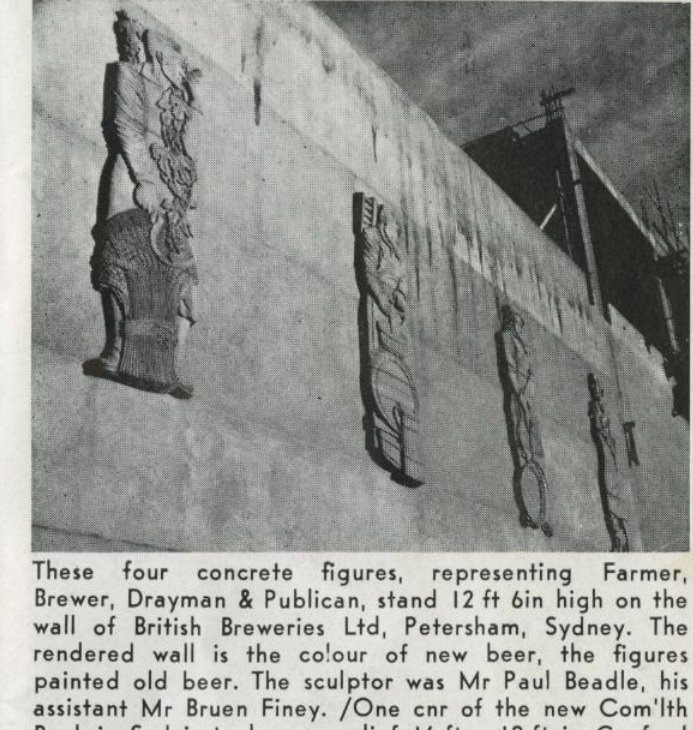
These sculptures, completed in 1954 celebrate beer production from growing, brewing, hauling and through to serving.
As with many students the meeting with and exchange of ideas between those working in the same field benefits the work. Meeting up outside of the rooms where they were taught was art of this and from these meetings commenced a new era of Sydney and Australian culture.
In George Repin's 'The Sydney Push' and 'Remembering Rowe Street' an insight into these changes is provided. In the years following WWII the influx of European migrants who opened shops on Rowe street meant visitors were introduced to new cultural experiences, including potentially the birth of Sydney’s coffee culture. Formerly known as Brougham Place, named after the Lord Brougham hostelry which was located opposite the Pitt Street end, in 1875 it was renamed as Rowe Street after Thomas Rowe, former Mayor of Manly, Sydney City Councillor and founder of the NSW Institute of Architects, as well as being the father of Harry Ruskin Rowe, formerly of Avalon Beach.
The Lincoln Coffee Lounge is said to be the birth place of the "Sydney Push" movement in its early days, just after the war. A popular meeting place for artists and writers, it comprised a mixture of university students, lecturers, Bohemians and Libertarians.
John Anderson, the Scottish-born Challis Professor of Philosophy at Sydney University from 1927 until his retirement in 1958. Anderson's promotion of 'freethought' in all subjects, including politics and morality, was controversial and brought him into constant conflict with the august senate of the university. However, he is credited with educating a generation of influential 'Andersonian' thinkers and activists—some of whom helped to place Sydney in the forefront of the 'sexual revolution' of the 1950s and 1960s.Many state he was seminal in the formation of Sydney Libertarianism of which, however, he vigorously disapproved. In 1951, a group of his disciples, led by Jim Baker, had formed a proactive faction which split Anderson's Free Thought Society. They asserted that it was natural and desirable for critical thought to engender commensurate action, the principle on which the Libertarian Society was launched.
The intellectual life of the Libertarians was mainly pursued in and around the university, including neighbouring pubs like May's, the Forest Lodge and the British Lion. On evenings and weekends, it overflowed into the much larger 'downtown' social milieu known as the Push, which flourished at a succession of pubs and other places of refreshment including the Tudor, Lincoln, Lorenzini's Wine Bar and Repin's Coffee Shop.
Apparently John Anderson coined the name ‘The Poseurs Push’ for the group and the term ‘The Push’ must have given Anderson a certain satirical pleasure for few years later he used it again to describe meetings of a different group of students as ‘The Proletarian Push’.
In The Northern Line, An on-line journal dedicated to the life and work of John Anderson, Edited by Mark Weblin, No 2 Apr. 2007 'The Lincoln Inn', it is recorded;
The Repins coffee shops were popular meeting places for students, with the King St shop attracting university students and art students from the East Sydney Technical College, while the Market St shop was popular with left wing and Communist intellectuals. The Moccador in George Street near Wynyard, the Arabian Coffee Shop in the Cross and the Kashmir Coffee Shop in Macleay Street were also popular meeting places for students wanting a place to meet and discuss ideas. For those who wanted something a bit more substantial than tea or coffee there was the Florentino’s restaurant in Elizabeth Street with its fixed menu of minestrone, pasta and salad, and coffee, Lorenzini’s wine bar, Packie’s night club in Elizabeth Street or the ‘stand-up’ bar (Ladies Allowed) out the back of the Newcastle Hotel in George Street. Occasionally the Port Jackson Jazz Band would play at the Ironworkers Hall at the top end of George Street. However at the start of 1948, a venue was established that would quickly, if briefly, eclipse them all as the centre of intellectual conversation and meeting place for diverse groups and individuals.
The ‘Lincoln Inn’, the ‘Lincoln Coffee Lounge’, the ‘stinkin Lincoln’ or simply the ‘snake-pit’ occupies a mythical status in the intellectual life of post-war Sydney. The Lincoln opened in early 1948 in Rowe Street just off Martin Place. It was a strategic location being just across the road from the Long Bar at the Australia Hotel and handy to the Theatre Royal, the society restaurants Prince’s and Romano’s, the GPO and the head offices of the main banks and newspaper offices. Rowe St. also had a number of art supply shops which was no doubt important for its initial attraction to the art students who were the main customers early on. (The National Art School was part of the East Sydney Technical College housed in the old Darlinghurst jail buildings and students would catch trams down Oxford Street to the city centre.)
The owner was a John Barry, a former Gunnery Lieutenant and successful real estate agent, who said he simply wanted to open a place where he could play a little chess. Barry’s partner in the enterprise was Eric Darklen, and Barry’s mother, Eleanor, a former actress, ran the kitchen. The owners employed an artist from East Sydney Art School, Joe Barry (no relation), to paint the inside of the Lincoln – ‘a dark blue star studded ceiling’ – who mentioned the opening to another art student, Fahy Bottrell. However Bottrell’s girlfriend, Dorothy Dale, was being courted by Eric Darklen, the co-owner of the Lincoln, and Dorothy told Fahy to invite people to the opening night. Bottrell passed the word on to Sonny Norbury/Norwood (aka Kathleen McCormack) who invited a lot of university people. On the opening night, things didn’t begin too well. Only about five people came in over the first five hours and Eleanor Barry decided to let the food they had prepared cool down. But the opening had clashed with a Society of Realist Art (SORA) meeting and Fahy Bottrell invited the entire group to the opening. As a result about twenty people turned up quite late and late hour operation henceforth became the norm.
Lincoln Coffee Lounge & Cafe, Rowe Street, Sydney / photographed by Brian Bird - Mitchell Library, State Library of New South Wales; Shows café scenes of artists & local identities, talking, socialising & performing, downstairs in the Lincoln Coffee Lounge:
_from_Lincoln_Coffee_Lounge_and_Cafe,_Rowe_Street,_Sydney_-_photographed_by_Brian_Bird_c._1948-1951_(5394988486) (1).jpg?timestamp=1648922540327)
Dick Gooding (on right of door)
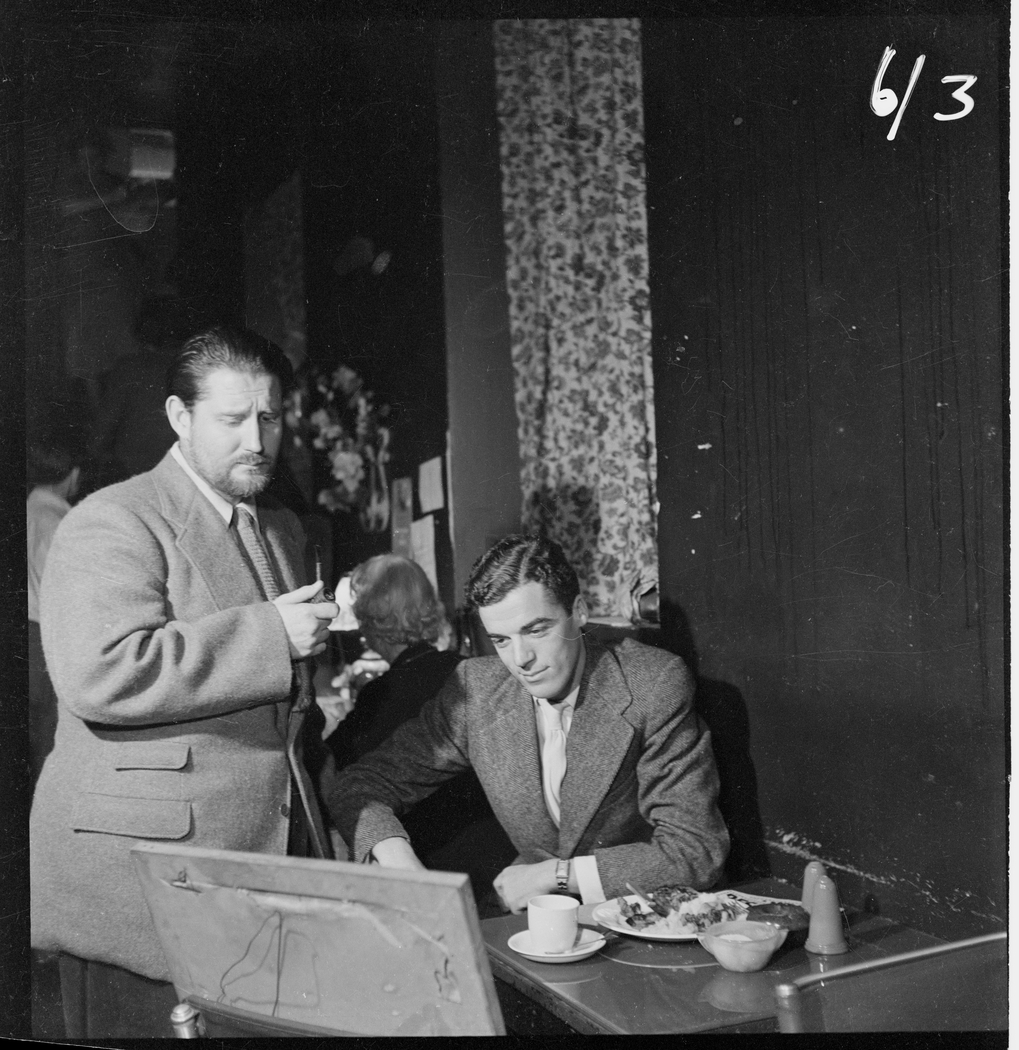
Piers Bourke ; John Barry (standing)
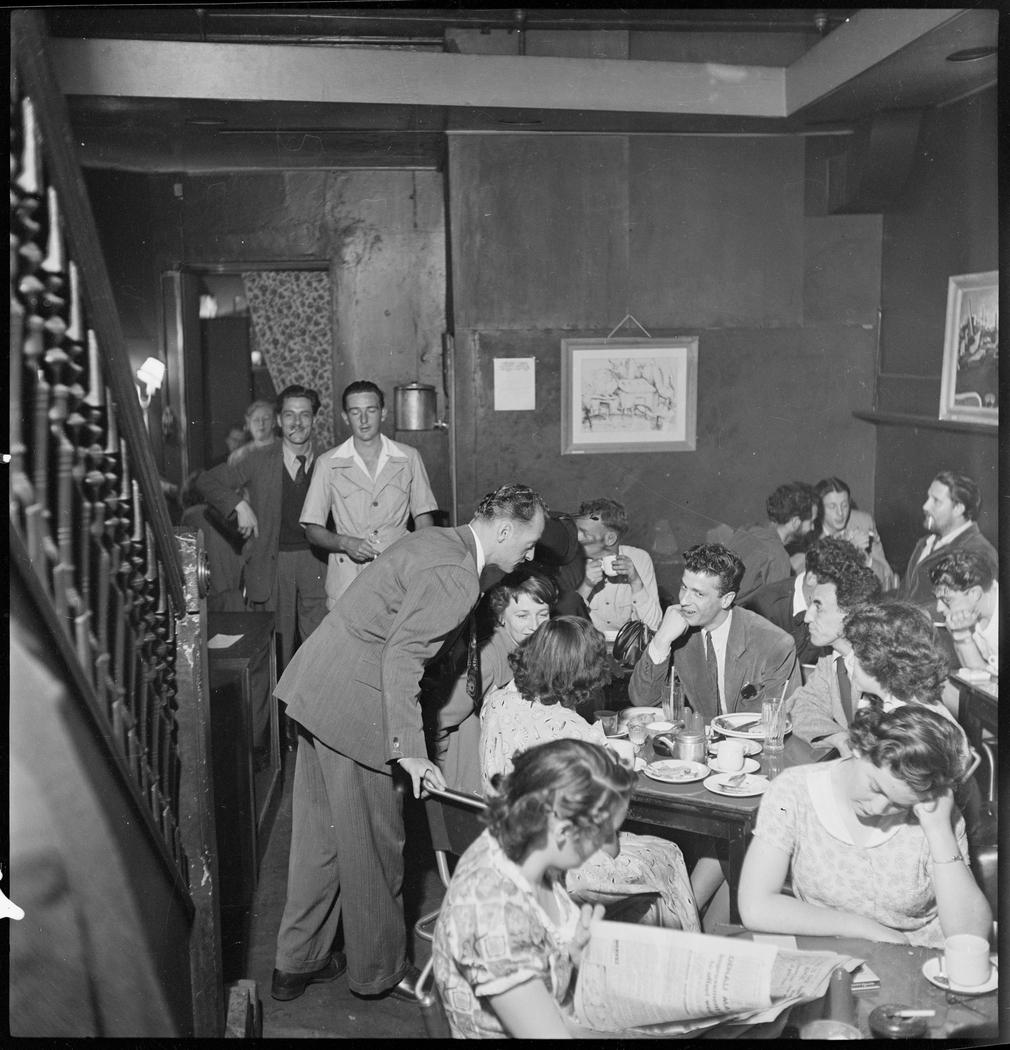
Piers Bourke (at rear, to right of corner) ; ‘Johnno’ Robert Johnson, student (to left of corner) ; Robert, Frenchman (with hand to chin)
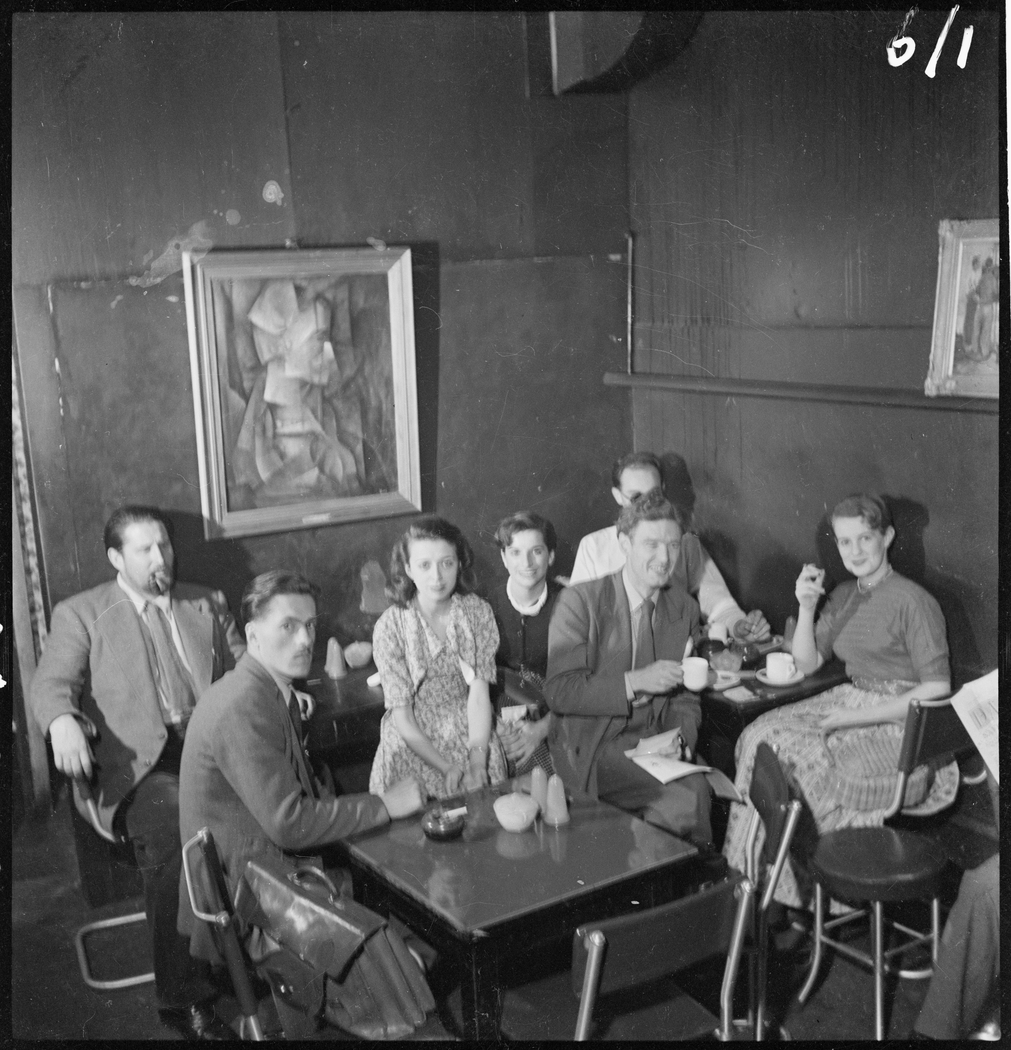
The subsequent history of the Lincoln is a relatively brief story. A weekly party at 15 Lower Fort St soon became a regular occasion after the Lincoln closed for the night and the group had moved on to one of the Repins coffee shops. By June 1949, the Lincoln was an ‘established and flourishing institution’ and featured in the daily press on a couple of occasions. Throughout 1950, its reputation as an alternative meeting place was firmly established, although by June 1951, the local ‘bohemians’ were annoyed by ‘staring tourists’. A Lincoln regular and Arts student, Ann Butler, recorded her irritation: “Many of the people who come here now don’t believe in Lincolnism. Lincolnism is a state of intellectualism which promotes friendliness and discussion. That can occur only when all are true believers. Eavesdropping tourists stifle freedom. They also take up too much room in the place.”
The high point of the life of the Lincoln occurred on March 6th 1952 when The Lincoln Anthology was published, but within two weeks came the news that the Lincoln had been sold to a Melbourne based chain of ‘toney’ coffee shops. However by this time the Lincoln had already became a central part of the mythology of post-war bohemianism.
The artists were the first to come to the Lincoln in any numbers and the group from the SORA meeting on the first night made the opening the success that it was. But others soon came. John Olsen and his future wife, Mary Flower, were regulars, Barbara Patterson, future wife to Charles Blackman, visited occasionally, the sculptor, Bob Klippel first heard of John Olsen at the Lincoln, the painter Francis Lymburger was a regular, and Cedric Flower, uncle to Mary, did artwork for the Lincoln which probably included the famous finger-pointing sign near the entrance in Rowe Street. Other artists included Piers Bourke, a one time stockman from Queensland who organised an exhibition at the Lincoln
A variety of musicians and singers were also regulars such as Kathleen McCormack who was there for the opening night. She lived in a flat with Fahy Bottrell and worked at the Independent Theatre in North Sydney and the Sydney Repertory. She later lived at 15 Lower Fort St under the Harbour Bridge and went on to establish a successful career as a folk singer. Bob Barnard, a jazz musician, was an early regular, as was Ron Grainer who later went to England and achieved some fame by composing the theme music for Dr Who. June Cairns and Bob Elliot were a duet whose singing was fondly remembered and other musicians included the guitarist Ray Price, John Robertson who played trumpet with the ABC orchestra, Richard Preston, Beth Doran (Schurr) and Judy Bodkin, better known as ‘Black Judy’. Another regular was art student and musician, Brian Mooney, who took a young Barry Humphries around the sly grog shops of Melbourne. On one occasion ‘six con students’ sang the Ninth Symphony at the Lincoln. A few dancers were also represented including Moira Claux – ‘Dancer as an occupation, but versatile by inclination’ – and Eileen Kramer, both of the Bodenwiser Ballet. Moira’s father, Kleber – ‘a true Frenchman with generous French emotion, but no French arrogance’ – had the fruit barrow outside the Liverpool St Courthouse and she also worked there on and off. However from a young age she was posing for the SORA meetings and is the subject for Max Dupain’s ‘Moira in a Mirror’. She travelled widely with the Bodenweiser Ballet and between trips she was a regular at the Lincoln. In the mid-fifties she married Bruen Finey and they had four children together at the Barrenjoey lighthouse. Eileen Kramer also travelled with the Bodenweiser and was a regular at the Lincoln, often in the company of Harry Hooton and Murray Sayle.
Journalists were a large group who frequented the Lincoln and included Tony Delano from The Truth, Ronald Monson from The Telegraph, David Rowbotham from The Bulletin and Jim Macdougall from the Sydney Morning Herald. Young freelance journalists like Murray Sayle and Ted Morrisby also frequented the Lincoln and during 1948 and 1949 when Sayle was working for the Daily Mirror he would frequent both the Lincoln and the Journalists Club and at the latter establishment would encounter Ken Slessor ‘reduced to glum silence as a writer of editorials for The Sun’. Another prominent group at the Lincoln was the science fiction group led by Graham Stone and Vol Molesworth. Others in this group included Michael McGuiness, Arthur Haddon, Lou Herbst, Phineas Glick, Harry Brunen, Rosemary Simmons, Sid Dunk, Alan Wilkes, Royce Williams and George Dovaston. The other large group who would frequent the Lincoln were the students from the university. The leader of this group appears to have been the irrepressible Lillian Roxon who started university in 1949 and during that year took many to the Lincoln including Sylvia Lawson, Barbara Paterson and George Clarke. Roxon’s famous sparring partner, Neil C. Hope (‘Sope’), was also a regular as were other students such as Bill Harcourt, Grahame Harrison, Peter Coleman and his future wife Verna Scott, Doug McCallum, Gordon Barton, Michael Baume, Martin Haberman, Lucy Gruder, Judy Gollan, Myfawny Gollan, and Roslyn Izzatt. [1 Appleton, R. ‘And then, to the Lincoln’ Heraclitus 99 Sept. 2002 p 10. 2 Ogilvie, J. The Push p 61 + 6.]
S.O.R.A. Exhibition
BY OUR ART CRITIC.
The Studio of Realist Art in its exhibition at David Jones' Art Gallery reaches an atmosphere of grey disquiet.
The one-sided statement, owing its bleak, existence to injustice, imagined or real, finds expression as a joint emotion of the nameless multitude in Clive Guthrie's "Shops at Glebe," Olive Long's "Blue Mountain Cottage," Roderick Shaw's "Butt Collector," Newton Headstrom's "Design For Living," Marjorie Penglase's "Street Corner Meeting," Nan Hortin's "Blackout," or Arthur Nichol's "Soprano" and "Barn Dance'.
With slothful disapproval McClintock's "Important Personages" look on - obviously connoisseurs of art.
"Family In Search Of a Manger," by Douglas Campbell, is also imbued with the spirit of a bitter symbolism.
Roland Wakelin, Sali Herman, and Oscar Edwards find their way into this glum gathering. The exhibition opens to-day. S.O.R.A. Exhibition (1949, August 23). The Sydney Morning Herald (NSW : 1842 - 1954), p. 5. Retrieved from http://nla.gov.au/nla.news-article18125646
CURRENT exhibition of art of George Finey was officially opened last week by Mrs. H. V. Evatt at private cocktail party given by Mr. and Mrs. Finey. Noticed among those present Sue and Collin Rivett, Ernest (Bill) Fletcher, Shirley Campbell and Douglas MacGregor, of Epping, Fay Bottrell, Sid Dover, and George's son, sculptor-artist, Bruen Finey. The exhibition remains open at Katinka Library, 175 Pitt Street, Sydney, until July 17. Social Spotlight. (1951, July 11). The Cumberland Argus (Parramatta, NSW : 1950 - 1962), p. 4. Retrieved from http://nla.gov.au/nla.news-article132146982
Bruen Finey had married soon after his war service ended. In 1945 he married Vera May Jackson, the certificate was registered at Penrith.
FINEY v. FINEY.
Her adultery with James Jackson, at Balgowlah, was the reason Bruen Finey, artist, of Barrenjoey lighthouse, Palm Beach, sought divorce from Vera May Finey, formerly Jackson, of Balgowlah. Mr. S. S. Mitchell appeared for Jackson. DIVORCE COURT IN NEWCASTLE (1954, December 18). Newcastle Morning Herald and Miners' Advocate (NSW : 1876 - 1954), p. 18. Retrieved from http://nla.gov.au/nla.news-article134097055
Moira Claux
In the mid 1950's Bruen and Moira Claux (1931-2017) began having the first of four children together, although it's likely they met prior to that - Moira had been an artists model at East Sydney Tech. from the mid 1940's and also one of those who frequented the Lincoln Inn. Moira, a dancer and artists model, with a background and upbringing that today would be defined as 'alternative', would have matched Bruen's own upbringing, where his father, even when in his 80's and giving some of his last exhibitions, was described as 'the last great bohemian'. They both demonstrated a lifelong commitment to trying to work in their chosen fields - where jobs could and still can be few and far between and those who adapt or take on other work are best able to support longevity in the arts.
Moira, who eventually moved to New Norfolk Tasmania in 2011, where she passed away in 2017, certainly demonstrates that perseverance and tenacity.
Moira made the papers in late 1947 due to films of her, as well as others, in the 'scintillation' vein being shown at Manly's Fun parlor, then on the Manly Pier. Examples, along with photographs, read:
Films of nudes through spyhole at 6d a peep at Manly parlor
By a Staff Reporter
Miniature movies showing girls playing strip poker, and others swimming and gambolling in the nude, are being shown daily at a Manly fun parlor.
Six films of American and Australian origin are shown, depicting nude or semi-nude women. Each film lasts about a minute, and costs 6d to see. These movies are being shown at the Manly Luna Park fun parlor (on the Ocean Beach).
Two electrically driven 16mm. projectors installed in 5ft.-high compartments with a spy-hole in the top, operate at the insertion of 6d. Titles of the films are: "Her Private Life," "The Water Nymph," "Boudoir Bandit," "Tropicana," "African Frenzy," Strip Poker." "Her Private Life" (Australian) shows a girl undressing and getting into bed. "The Water Nymph" (filmed in French's Forest) shows an attractive Sydney brunette playing and swimming in a pond in the nude.
'Vice Squad's visit
The parlor also exhibits electrically operated penny machines showing "still" shots of nude girls. Some of these photographs were taken locally. Proprietor of the park, Mr. Harold Spry, said representatives of the Chief Secretary's Department and the Vice Squad recently inspected the penny machines, but not the films. His son,. Arnold, .had invented the movie machine and he himself had shot films for it, he said. He was careful about what he was showing, he said, and would willingly make cuts if requested. Last month, in the Legislative Assembly, Mr. Arthur (Lab., Hamilton) asked the Chief Secretary (Mr. Baddeley) to confiscate "salacious penny slot machines" which, he said, were on Manly pier. Police later made a report on these machines. Films of nudes through spyhole at 6d a peep at Manly parlor (1947, December 29). The Sun (Sydney, NSW : 1910 - 1954), p. 5 (LATE FINAL EXTRA). Retrieved from http://nla.gov.au/nla.news-article230561578
Modelled in nude for films
Studies were "refreshing"
Striking 16-year-old brownette, Miss Moira Claux, who posed for a nude film which has been banned from a Manly fun parlor, thinks natural nude picture exhibitions should be encouraged to dispel false prudery. "I am opposed to the suggestive sex pictures which show models in postures and actions designed to arouse sexual emotion, but I believe natural nude studies are refreshing and artistic." Miss Claux said today.
A well-known Sydney model, and a vegetarian, Miss Claux is also a confirmed nudist. "I only pose for pictures which show nature as it is, and which may give some fillip to the healthy practice of nudism," she said. "Water nymph"
"The films in which I posed are the movie 'Water Nymph,' which shows me diving into a forest pool in the nude, and, the stills, 'River Nymph,' a full nude study, and 'Salome,'' a draped indoor picture.
"I was most uncomfortable posing for the 'Salome' shot, because of the unnatural indoor surroundings and the seductive drapery. "I cannot understand the censors objecting to any of the pictures in which I figure, although I do object to some of the American films which have been confiscated.
Miss Claux's parents and three brothers, who live in West Botany-street, Banksia, are also confirmed nudists. Mr. Harold Spry, proprietor of a Manly fun parlor from which six 16mm. movie films were confiscated by the-Government yesterday, said he would decide today whether he will appeal. He will make his decision after he sees the Commonwealth Film Censor (Mr. Alexander). Modelled in nude for films (1947, December 31). The Sun (Sydney, NSW : 1910 - 1954), p. 3 (LATE FINAL EXTRA). Retrieved from http://nla.gov.au/nla.news-article230551598
POLICE SEIZE "FUN" FILMS
Pictures Of Nude Girls Confiscated
Customs and police officials yesterday seized six 16mm movie films of nude and semi-nude women which were being screened at a Manly fun parlor. The Commonwealth Film Censor (Mr. Alexander) said last night that he had confiscated four of the films which had been imported from America.
He said he would not pass the four films even for adult exhibition. Officers of the Chief Secretary's Department are holding the other two films, which were made in Australia. Mr. Alexander has no power to censor films made in New South Wales. A State Government official last night described all the films as being more suggestive than obscene or indecent. The films showed girls playing strip poker, swimming, and sunbaking in the nude and performing hula-hula dances. A member of the Customs Department Investigation Branch (Mr. Brosois), accompanied by police, confiscated the six films at Mr. C. A Spry's fun parlor on Manly pier yesterday morning.
Yesterday afternoon, Mr. Alexander, Mr. F. R. Lake, who is an official of the Chief Secretary's Department and a member of the State Films Commission, and another member of the Chief Secretary's staff viewed the films.
Not Registered
Mr. Alexander said the four films imported from America had not been registered with the Customs Department, and had not been submitted to him for censorship. He added: "I am refusing to register them because they contain matter which I con-sider should not be exhibited in the public interest.
"Mr. Spry, who owns the films, has the right of appeal against my decision. "Mr. Spry will confer with me tomorrow.
"I will not order the destruction of the films until he decides if he will appeal.''
A Customs Department official said the department was satisfied that Mr. Spry had not imported the four American films, but had bought them from a man in Sydney. The official said this man might be prosecuted for having failed to register and submit to censorship films imported from America. Mr. Alexander said he had no power to confiscate or censor still photographs of nude and semi-nude women being shown in city fun parlors.
Model's View
Miss Moira Claux, beautiful brunette, 16-year-old daughter in a family of nudists living in West Botany Street, Banksia, said last night she was the Australian model in films now showing at Sydney fun parlors. Miss Claux is a well-known Sydney studio model. She has modelled regularly for the East Sydney Technical College, the Bond Street Sketch Club, and the Sora studio of Realist Art. "The films in which I posed are the moving picture 'Water Nymph' and ' the still pictures 'River Nymph' and '.Salome,' " she said. “I have seen the fun parlor pictures, and I think many of them are sexually suggestive. "The ones in which I posed, I think, are carefree and natural, and would not induce sexual emotion. "Like the rest of my family, I am a confirmed nudist." MISS CLAUX. POLICE SEIZE "FUN" FILMS (1947, December 31). The Daily Telegraph (Sydney, NSW : 1931 - 1954), p. 9. Retrieved from http://nla.gov.au/nla.news-article248108226
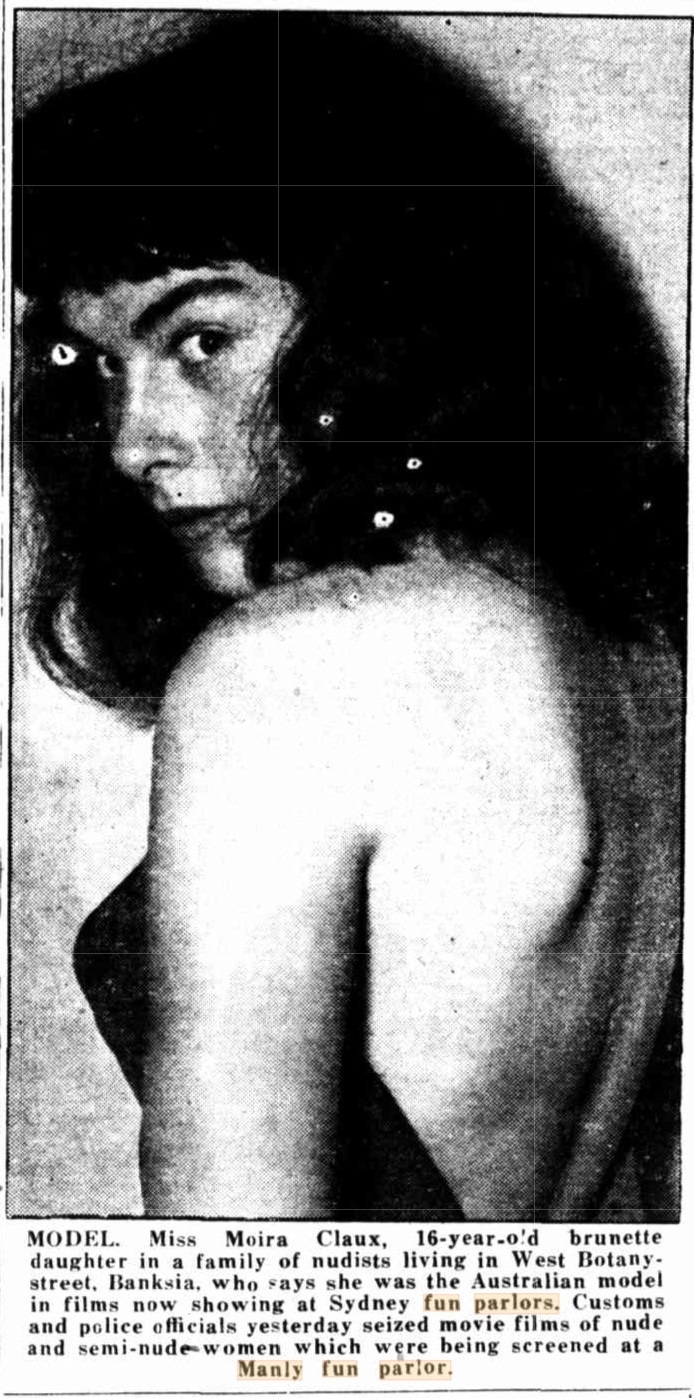
No title (1947, December 31). The Sun (Sydney, NSW : 1910 - 1954), p. 3 (LATE FINAL EXTRA). Retrieved from http://nla.gov.au/nla.news-article230551603
Moira Claux, 16-years-old model and nudist. She was featured in the film which was banned at a Manly fun parlor.
.jpg?timestamp=1648490416745)
Police swoop on fun parlor, seize peep-show
POLICE seized a peep-show at Glenelg (South Australia) fun parlor yesterday and made five others unusable. Parents of children who visited the show, complained about films of scantily-clad women.
The proprietor of the fun parlor told police he had had the films for 13 years. Mr. Kleber Claux, whose daughter Moira, 16, posed for a nude film banned at a Manly parlor, said last night that the Government should set aside special areas for nudists. Mr, Claux, his wife and their four children all practise nudism. "We don't attach very much significance to the ban," said Mr. Claux. "Moira is a model and merely fulfilled an assignment."
Claux, 54, is muscular and tanned. He has a thick grey beard, clear, light blue eyes. He wore only a pair of trunks, sat straight-backed on a kitchen chair. Mrs. Claux, who is 42, was barefooted, wore a floral housecoat.
Easily policed
"I don't believe nudists should force themselves on the public. We are most careful not to do that," said Mr. Claux. "We have private land, where we can practise nudism out of other people's way. "It would be a great thing if the Government set aside areas for people to practice nudism. "If it was felt that there was danger of promiscuity, the areas could he policed easily. "But I don't believe there would be any danger. Claux's four children are Eugene, 18; Moira, 16; Gaspar, 11; and Kleber, 6. When Mr. Claux was asked if the family would pose for a photograph, Gaspar said: "I don't want my picture taken."
As Gaspar walked out of the room, Mr. Claux said: "I don't force my children to do things they don't want to do. I want to teach them the meaning of personal freedom. "They may not respect me any more for it now, but they will have character."
Nude films
Nude "peep-show" films are still being shown at two fun parlors in the city. Chief Secretary Baddeley, Police Commissioner MacKay and Lord Mayor Bartley said yesterday that they had no power to stop the showing of these films unless it could be established that they were obscene.
.jpg?timestamp=1648490447122)
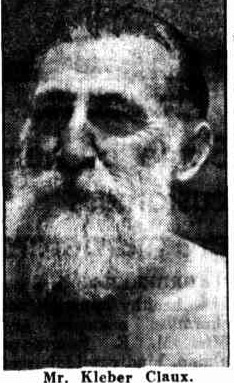
Mrs. Claux. Mr. Kleber Claux.
Nude films all in day's work (1948, January 4). The Sun (Sydney, NSW : 1910 - 1954), p. 5. Retrieved from http://nla.gov.au/nla.news-article229042069
Objects To Sister Posing For Fun Parlors
Eugene Claux, 19-year old brother of model Moira Claux, objects to his sister posing for nude and semi-nude films which have been shown in Sydney fun parlors. Eugene and Moira are children of Kleber Claux, one of Sydney's leading nudists. "I hate to think of my sister providing amusement for some of the larrikins who visit fun parlors,'' said Eugene. "If I felt that the men who looked at the pictures were genuinely interested in nudism I would not mind. "But most of the men are just looking for a thrill."
Miss Claux, who is a well-known Sydney model, says she posed for a moving picture, "Water Nymph," and a still picture. "River Nymph,’' which were taken for exhibition at fun parlors. She claims the films are carefree and natural, and do not stimulate sexual emotion. Objects To Sister Posing For Fun Parlors (1948, January 5). Singleton Argus (NSW : 1880 - 1954), p. 1. Retrieved from http://nla.gov.au/nla.news-article84603760
The Manly Fun Pier started life as a cargo wharf at Manly Cove in the 1850s. In 1927 the cargo wharf was closed and in 1931 it was reopened as the Manly Amusement Pier and promoted with the slogan "Built for fun in 31". During its life, the Fun Pier saw a number of renovations (including a substantial renovation in 1980/81). It was eventually demolished in the late 1980s when the passenger wharf was extended and redeveloped in 1989. The new complex opened in 1990 and had an amusement centre in the basement level which was operated by the American company TILT. The amusement centre closed when the wharf was again substantially redeveloped in 2000.
The Spry family had had a long association with Manly through Harold Gladstone Spry - his sole surviving son Arnold Spry was a partner with Harry Quillen in the building and operating of the Avalon Beach cinema in 1953. Harold G Spry was born in South Australia in 1888, moving his family to Sydney in 1917.
Moira Claux, remembered by later generations for her roles in the films The Road Warrior (1981), Mad Max 2, in television; Cop Shop (1977) and Prisoner: Cell Bock H, Wrong World (1985) Beast Master (1999) was born in 1931, the daughter of Kleber, known as Roy, and Molly (nee Crick). Moira began working as an Artists' model from the age of 14, according to popular accounts.
Kleber Claux (1893-1971) is said to have been a life-long anarchist and practising nudist, Kleber acted in NTL’s Transit in 1938, the same year his daughter Moira acted in Six Men of Dorset. He played a rabbi in a revival of Bury The Dead 1939 and was also in The Gentle People 1940. (Claux ~ which rhymes with “low” ~ may not be his birth name.) Born in France, Kleber said he was a conscientious objector in the First World War. By the 1920s he was living in England in the Cotswolds on an anarchist commune where free love was practised, G B Shaw plays staged, and lectures on psychoanalysis given. He and Kathleen Mary Crick “Molly” migrated to northern Queensland in 1929 hoping to set up an anarchist community there but settled in Sydney in 1931.
Sporting long hair and a heavy beard, Kleber was a practising vegetarian and nudist who lobbied for land to be set aside for a nudist colony. He wore shorts and sandals summer and winter and landed small character roles in the films Eureka Stockade and Kangaroo. Kleber attended a NTL conference on establishing a national theatre in 1945. Also there was Miles Franklin who described him as a bearded middle-aged man wearing shorts and sandals and smelling like a goat, and a seller of vegetables at high prices.
By 1945 he had set up business as a barrowman and was living with Molly and their four children, all practising nudists and vegetarians, in Forbes Street East Sydney. He gave up his fruit and vegetable stall on Liverpool Street near Central Police Station in 1956, and two years later sailed with Molly as delegates to the World Naturalist Congress in England where they met Audrey Murden. A "£10 Pom", before her marriage in 1960 to Cec Grivas. Audrey lived with the Claux family (all still nude at home) at West Botany Street, southern Sydney. They later moved to Marrickville where Kleber died in June 1971. Molly died in 1978.
Kleber and Molly’s oldest child Eugene Crick Claux was born in Gloucestershire on January 8th 1929, studied art at East Sydney Tech 1944 -49 and had paintings exhibited in the 1946 and 1947 Wynne Prize. He graduated in life drawing in January 1950, two months before he died aged 21 on March 8 after a mental breakdown. Eugene's dry point sketch of his father’s head was donated to the Art Gallery of NSW in 2013. There were two younger brothers: Kleber jnr who married into the family of civil libertarian academic Ken Buckley, and Peter who went to the USA.
CLAUX -In memory of Eugene, our beloved son and brother died March 8 1950 aged 21 Inserted by his parents, brothers and sister. Family Notices (1952, March 8). The Sydney Morning Herald (NSW : 1842 - 1954), p. 40. Retrieved from http://nla.gov.au/nla.news-article18248513
Moira danced with the Bodenwieser company in the 1950s and also in the Arts Council 1954 production of 'Corroborree' - stated by observers to be ''[a]modernist ballet Corroboree was inspired by the corroboree of Australian Aborigines and attempted to interpret the Dreamtime from a white perspective through dance, music and costume. Even though the décor and costumes had rave reviews in the press, William Constable’s design input into the 1954 production of Corroboree was overlooked for decades’’ [7.].
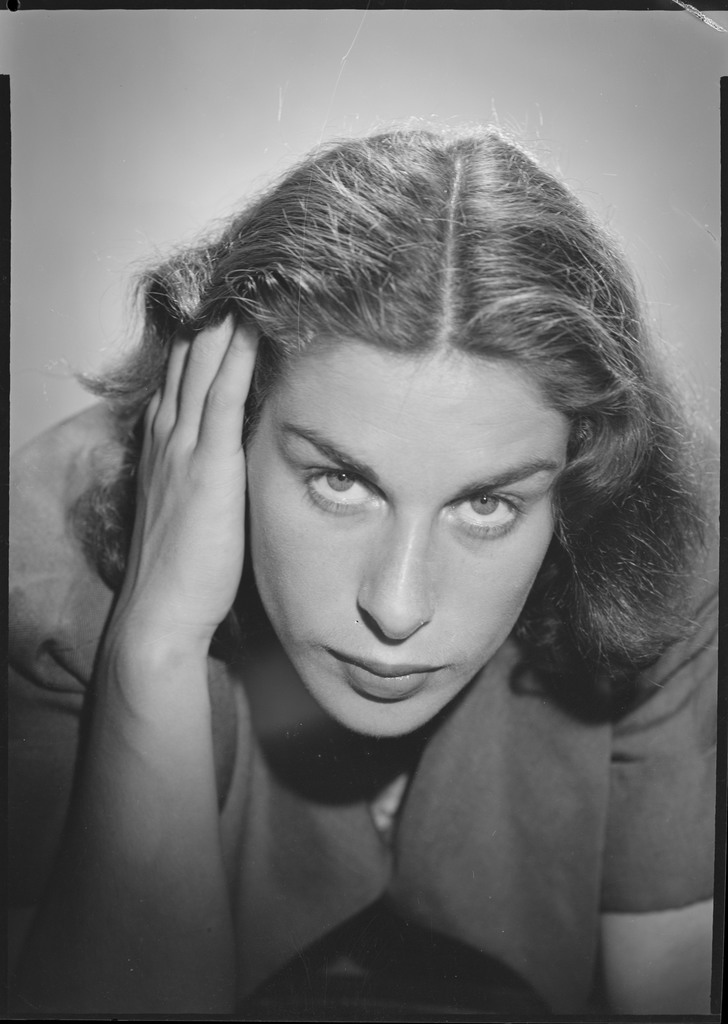
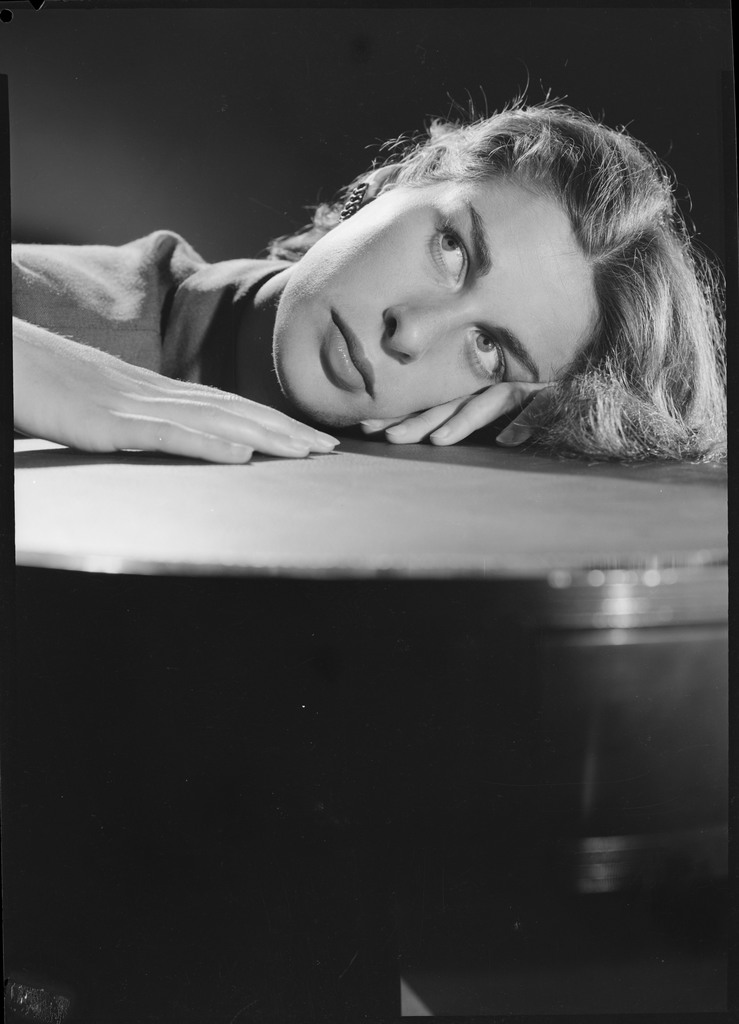
Moira Claux, photographed by Max Dupain - Mitchell Library, State Library of New South Wales
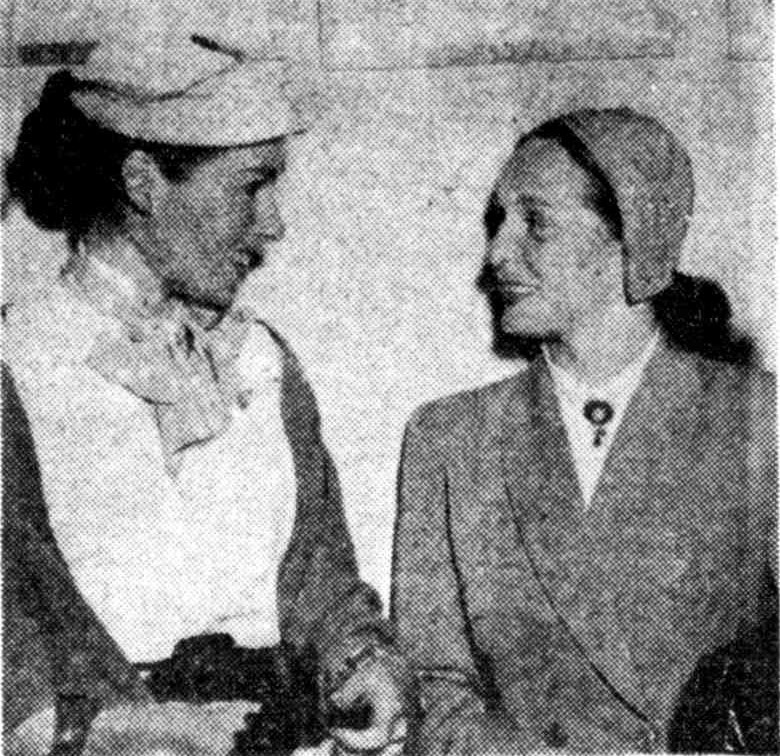
Two of the leading dancers in the Arts Council Ballet group, Moira Claux and Vija Vetra, at the civic reception for the dancers yesterday at the City Hall. No title (1954, March 30). The Newcastle Sun (NSW : 1918 - 1954), p. 10. Retrieved from http://nla.gov.au/nla.news-article161629112
Sydney girl will dance barefoot before the Queen
.jpg?timestamp=1648497487259)
Moira CLAUX, a young Australian who once cleaned telephones for a living, will dance in a Royal Command performance in Sydney next February.
Moira will be on stage -for four and a half minutes before Queen Elizabeth and the Duke of Edinburgh. She will dance the solo role of the Rain Goddess in John Antill's Australian ballet "Corroboree," at the Tivoli Theatre on February 6. Moira dances in bare feet, and prefers choreographed dances to improvising. "But not too strictly choreographed," she said yesterday. "I like to be free enough to interpret the music and put personality into a dance." In intervals when Sydney's limited opportunities for dancing seasons have dried up, Moira has earned money modelling for artists, waiting on tables, working in a frock shop, and in a paper goods factory.
French father
She is a lithe 22-year-old, a modern expressive dancer whose French father, Kleber Claux, brought her up as a nudist. Thickset, blue-eyed Kleber, who has a vast grey beard and wears a shirt and shorts while he runs a nut-stall in Liverpool Street, says that a parent's first duty is to care for a child's physical and mental welfare. Kleber says: "Nudism has kept Moira healthy since she was a baby, and so it has her Honking."
Of Moira's coming appearance before Royalty, he comments: "I don't mind, not a bit. / "It might help her to get other jobs afterwards, and I'm very pleased she is a good dancer."
Moira's London-born mother, who was a dancer herself, took her to a recital by pupils of Madame Bodenweiser when she was nine years old. The following week Moira had her first dancing lesson with Madame Bodenwieser.
"When I was 14 I gave it up because I had a click in my ankle," Moira said. "I tripped over a stone at school one day, and sprained my ankle. "Ever since, the joint clicks quite loudly when I rise on the ball of my foot. "I used to be embarrassed about it, but Madame Bodenwieser persuaded me to take up lessons again. "Now it doesn't worry me much, because an audience can't hear it above the music."
She left Dover Heights Home Science School ("where I took purely academic subjects — I'm not a" domestic type,", she says) in 1947, and became a professional dancer with the Bodenwieser Ballet soon afterwards. Moira has danced around South Africa and India with the Bodenwieser group and twice around New South Wales for the Arts Council, in the past four years. She spends most of her free time on tour sightseeing, because her tour contracts say she cannot "endanger her limbs" by sports such as swimming, climbing or horse-riding. She wants to combine acting with her present stage career, and would like to go abroad. She says she will take marriage "when it comes." "My ideal man must be easy-going congenial and understanding, with artistic appreciation," she says. Sydney girl will dance bare-footed before the Queen (1953, November 15). The Daily Telegraph (Sydney, NSW : 1931 - 1954), p. 29. Retrieved from http://nla.gov.au/nla.news-article248728063
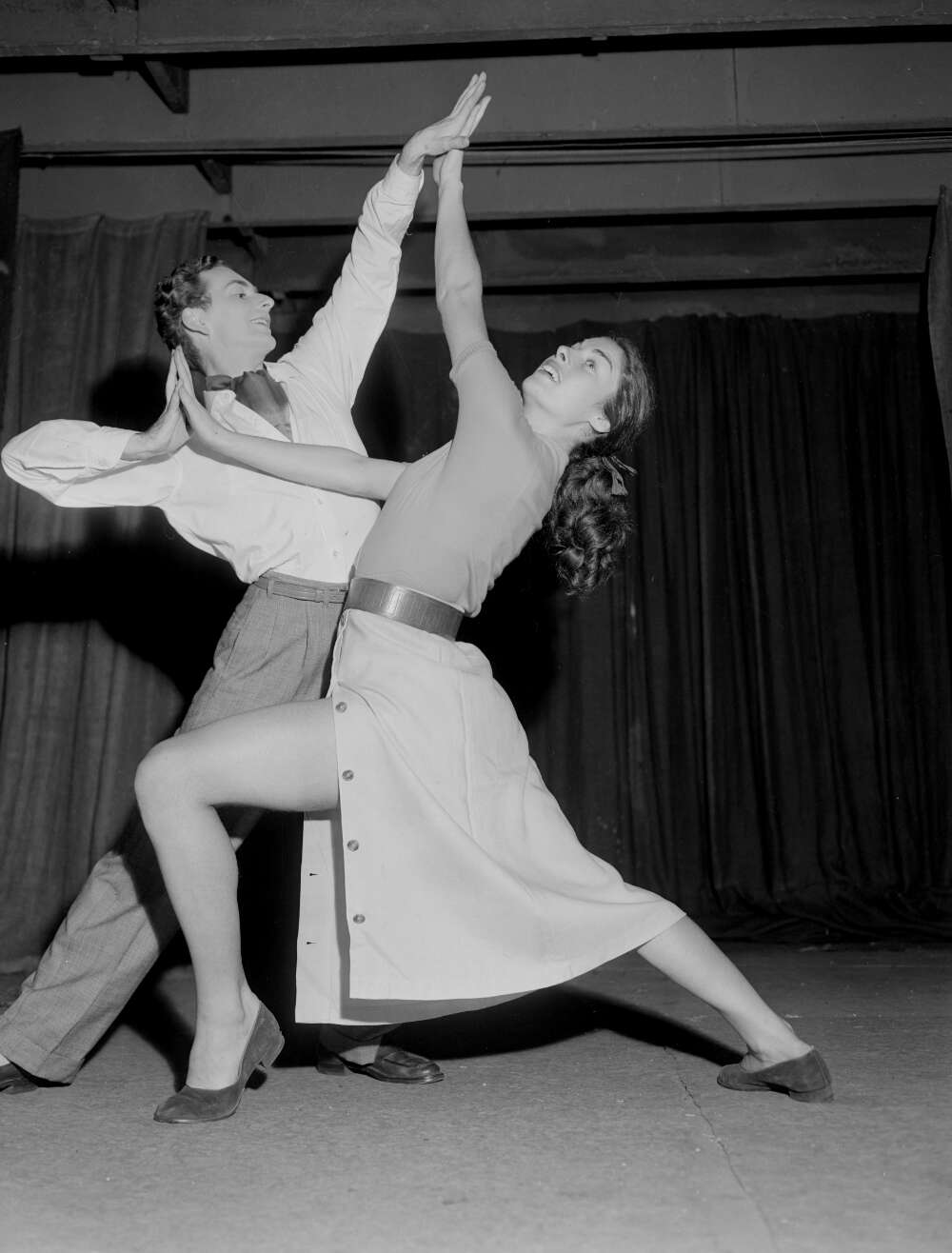
Brindle, Bill & Australian Information Service. (1952). Basil Pattison and Moira Claux in Basil Pattison's 'Modern America', Bodenwieser Ballet Retrieved, from http://nla.gov.au/nla.obj-136992959
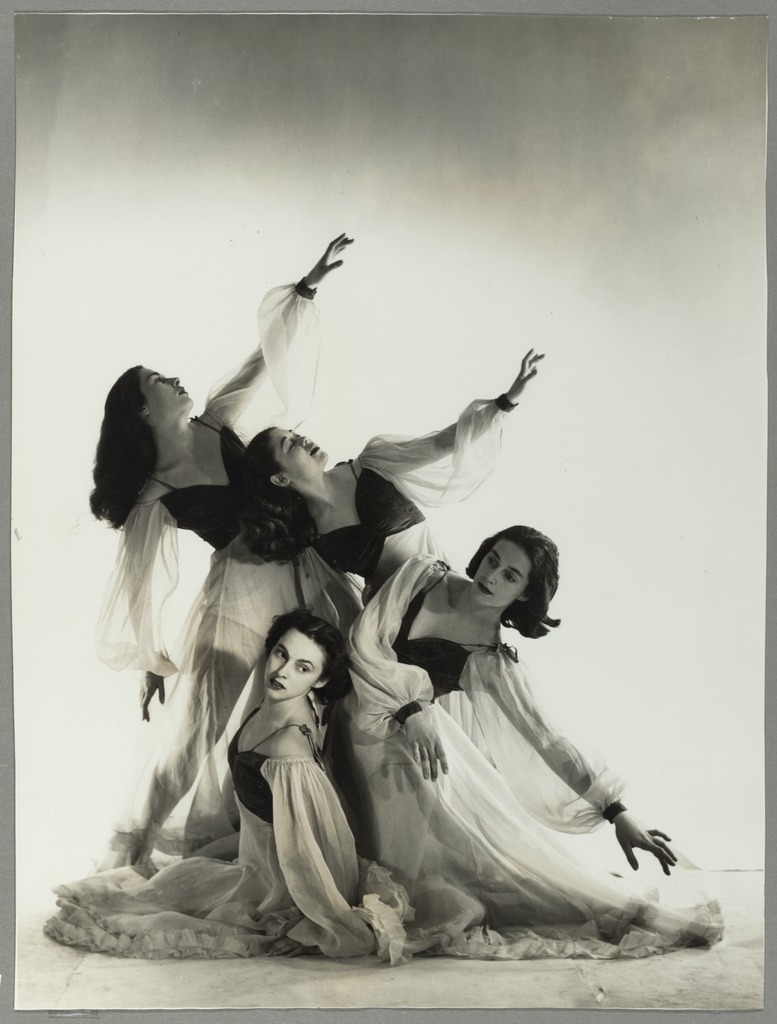
Bodenwieser Ballet performance of Blue Danube Waltz, with Moira Claux, Elaine Vallance, Nina Bascolo and Biruta Apens, 1953. Part of the collection: Papers of Gertrud Bodenwieser.; At rear, left to right: Moira Claux, Elaine Vallance, Nina Bascolo. Front: Biruta Apens.; Also available in an electronic version via the Internet at: nla.gov.au/nla.ms-ms9263-2-5x.
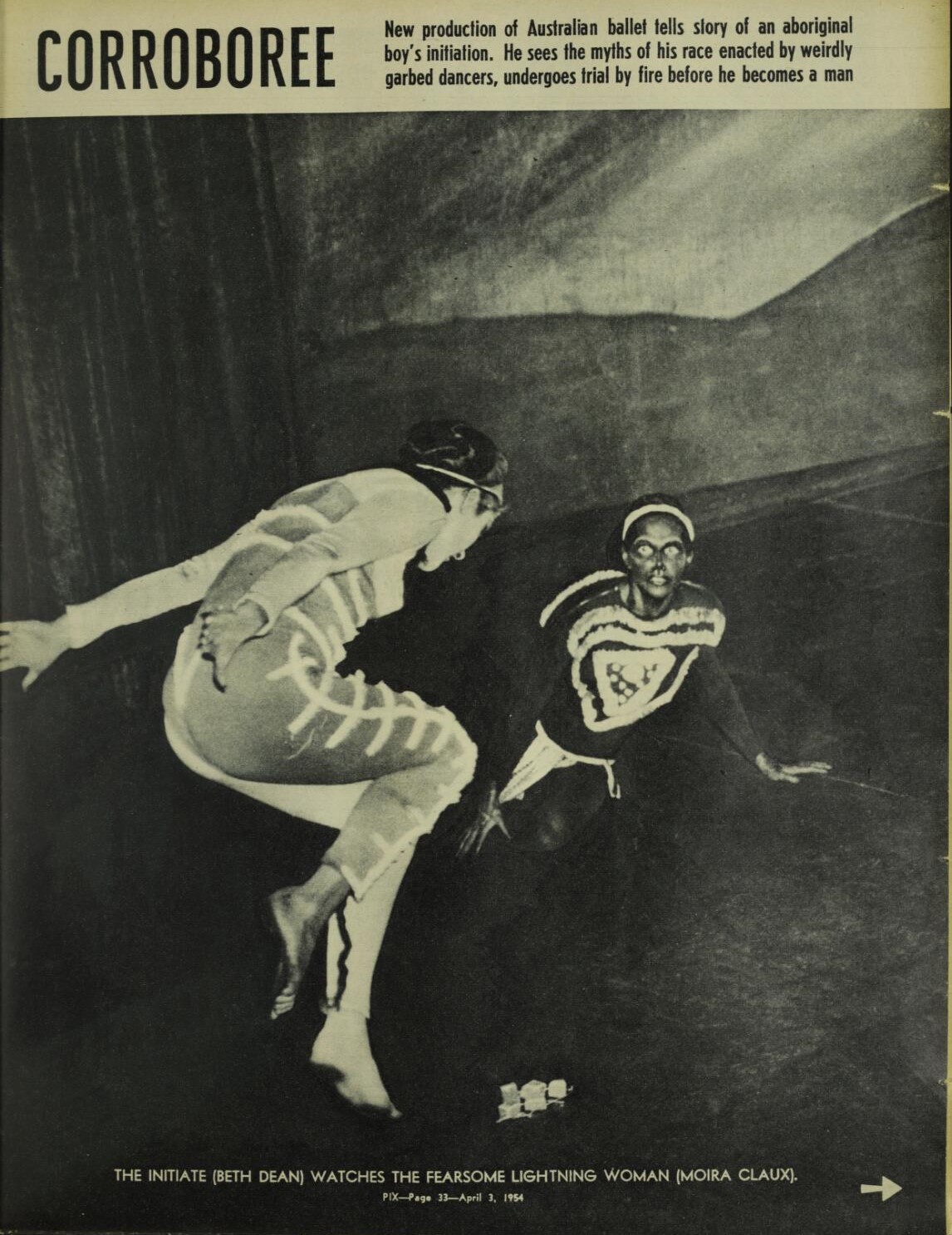
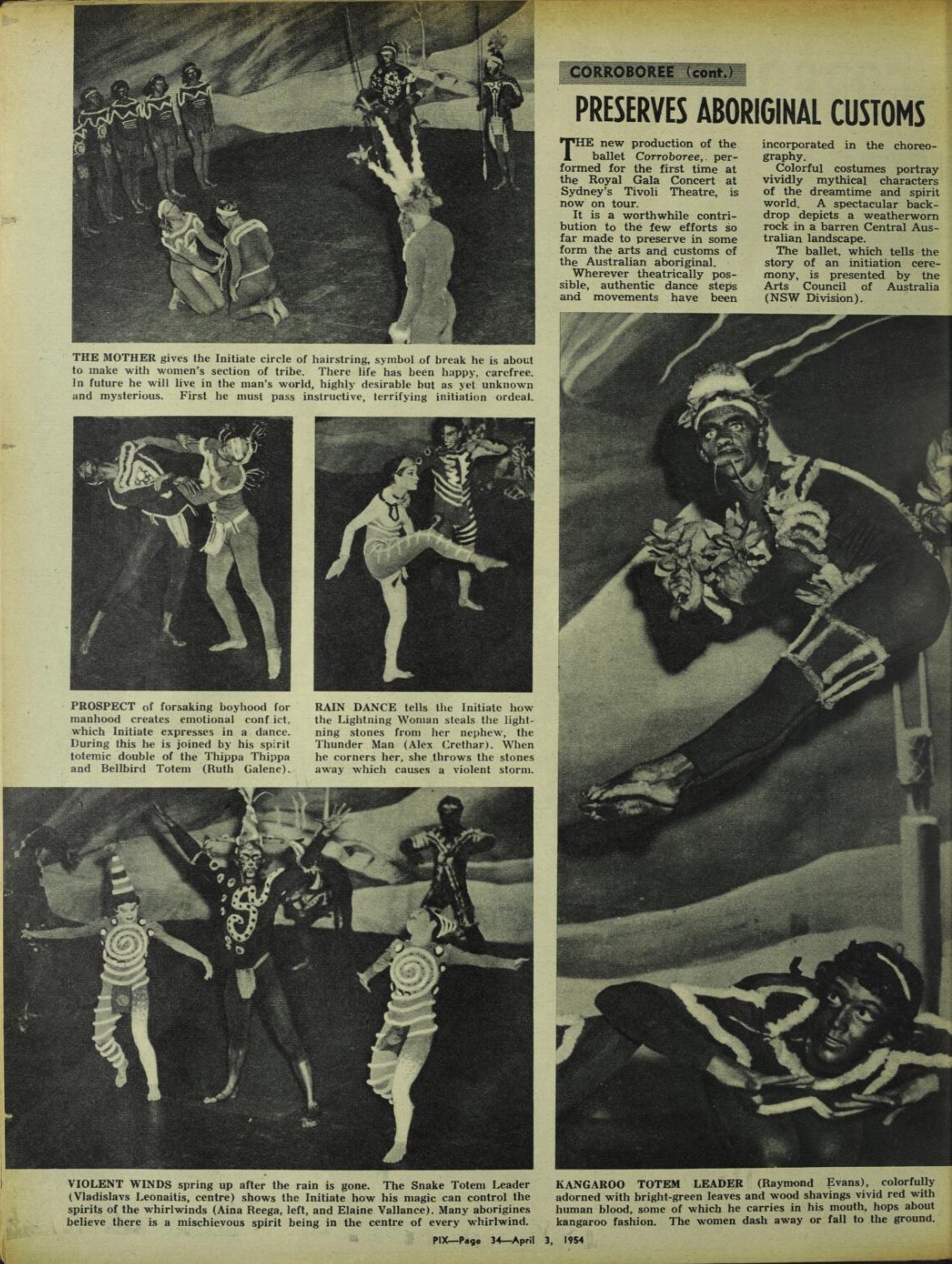
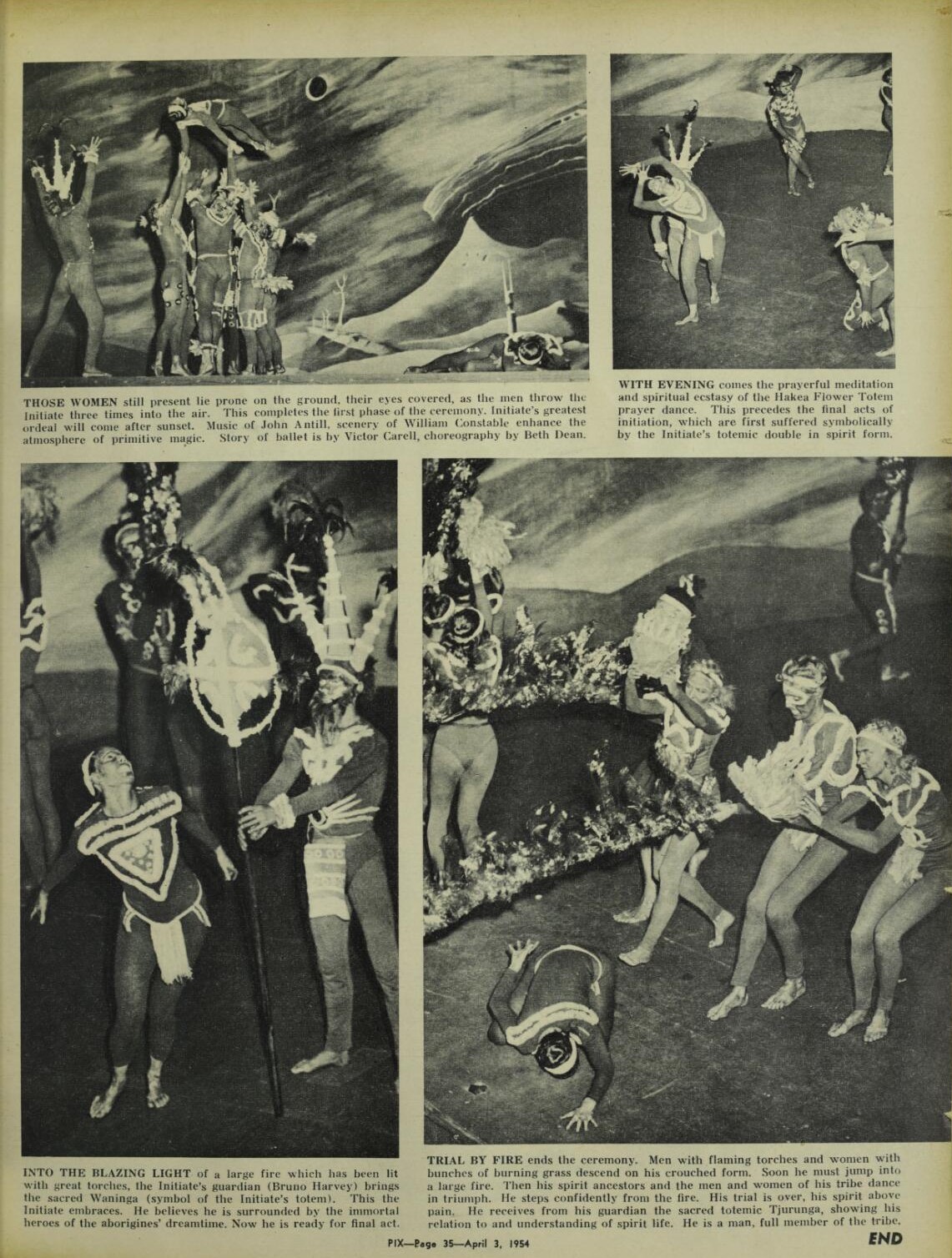
Corroboree': Direct from Royal gala performance before HM Queen Elizabeth and Duke of Edinburgh, Tivoli Theatre, Sydney, 1954 1954 Arts Council of Australia – NSW Division Production of Corrobboree : Pix Vol. 33 No. 4 (3 April 1954) Retrieved from http://nla.gov.au/nla.obj-475772479
ARTS COUNCIL
ALLAN ALDOUS in “Theatre Goes to the Outback” (ABC Weekly, Nov. 6), gives an account of the origin of the Arts Council of Australia’s Mobile Theatre Unit which is completely erroneous. The origin of the Arts Council is as follows:
It was established in 1943 in New South Wales. Later became a Federal body with a division in every State.
The New South Wales division was in receipt of a grant administered through the Council for Adult Education, when in 1950 we approached the Joint Coal Board asking their assistance in acquiring a mobile unit, similar to that in use in Victoria. The Joint Coal Board most generously made us a grant of £7OOO, with which to buy and equip a mobile unit, on condition that we serviced the coal-fields.
The maintenance of the unit is our responsibility. To get started we needed £3OOO, and approached the Rural Bank to ask their help, which resulted in their making us a donation of £3OOO for the first year’s maintenance, on condition that we raised a similar amount for the two ensuing years. The following year the unit was maintained from the profits made from our production in Sydney of the ballet Corroboree.
We have received a yearly grant through the Council for Adult Education over a period of years, which has been increased from time to time. It is at present £6400. As our total yearly expenditure is in the region of £27,000, the balance has to be found by us. We have, as Mr. Aldous points out, exchanged companies with Victoria, and our organisation, together with C.A.E., are able to transport these companies, which helps towards a freer exchange of artists.
Some day we hope that all States will have mobile units and that companies can be passed on in this way from Cairns to Perth.
DOROTHY HELMRICH.
President
The Arts Council of Australia (N.S.W. Division.), Sydney. Australian Broadcasting Commission. ABC weekly Vol. 16 No. 47 (20 November 1954) Retrieved from http://nla.gov.au/nla.obj-1590249671
1955 Arts Council of Australia – NSW Division :
TRAVELLING THEATRE:
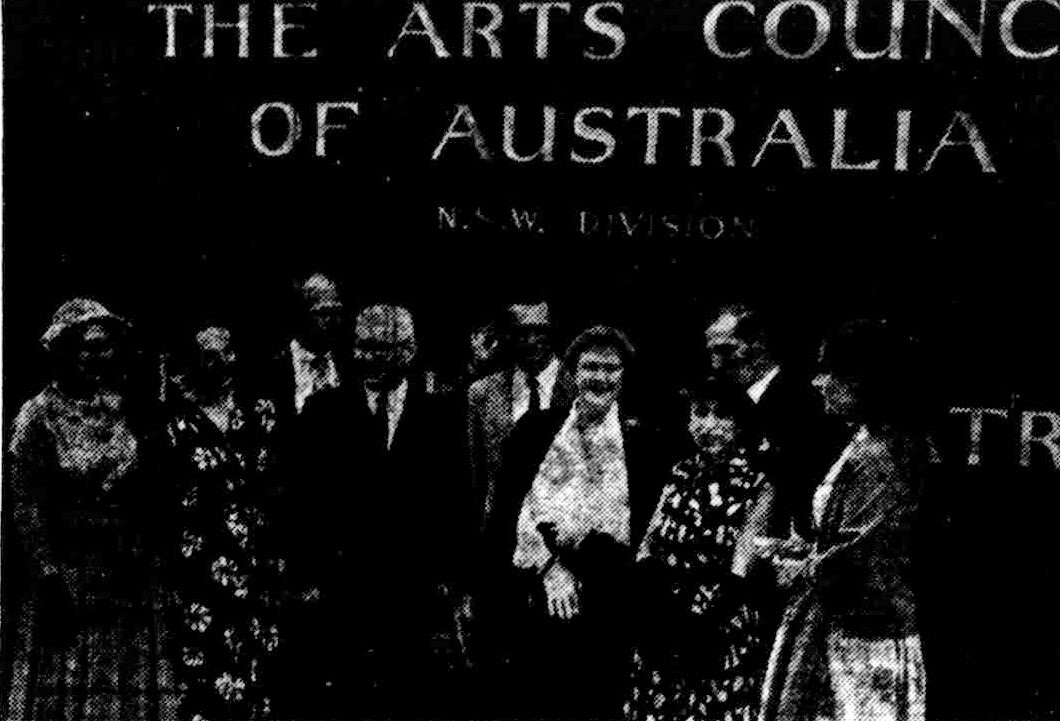
Bernard Shaw's play, Pygmalion, has started its tour of the country areas with the Travelling Theatre Unit organised by the Arts Council of Australia. Members of the . executive and artists from the Independent Theatre Company, who will be presenting the play, gathered informally this week to launch the unit on its 16 week tour. Pictured are Mrs. J. Metcalf, a member of the executive and president of the National Council of Women; Miss V. Vetra, a dancer with the Bodenswieser Ballet Company; Mr. G. Horswell, secretary of the Arts Council; Deputy Premier and Minister for Education, Mr. Heffron; Mr. R. McDougall, stage director; Miss - Dorothy Helmrich, president of the Arts Council; Mr. Hugh Hunt, Director of the Elizabethan Theatre Trust; Madame Gertrude Bodenswieser and Miss Moira Claux from the Bodenswieser Ballet. Country towns to be visited by the unit are Cooma (April 2), Yass (April 4), Goulburn (April 5), Moss Vale (April 6), Wollongong (April 7). The company will return to Sydney over Easter and then tour northern districts around Lithgow and Mudgee and work through the flood areas. They will continue up the north-west, into Southern Queensland, then down the north coast, out the west and south. Advertising (1955, April 1). The Farmer and Settler (Sydney, NSW : 1906 - 1955), p. 23. Retrieved from http://nla.gov.au/nla.news-article117407294
Bruen and Moira had four children: Denise, Eugene, Paul and Janine. Denise Bruna Finey had cerebral palsy and would pass away in 2001, still very young. From soon after her birth her mother and Denise would allow their selves to be the focus of campaigns raising awareness about Cerebral Palsy, advocating for services. The National Library of Australia holds Moira's collection of family papers and photographs, including ''Mrs Bruin Finey nee Moira Claux of Dee Why and her daughter with a physical disability, March 1960 / photographs by Ivan''.
The life of an artist, even when work can be found, still makes for a struggle for those who are not very successful.
SEQUESTRATION ORDERS, FIRST MEETINGS AND PUBLIC EXAMINATIONS.
In the Court of Bankruptcy, District of New South Wales and the Australian Capital Territory.
no. 342 of 1955.—Re Bruen Finey, of Barrenjoey Lighthouse Cottage, Palm Beach.—Summary.
Date of first meeting of creditors—2nd February, 1956, at half-past Eleven a.m., at Official Receiver's Office, Sydney.
Date of public examination—7th March, 1956, at half past Ten a.m., at Bankruptcy Court, Sydney. SEQUESTRATION ORDERS, FIRST MEETINGS AND PUBLIC EXAMINATIONS. (1956, January 12). Commonwealth of Australia Gazette (National : 1901 - 1973), p. 168. Retrieved from http://nla.gov.au/nla.news-article232876320
No. 342 of 1955.—Re Bruen Finey, of Barrenjoey Lighthouse Cottage, Palm Beach.—Summary.
Date of first meeting of creditors—2nd February, 1956, at half-past Eleven a.m., at Official Receiver's Office, Sydney.
Date of public examination—7th March, 1956, at half past Ten a.m., at Bankruptcy Court, Sydney. SEQUESTRATION ORDERS, FIRST MEETINGS AND PUBLIC EXAMINATIONS. (1956, January 12). Commonwealth of Australia Gazette (National : 1901 - 1973), p. 168. Retrieved from http://nla.gov.au/nla.news-article232876320
Commonwealth of Australia.
The Bankruptcy Act 1924-1960.
In the Federal Court of Bankruptcy, Bankruptcy District of the State of New South Wales and the Australian Capital Territory
NOTICE OF APPLICATION FOR ORDER OF DISCHARGE
DEBTOR'S Name—Bruen Finey.
Address—124 Headland-road, Dee Why
Description— Number—S342 of 55
Court—Bankruptcy, 1st Floor, Phillip House, 119 Phillip-street, Sydney.
Date fixed for hearing—26th November, 1962
L G BOHRINGER, Registrar in Bankruptcy
5th October, 1962 3630 Commonwealth of Australia. The Bankruptcy Act 1924-1960. (1962, October 18). Commonwealth of Australia Gazette (National : 1901 - 1973), p. 3694. Retrieved from http://nla.gov.au/nla.news-article241014372
Commonwealth of Australia.
The Bankruptcy Act, 1924-1965.
In the Federal Court of Bankruptcy, Bankruptcy District of the
State of New South Wales and the Australian Capital Territory.
NOTICE OF ORDER OF DISCHARGE.
DEBTOR'S Name—Bruen Finey.
Address—2 Perak-street, Mona Vale, New South Wales, formerly of The Circle, Bilgola Heights, and of Barrenjoey Lighthouse Cottage, Palm Beach. Description—Labourer.
Number—W342 of 1955.
Date of order—26th November, 1962.
Nature of order—Discharge suspended till 24th December, 1962. Ground for refusal of absolute order of discharge—Proof of fact
(a) under Section 119 (7).
L. G. BOHRINGER, Registrar in Bankruptcy. 18th January, 1966. Commonwealth of Australia. The Bankruptcy Act, 1924-1965. (1966, January 27). Commonwealth of Australia Gazette (National : 1901 - 1973), p. 429. Retrieved from http://nla.gov.au/nla.news-article241072192
Bruen Finey seems to have given away sculpture and is well known for making surfboards for Dunlop as well as more boards through is own business ‘Crest Surfboards':
Bruen left the army after 1945 and studied sculpture, funded by an ex-war service grant, and took up working with fibreglass and foam in the 1950s, building chemical vats and shop displays, based in Brookvale where land was cheap and other fibreglass companies were located. He recalled sourcing polyurethane chemicals from a sugar refining company in Waterloo, but couldn’t remember the name. His contract with Dunlop to supply large numbers of boards every week meant hiring itinerant shapers, finishers and polishers. Bruen did all the glassing himself. ‘When the surf was up, no one wanted to work’. Profit was small and output of boards was slow so he decided to develop standard molds and ‘pop-out’ a generic shape. Not surprisingly, this proved a flop as surfers were a ‘fussy breed’ and wanted unique features and characteristics – so decided to sell business to Dunlop, who moved the board making operation to St Mary’s, far from the surf.
Working in Brookvale, on the northern beaches, Bruen remembers Scott Dillon, who sometimes sold him resin, Gordon Woods, a hard working scruffy bloke, Greg McDonagh, who built beautiful boards with clear resin over faultless foam and, or course, Barry Bennett. Bruen rode a large board he made himself although didn’t hang around with surfers who were a ‘close clique’ and didn’t take kindly to outsiders. He mostly surfed around Manly and could take off 40-50 feet outside everyone else and run through the crowd like a tanker. No wonder they cursed him. Big thanks to Bruen for the info and support. Written by Gary Crockett, June 20th, 2011 and retrieved from: http://blogs.hht.net.au/surfcity/?p=2044
Gary Crockett on Dunlop Surfboards Brookvale 1964, posted June 20th, 2011, in the Sydney Living Museums' 'Surf City' exhibition of the same year, relates:
''Just had a great conversation with Bruen Finey, a fibreglass sculptor and manufacturer in Brookvale in the late 1950s and 60s who made surfboards for Dunlop along with his own business ‘Crest Surfboards’ out of a factory in Roger Street. Dunlop distributed his boards far and wide across the state – wherever they had a sports store.
Bruen left the army after 1945 and studied sculpture, funded by an ex-war service grant, and took up working with fibreglass and foam in the 1950s, building chemical vats and shop displays, based in Brookvale where land was cheap and other fibreglass companies were located. He recalled sourcing polyurethane chemicals from a sugar refining company in Waterloo, but couldn’t remember the name.
His contract with Dunlop to supply large numbers of boards every week meant hiring itinerant shapers, finishers and polishers. Bruen did all the glassing himself.
‘When the surf was up, no one wanted to work’.
Pacific Star Surfboard by Dunlop 1964. D Fin Vintage Surfboard out of Roger street Brookvale at the Factory of Crest Surfboards run by Bruen Finey.
Profit was small and output of boards was slow so he decided to develop standard molds and ‘pop-out’ a generic shape. Not surprisingly, this proved a flop as surfers were a ‘fussy breed’ and wanted unique features and characteristics – so [he] decided to sell business to Dunlop, who moved the board making operation to St Mary’s, far from the surf.
Working in Brookvale, on the northern beaches, Bruen remembers Scott Dillon, who sometimes sold him resin, Gordon Woods, a hard working scruffy bloke, Greg McDonagh, who built beautiful boards with clear resin over faultless foam and, or course, Barry Bennett.
Bruen rode a large board he made himself although didn’t hang around with surfers who were a ‘close clique’ and didn’t take kindly to outsiders. He mostly surfed around Manly and could take off 40-50 feet outside everyone else and run through the crowd like a tanker. No wonder they cursed him. Big thanks to Bruen for the info and support.'' Crest Surfboards logo courtesy Surf Research
Crest Surfboards commenced making boards in the early 1960's - the logo opposite has been dated 1962 by Surf Research.
Bruen Finey and Moira Claux separated.
The National Library of Australia holds Moira Claux interviewed by Lee Christofis [sound recording] - Recorded on 6 October 2012 in New Norfolk, Tas.
In 2013:
“Mad Mayors” Damon Thomas and Bertrand Cadart were joined by over 100 guests to re-live the phenomena that was Mad Max at Hobart’s State Theatre on 31 January, on the eve of their inaugural entry in this year’s Targa Wrest Point rally. Hosted by Dave Noonan from Heart 107.3, the Glamorgan Spring Bay Mayor and Hobart Lord Mayor arrived in full race gear for the special screening, held to raise funds for Common Ground. Mayor Bertrand Cadart relived the role he played as Clunk, the crow bar wielding bikie, in Mad Max. He was joined by special guests, Nic Gazzanna, who played Starbuck in the movie, and Moira Claux who featured in Mad Max 2. Interviews with the stars and the film screening were followed by a roof top supper and live entertainment. - https://www.lgat.tas.gov.au/__data/assets/pdf_file/0020/322067/9-March-2013-Tourism-and-Events.pdf
Moira and Bruen eventually split up - they had never married so no divorce occurred. Moira was then with an ex Air Force man, John Morgan. She lived in Queensland for a wheil and moved to Tasmania in 2011/2012.
A few years ago this Tribute Notice was published in Hobart's The Mercury newspaper:
CLAUX, Moira Vivenne.
Passed away May 8, 2017.
Loving mother to Denise (dec), Eugene, Paul and Janine. Grandchildren Rick, Stuart and Ryan.
We'll miss you. Lived a full and exciting life.
Keep on dancing.
Date listed: 10/5/2017
Publication: The Mercury
Bruen Finey passed away on November 10th, 2014, aged 91. He was interred at the Northern Suburbs Memorial Gardens and Crematorium.
The gentleman he had been working with prior to going into surfboard manufacture was Paul Beadle (1917-1992), sculptor, drawing, painter. Beadle was born in England and studied at the Cambridge Art School and the Central School of Arts and Crafts during the 1930s. He arrived in Australia in 1944 and became known for his 'bronzetti' satirising history, literature and politics. He taught at the NAS for four years before becoming head of the Newcastle Art School in 1952; later he was principal of the South Australian School of Art for two years. Beadle made the 11-metre high eagle and sphere surmounting the Australian-American Memorial at Canberra's Russell Offices, which was completed at a cost of 100 000 pounds (much of it raised by public subscription) in early 1954. In 1961 he moved to Auckland to take up the position of Chair of Fine Arts at the University's Elam school. In 1969 he exhibited at the Bonython Galleries in Sydney as well as in Adelaide and Auckland; up to the mid-seventies he showed at Australian Galleries in Melbourne.
Drawings By Beadle and Missingham
BY OUR ART CRITIC.
Hal Missingham and Paul Beadle are holding an interesting joint exhibition of drawings at the Macquarie Galleries. Unlike so many artists here, they recognise that drawing, like painting, is only another medium of art, and that in their presentation we discern the quality of mind of the artists. It is a severe test, and Beadle is perhaps less afraid to court an occasional failure, while Missingham is too much inclined to seek refuge in a fluent decorativeness. The artist who is noncommital cannot hope to leave an impression.
At times the conventions he employs, as in "Ice Skater," "Odd Dogs," "Soldier at L.T.D.," and "Sanatorium Siding," stray into those thoughtless mannerisms which make up the world of commercial "art. Yet in a work like "On the Ferry," , he reveals a delicate and unexpected charm of feeling and of observation.
Beadle's generally attempt a more solid interpretation, and "Leading Seaman Simpson," "Torpedoman," and "Seamen's Mess," possess a certain power. He is inclined, however, to shade and state details without absorbing them into the larger forms of his subject matter. He lacks also the imagination of the other artist.
Both are too anxious to show a "beautiful" or "interesting" finish, and , forget that the crudities of earnest struggle which finally has something to say is infinitely preferable.The exhibition will be opened by Captain Anthony Kimmins, R.N.. at 1.30 p.m. to-day. Drawings By Beadle and Missingham (1945, October 24). The Sydney Morning Herald (NSW : 1842 - 1954), p. 5. Retrieved from http://nla.gov.au/nla.news-article17957387
Beadle Resigns From Art Gallery Project
Mr. Paul Beadle, Chief Art Instructor at Newcastle Technical College, advised the Lord Mayor (Aid. Purdue) yesterday that he had resigned from tile Cultural Centre art committee "as a protest against a ludicrous situation that would end in tragedy for the proposed Art Gallery."
The Lord Mayor is President of the Cultural Centre executive. Mr. Beadle said that at the last meeting of the art sub-committee an Art Gallery Commission of Inquiry was named. It was his idea that the commission would have personal dealings with art gallery administration at the principal galleries in Australia and obtain data from galleries overseas. If the proposed gallery was to make a name for itself as one of high standing its foundations should be laid by people with wide knowledge and experience Who could talk on a common level with the expert gallery administrators with whom they must make contact. At the sub-committee meeting, which was attended by four other members besides himself, no nomination he made was seconded, Mr. Beadle said. Personal attacks were repeatedly made against him after each nomination. He was attacked on the grounds of
- Interference in the civic and artistic life of the community.
- Inviting well dressed women with double-barrelled names from The Hill to art exhibitions which he had conducted or for which he was associated.
- Publicity seeking.
- Nominating personal friends to gain control of the art gallery.
Keen On Centre
Mr. Beadle told the Lord Mayor that since he came to Newcastle he had had but one aim--to be of service to the community in the field in which he worked. He would not abandon that aim, but he could no longer waste his time as a member of the sub-committee. "All my thoughts have been directed toward the establishment of the finest small gallery in Australia," he said. "Before the last meeting of the sub-committee I felt the Newcastle Council and the Cultural Centre Committee had every opportunity to achieve such an establishment.
"From both the personal and professional point of view it is not to be expected that would submit myself to further abuse from the members of this sub-committee. "It is with great regret that I am forced to withdraw, for I have the aims of the Cultural Centre very much at heart."
Proposed Panel
The proposed commission to be recommended by the subcommittee to the full executive of the Cultural Centre is:
"Financial expert," Ald. McDougall; "member who should he well-known citizen with high executive experience and a personal appreciation of art," Mr. Warwick Johnson; "men has with expert knowledge and personal experience of the establishment of a similar local government institution in Newcastle," Mr. J. G. D. McNeill; "member with the widest possible expert knowledge and experience of all aspects of art," Mr. T. Ninness; "member selected by the sub-committee at its discretion as secretary," Mr. J. Punshon.
A representative from Newcastle Art Society has still to be chosen. The Lord Mayor said he was sorry to learn Mr. Beadle thought it necessary to resign from the sub-committee. He had not yet seen any recommendation on the personnel of the proposed Art Gallery Commission, which apparently would be submitted to the next meeting of the executive, so he was unable to ex press an opinion on the suitability or otherwise of the nominations. Whatever the decision Mr. Beadle ultimately made he hoped they could continue to have the benefit of Its advice and help, even if only on an unofficial basis. Beadle Resigns From Art Gallery Project (1954, November 5). Newcastle Morning Herald and Miners' Advocate (NSW : 1876 - 1954), p. 2. Retrieved from http://nla.gov.au/nla.news-article134097720
Joseph Collinridge Rivett
Born January 7, 1923 at Morrinsville, New Zealand to Anthony and Martha, Joseph Collinridge Anthony Rivett, known as 'Collin' came to Sydney as a child. He was the youngest of five children; Eileen Josephine Rivett 1913 – 1997, Martha Elizabeth 'Belsey' Rivett 1912 - 1971, Anthony Stephen 'Steve' Rivett 1916 - 1996, John Joseph 'Jack' (Rev Father) Rivett 1918 - 2008, Joseph Collinridge Anthony Rivett 1923 – 2008
Anthony Joseph 'Tony' Rivett (1884 - 1946) was born in Stratford Essex England on January 1st 1884 to Lewis Collinridge Rivett and Elizabeth Susannah 'Lotty' Farmer. Anthony Joseph 'Tony' Rivett had 5 children. He passed away on July 17th 1946 in Parramatta NSW AUST (Parramatta Hospital) (61y.)
Collin's parents were in the hospitality business, an industry that was not without hurdles during the Depression in Australia years of the 1930's at a premises that had been going for a while prior to that. Set up as Fay's Corner at Pitt and Liverpool Sts, Sydney in 1913 this was one of the stores Edward Fay Ltd (Fay's Footwear) boasted as the largest shoe store in the Commonwealth.
Edward Fay (1856 - 1914) in 1875 was a bootmaker in Ann St, Balmain. In 1883 had moved to Darling St. In 1900 was a 'boot importer' at 385/7 Pitt St, Sydney. 1913 directory lists Edward Fay Ltd. Boot Manufacturers & Importers, 385 Pitt St, Sydney.
FUNERAL OF MR. E. FAY.
The death occurred at his residences, Bannockburn, Punch-street, Mosman, on Wednesday morning, of Mr. Edward Fay, the managing director of Edward Fay, Ltd., boot merchants. Deceased was 67 years of age.
Mr. Fay was born at Balmain. When a young man he entered the service of John Hunter and Co., in which he remained for 15 years. Eighteen years ago he decided to launch out for himself, and started a small shop on the site of the present premise of the firm. The business grew steadily, till it reached its present large proportions. Two and a half years ago, chiefly on account of failing health, Mr. Fay formed the business into a limited liability company, becoming managing director.
The late Mr Fay is survived by a widow, four daughters, and one son.
The interment took place in the Presbyterian section of the Gore Hill Cemetery on Thursday. The Rev. James Lamont read the burial service. The chief mourners were Master Edward Fay (son). Messrs T. Fay, J. Fay (brothers): Roy Fay, N Sinden, A Denning, W. Denning, T. Reeks, J. Clements, J. Day, C. Spencer, S. Ravenscroft, R. Clements, H. Clements. The representatives of the firm were Messrs. J. Farram, A. A. Jenkin (directors), J. McIntosh, J. Wallace, A. Boys. J. Caldwell, H. Rhodes, and others of the staff.
There were also present Messrs. W. H. Cordeaux, T. Kennedy, T. Routley, J. Leslie (Boot Manufacturers' Association). E. E. Sayers, H. Meyer, J. A. Day, T. Hicks, S, J. Carruthers, J. Wallace, A. H. Norman, A. Cropley, J. KcKinley, W. Louden, A. Hickey, A. McCabe, W. H. White, J Matthews, G. H. Taubman. A. T. Leslie, G. Phillips, S. Harper, H. Weekes, F. Gardiner, J. McKeown, H. Mortley, H. Wolff, J. F. Barrington, J. Larbalestier, W. Carter, Robinson, H. Clements. H. Carey, T. McGillwray, H. Barton, E. Heesch, G. Taylor, C. Dadswell, C. Murphy, W. F. Dobbin, H. Klein, G. Bell, S. Munis, M. Hughson, A. Tyler, W. Earle, A. Wise, J. Middleton, C. Fisher, J. Stedman. J. Stedman. W. Dickson, W. A. Grant, W. H. Stanton, E. Burke, W. James, G. H. Watson, J. Burt, J. Shaw, T. McLachlan.
"In 1875 was a bootmaker in Ann St, Balmain. In 1883 had moved to Darling St. In 1900 was a 'boot importer' at 385/7 Pitt St, Sydney. 1913 directory lists Edward Fay Ltd. Boot Manufacturers & Importers, 385 Pitt St, Sydney."FUNERAL OF MR. E. FAY. (1914, January 24). The Sydney Morning Herald (NSW : 1842 - 1954), p. 23. Retrieved from http://nla.gov.au/nla.news-article28120734
Some notes from the papers:
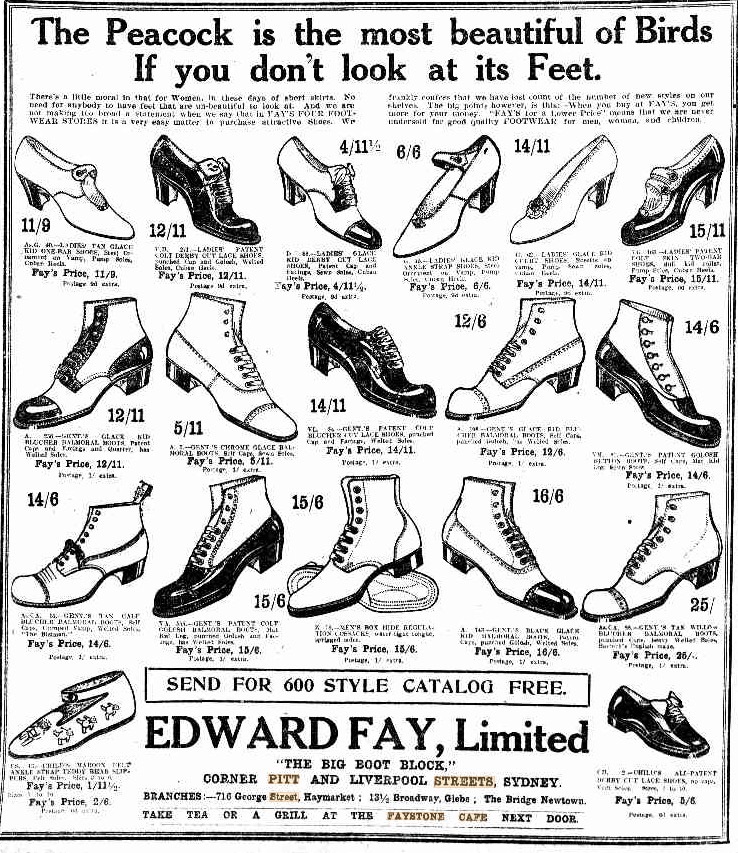
Advertising (1915, June 2). The Daily Telegraph (Sydney, NSW : 1883 - 1930), p. 12. Retrieved from http://nla.gov.au/nla.news-article239038556
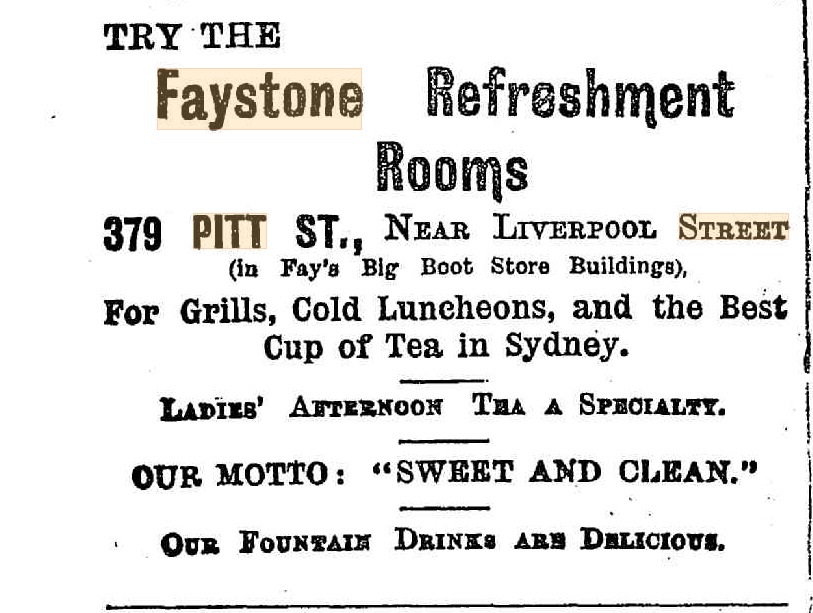
Advertising (1916, March 9). Freeman's Journal (Sydney, NSW : 1850 - 1932), p. 33. Retrieved from http://nla.gov.au/nla.news-article115307253
LAW REPORT - IN BANKRUPTCY.
Before Mr. Justice Lukin.
'RESERVED' JUDGMENTS.
His Honor delivered the following reserved Judgments: APPLICATION DISMISSED.
Re A. and M. Rivett, ex parte Edward Fay, Ltd.
His Honor said that It was an application by the debtors to set aside a bankruptcy notice, Issued at the instance of the respondent company on a judgment for a sum of £223/5/ in its favour, on the ground that the debtors had a counter-claim, set-off, or cross-demand for £3000 damages for alleged fraudulent misrepresentation by the company or Its servants of the takings of a business known as the Faystone Cafe, whereby the company Induced the debtors to execute In its favour a certain hire purchase agreement and a memorandum of lease. There was no motion or application filed, the matter being brought before the Court by the filing of an affidavit which, under rules 139 (2) and 140, operated as an application to set aside the bankruptcy notice. It appeared that one George Wootton carried on the business of a restaurant keeper at Faystone Cafe, and was paying a rental of £27 per week for the premises; that the debtors, Anthony Rivett and his wife, Martha Rivett, after Interviewing Mr. Wootton and a director of the respondent company, entered into a hire purchase agreement for the plant of the business, on the terms of paying £6 per week, with the right of purchase for £450. Having regard to the contents of the documents and the nature of the evidence offered to show him a prima facie case to establish the alleged fraud. His Honor doubted the debtors' bona fides. There was no evidence to show him that there was a reasonable ground for instituting such an action. It was "shadowy," and, in his opinion, not one that the debtors could fairly litigate. They had, in any event, not satisfied him that they had a counter-claim, setoff, or cross-demand which equalled or exceeded the amount of the judgment debt. His Honor refused to set aside the bankruptcy notice. The application would be dismissed, with costs, including the cost of the short-hand writer. Mr. H. J. Studdert (instructed by Mr. J. A. Meagher) for the applicant debtors; and Mr. Maxwell, K.C., Mr. E. F. McDonald, and Mr.-H. A. Henry (instructed by Messrs. Allen,] Allen, and Hemsley), for Edward Fay, Ltd. LAW REPORT. (1932, October 1). The Sydney Morning Herald (NSW : 1842 - 1954), p. 10. Retrieved from http://nla.gov.au/nla.news-article16906892
Re Anthony Joseph Rivett and Martha Rivett, his wife, of Faystone Cafe, 379 Pitt street, Sydney. Petitioner, Edward Fay. Ltd. To be heard October 20. IN BANKRUPTCY. (1932, October 13). The Sydney Morning Herald (NSW : 1842 - 1954), p. 6. Retrieved from http://nla.gov.au/nla.news-article16919638
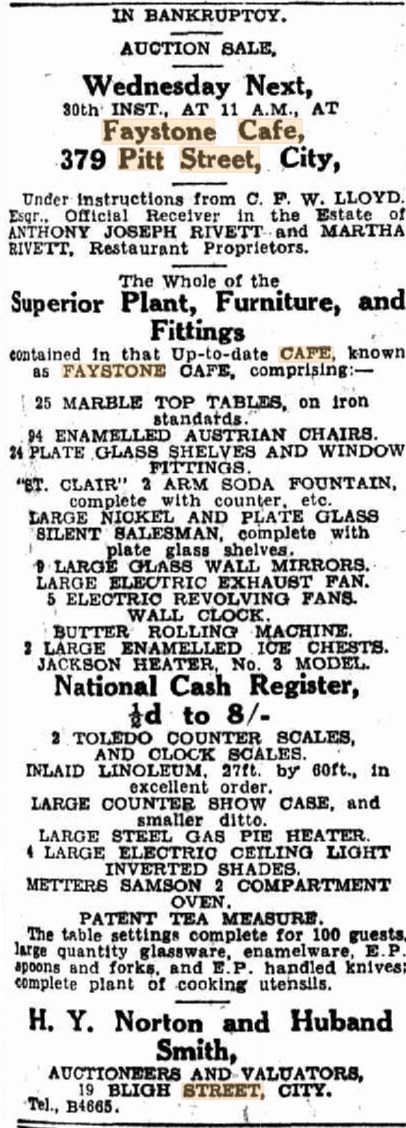
Advertising (1932, November 24). The Daily Telegraph (Sydney, NSW : 1931 - 1954), p. 13. Retrieved from http://nla.gov.au/nla.news-article247310894
PUBLIC EXAMINATION.
Re Anthony Joseph Rivett and Martha Rivett. Mr. O'Shea for creditor. Mr. De Coek for bankrupt. Concluded. IN BANKRUPTCY. (1932, December 7). The Sydney Morning Herald (NSW : 1842 - 1954), p. 8. Retrieved from http://nla.gov.au/nla.news-article16936049
ORDER OF DISCHARGE.
DEBTOR'S Name—Anthony Joseph Rivett (separate estate). Address—69b Francis-street, Bondi, formerly of 343 Old South Head-road, Bondi, and carrying on business at "Faystone Cafe", 379 Pitt-street, Sydney, in partnership with Martha Rivett. Description—Restaurant proprietor. Court—Bankruptcy. Number—S.279 of 1932. Date and nature of order—18th July, 1933; discharge unconditional. 8479 N. C. LOCKHART, Registrar. ORDER OF DISCHARGE. (1933, September 21). Commonwealth of Australia Gazette (National : 1901 - 1973), p. 1345. Retrieved from http://nla.gov.au/nla.news-article232609004
Re Martha Rivett and Anthony Joseph Rivett and in the separate estate of Martha Rivett Discharge order granted Mr De Coek of Messrs J A Meagher and De Coek for Martha Rivett. LAW REPORT. (1939, January 14). The Sydney Morning Herald (NSW : 1842 - 1954), p. 5. Retrieved from http://nla.gov.au/nla.news-article17547300
Soon after they opened the highly successful Waratah Cafe at Parramatta - this became the venue for weddings and other events:
THE WARATAH CAFE MUCH TRAVELLED PROPRIETOR
If experience through travel counts for anything, then Mr. Rivett is certainly qualified to conduct one of Parramatta's leading cafes-the Waratah. Mr. Rivett had a good schooling in the restaurant business and the art of the chef at "Elliott's Mansion House" and the "Guild Hall Caterers,"-London. This schooling was supplemented by a wide experience in such prominent centres as' Margate, Brighton, Dieppe, and Boulgigne. A desire to see the world eventually found him the successful contractor for the catering on the new railroad running from Benguella in Central Africa. From there Mr. Rivett found his way to Trentham, New Zealand, as a member of the staff on the occasion of Earl Kitchener’s military mission. He went back to England and by a strange piece of luck his' profession was the means of securing for him a privileged visit to the historic Isle of Elba before he again returned to New Zealand. Here he built and opened, at a cost of £10,000, one of the show restaurants of the Dominion.
Disposing of this investment, he journeyed to Sydney and went into business in Pitt Street.
Prior to his recent arrival in Parramatta, he was two years out West.
Mr. Rivett's opinion; after all this globe trotting, all things being equal, is that Parramatta's district is as good as anywhere else in the world, and to back this statement up, he has acquired a property in Carlingford and intends to finally settle here. The Waratah Cafe is receiving the full benefit of all Mr Rivett a experience, and it is well worth your while to go along and avail yourself of the excellent, service. You know, the restaurants and cafes of a town constitute one of the main features on which visitors base their opinions of that town. On entering a strange town, most people' look around for a comfortable congenial cafes in which to satisfy their appetites. The service at the Waratah Cafe is one that is likely to impress anyone very favorably, as it has said to have done for the 21st Field Brigade, who make it their regular dining place. THE WARATAH CAFE (1940, October 9). The Cumberland Argus and Fruitgrowers Advocate (Parramatta, NSW : 1888 - 1950), p. 12. Retrieved from http://nla.gov.au/nla.news-article106207875
Anthony Rivett passed away in the winter of 1946:
RIVETT.–July 17, 1946 at Parramatta Hospital, Anthony Joseph Rivett, of 12 Hunter Street, Parramatta and formerly of Morrinsville, New Zealand, beloved husband of Martha and dear father of Belsey, Eileen, Anthony, John and Joseph aged 62 years. Requiescat in pace. New Zealand papers please copy. Family Notices (1946, July 18). The Sydney Morning Herald (NSW : 1842 - 1954), p. 16. Retrieved from http://nla.gov.au/nla.news-article17979221
Mr. Anthony Joseph Rivett (62), of Hunter Street, Parramatta, died at the Parramatta District Hospital last Wednesday. He leaves a widow, three sons and two daughters. The funeral left St.Patrick's Church Parramatta for the Catholic Cemetery, North Rocks.. Arrangements were in the hands of Charles Innes and Son, Parramatta. Obituary (1946, July 24). The Cumberland Argus and Fruitgrowers Advocate (Parramatta, NSW : 1888 - 1950), p. 5. Retrieved from http://nla.gov.au/nla.news-article105741598
Collinridge enlisted at Parramatta to serve in WWII, Service Number - N191494, and afterwards enlisted at the East Sydney Tech (Arts School).
He married another Artist in 1949:
ENGAGEMENTS
RIVETT - McKENZIE-Muriel Esma, eldest daughter of Mr. and Mrs. Kenneth McKenzie, of Baulkham Hills, to Joseph Collinridge, youngest son of the late Anthony Joseph Rivett and Mrs. Martha M. Rivett, of Carlingford, N.S.W. Family Notices (1948, December 21). The Sydney Morning Herald (NSW : 1842 - 1954), p. 14. Retrieved from http://nla.gov.au/nla.news-article18096265
A PPROACHING MARRIAGES
RIVETT—McKENZIE.—The Marriage will take place at Holy Name Mary, Rydalmere, 7 p.m., Monday, January 17, by Rev. Father Dempsey, of Joseph Collinridge, youngest son of Mrs. Martha Rivett, to Muriel Esma, eldest daughter of Mr. and Mrs. Kenneth McKenzie. Family Notices (1949, January 13). The Sydney Morning Herald (NSW : 1842 - 1954), p. 18. Retrieved from http://nla.gov.au/nla.news-article18098089
Miss Muriel Esma McKenzie, daughter of Mr. and Mrs. K. McKenzie, of Baulkham Hills, chose powder blue silk for her ballerina-length wedding dress when she was married on January 10 to Mr. Joseph Collinridge Rivett, youngest son of Mrs. M. Rivett and the late Mr. A. J. Rivett, of Carlingford.
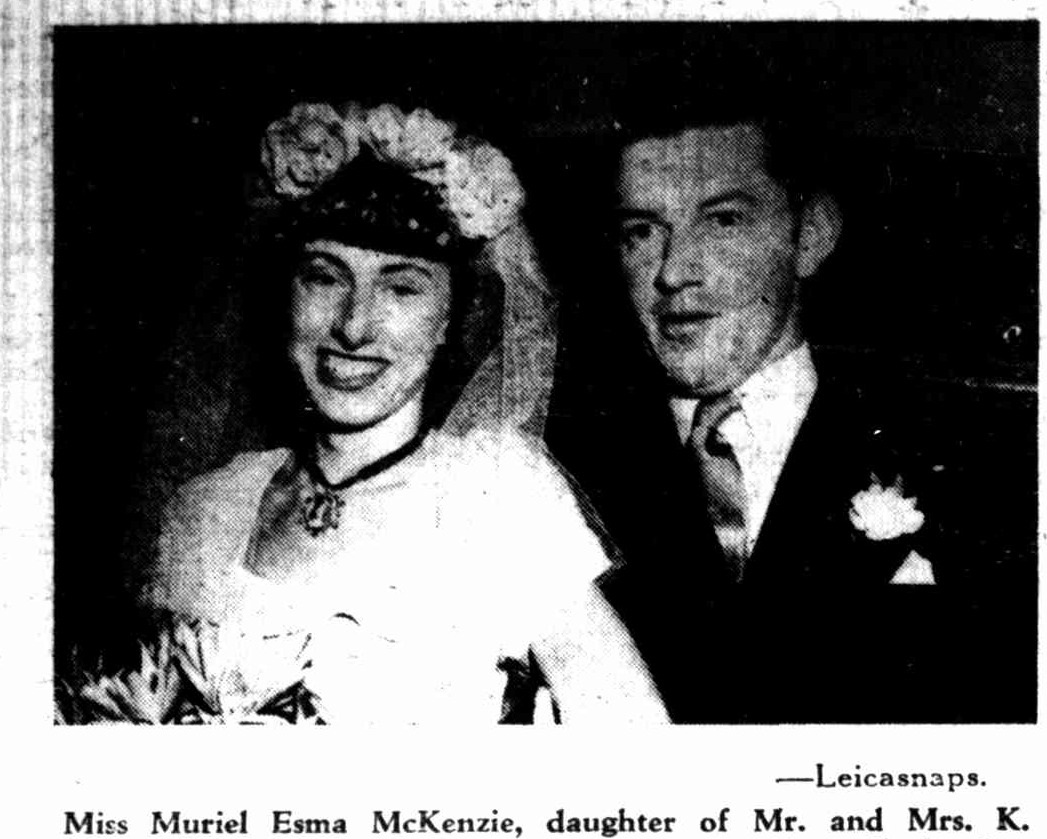
The bride's gown was made with a well-fitting bodice, cape sleeves and a full skirt, her elbow length veil being held in place with a dainty cyclamen-coloured topknot that matched her bouquet. The bridesmaid was the bride's sister, Miss Pauline. McKenzie, whose golden-fawn frock was also made in ballerina style. She carried a bouquet of blue water lilies and wore golden net across her hair with a little rose at one side. Best man was the bridegroom's brother, Mr. John. Rivett, the ceremony being performed at the Holy Name of Mary Church, Rydalmere, by Fr. Dempsey. Miss Belsey Rivett, the bridegroom’s sister, was responsible for the beautiful decorations of belladonna lilies and gladioli which adorned the church altar as well as for those at the Waratah, Parramatta, where a few friends were entertained after the ceremony. Mrs. Rivett wore a cyclamen floral silk gown for the occasion with a lovely little cloche hat of blue and cyclamen feathers, Miss Belsey Rivett's frock being of grey American jersey silk patterned with American Beauty roses. Mrs.. McKenzie's frock was of dusty-pink silk 'with white accessories. For a wedding present Mr. Rivett gave his bride a glorious unset diamond. The couple will make their home at Carlingford. No Title (1949, January 26). The Cumberland Argus and Fruitgrowers Advocate (Parramatta, NSW : 1888 - 1950), p. 6. Retrieved from http://nla.gov.au/nla.news-article111530803
AT the Church of the Holy Name of Mary, Rydalmere, the Rev. Father P. J. Dempsey, P.P., officiated at the marriage of Joseph Collinridge, youngest son of Mrs. M. Rivett, of Parramatta, and the late Mr. A. Rivett, and Muriel Esma, eldest daughter of Mr. and Mrs. Kenneth McKenzie, of Baulkham Hills. The bride's sister, Pauline, was bridesmaid, and best man the groom's eldest brother, John Joseph Rivett. Among the many congratulatory messages received by the young couple was a cable from the groom's aunt, Sister Mary Agnes, of the Order of Poor Clares, England. Mr. and Mrs. Rivett spent a month's honeymoon up north, and will live at 'Carlingford Lodge,' Carlingford. No title (1949, March 10). Catholic Weekly (Sydney, NSW : 1942 - 1954), p. 1 (PAGES FOR WOMEN). Retrieved from http://nla.gov.au/nla.news-article146661998
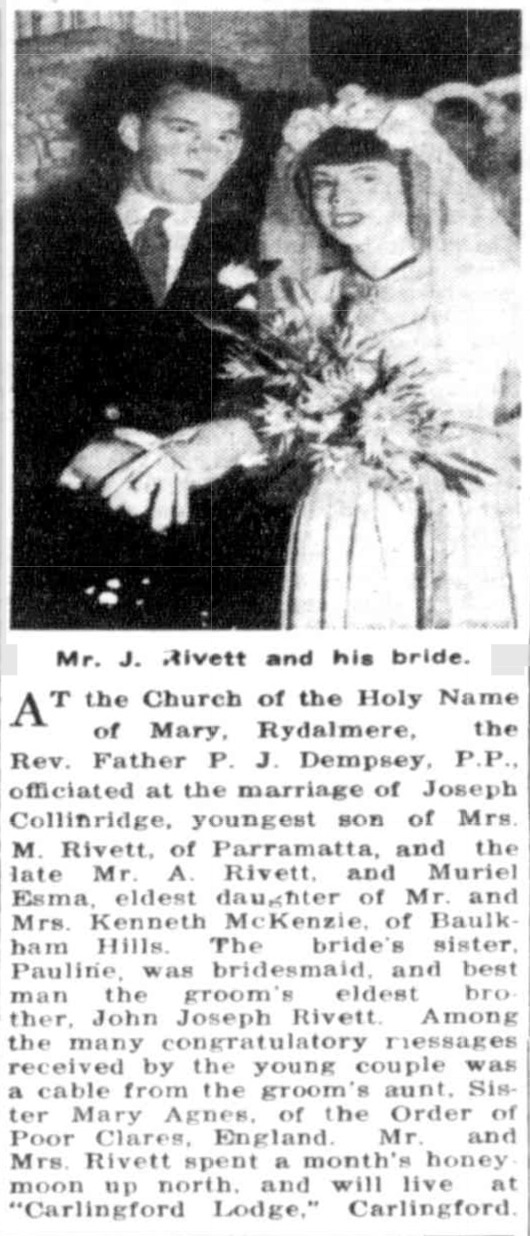
No title (1949, March 10). Catholic Weekly (Sydney, NSW : 1942 - 1954), p. 1 (PAGES FOR WOMEN). Retrieved from http://nla.gov.au/nla.news-article146661998
Muriel Esme preferred to be known as 'Susie Jane' after her marriage.
The Waratah Cafe became one of the central points for arts in the western suburbs through the events of Collinridge, his ideas for generating interest in the same, and the support of his friends from the Arts School. Examples of what appeared in the periodicals of then:
Invitation to the Ballot
We have before us an invitation to "partake in selecting a group of paintings (by ballot) from a mass collection for a future public exhibition, the work being that of Mr. Collinridge Rivett.
We discover that this ballot will take place between the hours of 7.45 p.m. on July 18, and 7 p.m. on July 21, 1949, ("natural lighting") at the Waratah Restaurant, Macquarie Street, Parramatta, of which Mr. Rivett is the manager. We are pleased to note that cocktails and a buffet supper will follow, and that the gathering will be strictly informal. Intrigued, we heave ourselves from the office chair and roll-up to meet Mr. Rivett. We find. Mr. Rivett is dark, not tallish, has throw-back hair, is wearing extra-long side levers, a dinner suit, and carries under one arm a bundle of unframed paintings. We thank Mr. Rivett for the invitation and ask why no public?"
"The public, chappie," says Mr. Rivett, "definitely not-yet. This will be a private exhibition, chappie." "The man in the street, is not yet ready to accept my .abstract, surrealist and decor art. "You wouldn't believe the things an artist has to contend with," he says gloomily. "Yesterday I went to Manly to paint a picture and for the occasion wore old clothes and a beret, chappie, to keep the, hair out of my eyes. "Of course, on the boat all the morons nudged each other and said, 'get on that, get on that' meaning me. "If I'd sprawled on the seat drunk with a turf guide sticking out of my pocket, nobody would have raised an eyebrow." We follow Mr. Rivett, past a portrait of a squinting, sullen faced brunette to the upstairs dining room. The walls of the upstairs dining room are hung with selections from Mr. Rivett's work. Prominent are surrealist studies of a male head suspended between two trees, a yellow nude surrounded by prehistoric monsters and an Australian aboriginal in dream flight before a hovering helicopter. Landscapes of stark trees against cataclysmic sunsets glint between baffled nudes, violently yellow. "Yellow and the ballet," Mr. Rivett says in an aside, "One can't get away from them." "Chappie," he goes on, "I'm an impressionist. That means I pinpoint the dominant characteristics of a study and stress it. "I've been persecuted a lot lately. Critics in Melbourne, Newcastle and Brisbane have slated my work. "They said it was crude and suggestive." Mr. Rivett laughs hollowly, lights a cigarette. "They tell me this is my best work," he says indicating two women squatting near bowls of fish on a wharf, deserted except for a distant view of a stranded fishing smack. "It represents the decay of women's affections."
We learn that Mr. Rivett's personal favourite is a surrealistic job--"Man- with Balloons." It shows a man and a woman in the midst of blacked-out factories and dreadful skies. "Everything is shut down and the woman is despondent because the man has, no money." Mr. Rivett explains. " 'How can a' man love on the dole?' the man asks, and instead plays with balloons."
Mr. Rivett tells us he used to sell his work, but hasn't since the war," on the advice of friends."
"But a lot of my work has been stolen. At a Kings Cross flat, recently, 17 oils went off. "People must be stealing my work and keeping it as an investment for the years to come."
FOOTNOTE- What really sold us on a looksee at Mr. Rivett and all his works, was a letter from one Norman ReBaker, of Victoria Street, Potts Point. Mr. ReBaker says (in part): "On Monday eve, July 18, at the main reception room of the "Waratah" Restaurant in Parramatta, Collinridge Rivett will present another private art exhibition. "The name Rivett itself is a very well-known one in the higher professions, there being doctors, Sirs, writers, etc., and now included in the blood-lines of the family we look like having an artist. .
"The whole idea of the private exhibition is more or less a screening or censuring of work for a future public exhibition to be held-in Sydney, later in Melbourne.''
Mr. Rivett is a most interesting young man, still in his mid twenties. "Once a water colourist," 'he is now a sincere artist working' only in oils; the use of which is amazing, as his canvas will show; In parts, oils a quarter of an inch thick can be noticed if one 'looks' hard. "Mrs. Rivett, jnr., will arrange the floral displays, which she has mastered. '"She paints herself, but shows a great following of her husband's 'decor distance' and the more modern movement in design of which Collinridge Rivett has interested Ballet circles lately." Invitation To The Ballot (1949, July 13). The Cumberland Argus and Fruitgrowers Advocate (Parramatta, NSW : 1888 - 1950), p. 1. Retrieved from http://nla.gov.au/nla.news-article111527214
About People
They stole what he didn’t sell
Today’s Sydney Office
When he’s not managing the Waratah Restaurant in semi-rural Parramatta Mr. Collingridge Rivett likes to paint pictures. And they are not just ordinary paintings, mind you, but surrealist and all that. This week he sent out invitations to a select number of art connoisseurs to “partake in selecting a group of paintings (by ballot) from a mass collection for a future public exhibition” of his works.
Mr. Rivett is a dark, not very tall man, with long side-levers. He was asked why the public had not been invited to the picture selecting. “The public, chappie,” replied Mr. Rivett, “definitely not—yet. This will be a private exhibition, chappie. “The man in the street is not yet ready to accept my abstract, surrealist, and decor art.
“You wouldn't believe the things an artist has to contend with.” he added gloomily. Old clothes
“Why, only a few days ago I went to Manly to paint a picture and for the occasion wore old clothes and a beret, chappie, to keep the hair out of my eyes.
“Of course, on the boat all the morons nudged each other and said, ‘Get on that, get on that’—meaning me. “If I’d sprawled on the seat drunk with a turf guide sticking out of my pocket, nobody would have raised an eyebrow.”
Mr. Rivett then led the way past a portrait of a squinting, sullen-faced brunette to the upstairs dining-room of his restaurant. The walls of this room are hung with selections from Mr. Rivett’s work. Prominent are surrealist studies of a male head sus-pended between two trees, a yellow nude surrounded by pre-historic monsters, and an Australian aborigine in dream flight before a hovering helicopter. Landscapes of stark trees against cataclysmic sunsets glint between baffled nudes, violently yellow. “Yellow and the ballet,” Mr. Rivett said in an aside. “One can’t get away from them.
“Chappie,” he went on, “I’m an impressionist. That means I pinpoint the dominant characteristics of a study and stress it.
Persecuted
“I’ve been persecuted a lot lately. Critics in Melbourne, Newcastle, and Brisbane have slated my work.” Mr. Rivett laughed slowly, lit a cigarette. “They said it was crude and suggestive. “They tell me this is my best work,” he said, indicating two women squatting near bowls of fish on a wharf, deserted except for a distant view of a stranded fishing smack. “It represents the decay of a woman’s affections.” But Mr. Rivett’s personal favorite is a surrealistic job— “Man With Balloons.” It shows a man and a woman in the midst of blacked-out factories and dreadful skies. “Everything is shut down and the woman is despondent because the man has no money.” Mr. Rivett explained. “‘How can a man love on the dole?’ the man asks, and in-stead plays with balloons.”
Mr. Rivett said that he used to sell his work, but hadn’t since the war “on the advice of friends.” “But a lot of my work has been stolen. At a King’s Cross flat recently 17 oils went off.” he said sadly. “People must be stealing my work I think they keep it as an investment for the years to come.” craftsman about People (1949, July 17). The Daily Telegraph (Sydney, NSW : 1931 - 1954), p. 31. Retrieved from http://nla.gov.au/nla.news-article248972042
ART EXHIBITION WAS BIG SUCCESS,
A private exhibition of modernistic paintings by local artist Collinridge Rivett, was held at the Waratah Restaurant, Parramatta, last week. The guests chose pictures which will form part of a future public exhibition. Included among Mr. Rivett's show-pieces were studies entitled "Rampart of Death, "Ball, No Playground," "Escape To Nowhere," and "Going My Way." Critics made the following comments.
Stanley Horrise, commercial painter: "Thank you, Col. Surrealism wonderful. Landscapes impressive and original."
June Herbert, Sydney milliner: "Most amazing painting, indeed, will go a long way."
S. Elliott, ballet dancer: "Surrealist sense of interpretation flawless. Admire your vital grasp of decor: 'Unlimited power of futuristic talent."
Don Queenbeyan, artist: "Public are missing something. Must show work to public soon."
Eric Bloomfield, still life artist: "Most impressive landscape ever seen in Sydney to date."
Paul Brown, ballet dancer: "Most interesting and impressive. Go ahead!--and create!".
Muriel Preston, artist: "Perhaps we have with us an artist who shall be long remembered for his colour and beautiful outlook towards life."
Contemporary Artist Society was represented by Mr. Sydney Dover.
Mr. Rivett's verdict was: "The exhibition has been a big encouragement to me. "I want to thank all who- have helped me in any way. "I want particularly to thank the Argus newspaper for the attention it has drawn to my art." ART EXHIBITION WAS BIG SUCCESS (1949, July 27). The Cumberland Argus and Fruitgrowers Advocate (Parramatta, NSW : 1888 - 1950), p. 4. Retrieved from http://nla.gov.au/nla.news-article111530132
Although his earlier works, as described above but no examples found, indicate he was part of the emerging 'modern' school of post-WWII artists, his later works show a fondness for landscapes as much as design, although he did maintain his development among these new artforms:
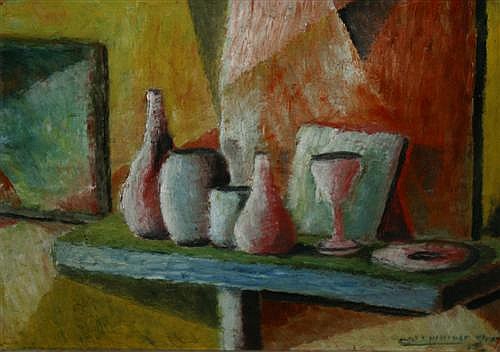
Collingridge Rivett - "The Mantle Piece" signed and dated 1947 in lower right, oil
Fishermen at Gijon, Spain & Cottage at Biscay, Spain, 1976, (2 works), Mixed Media - ink, wash & chalk by Collinridge Rivett
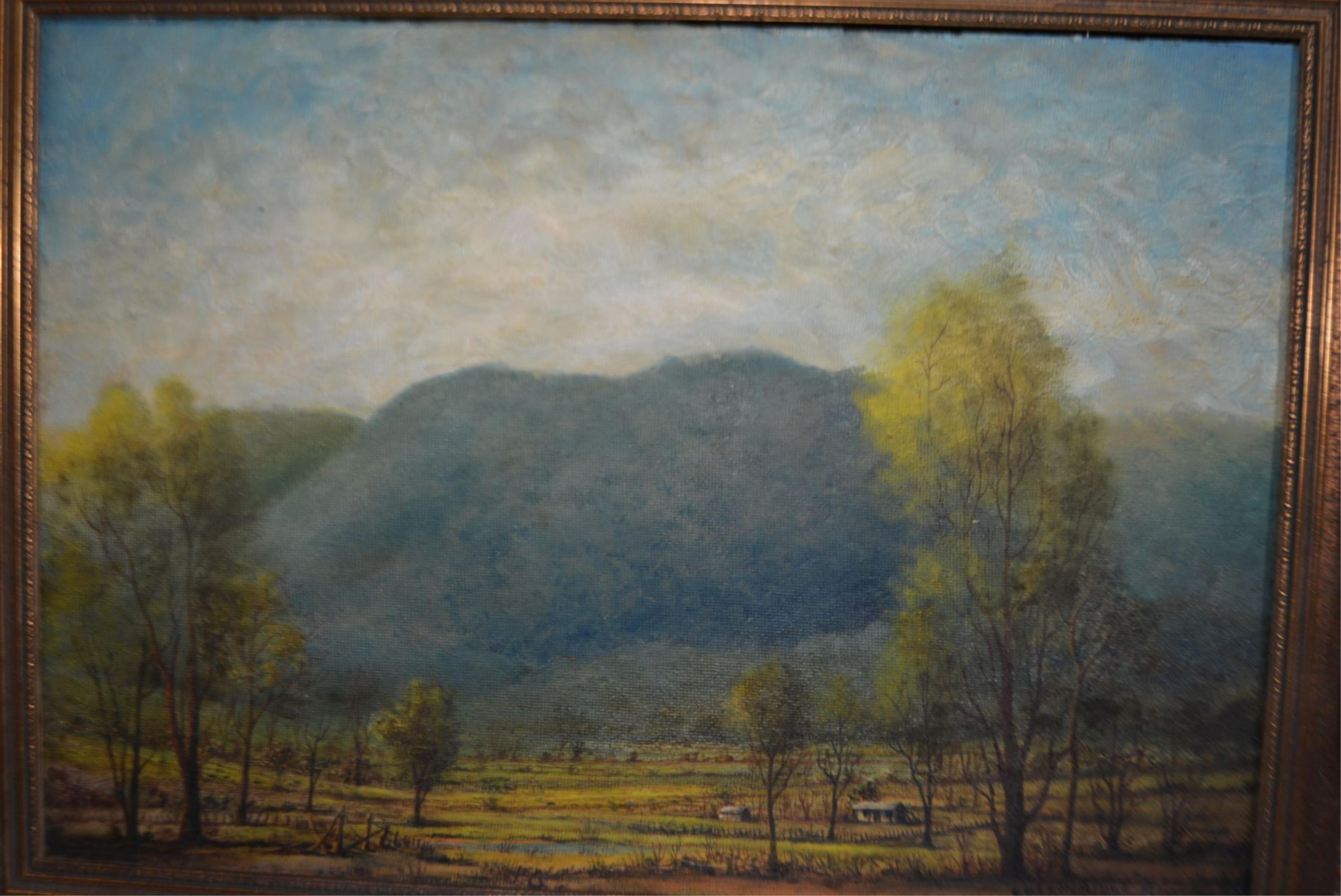
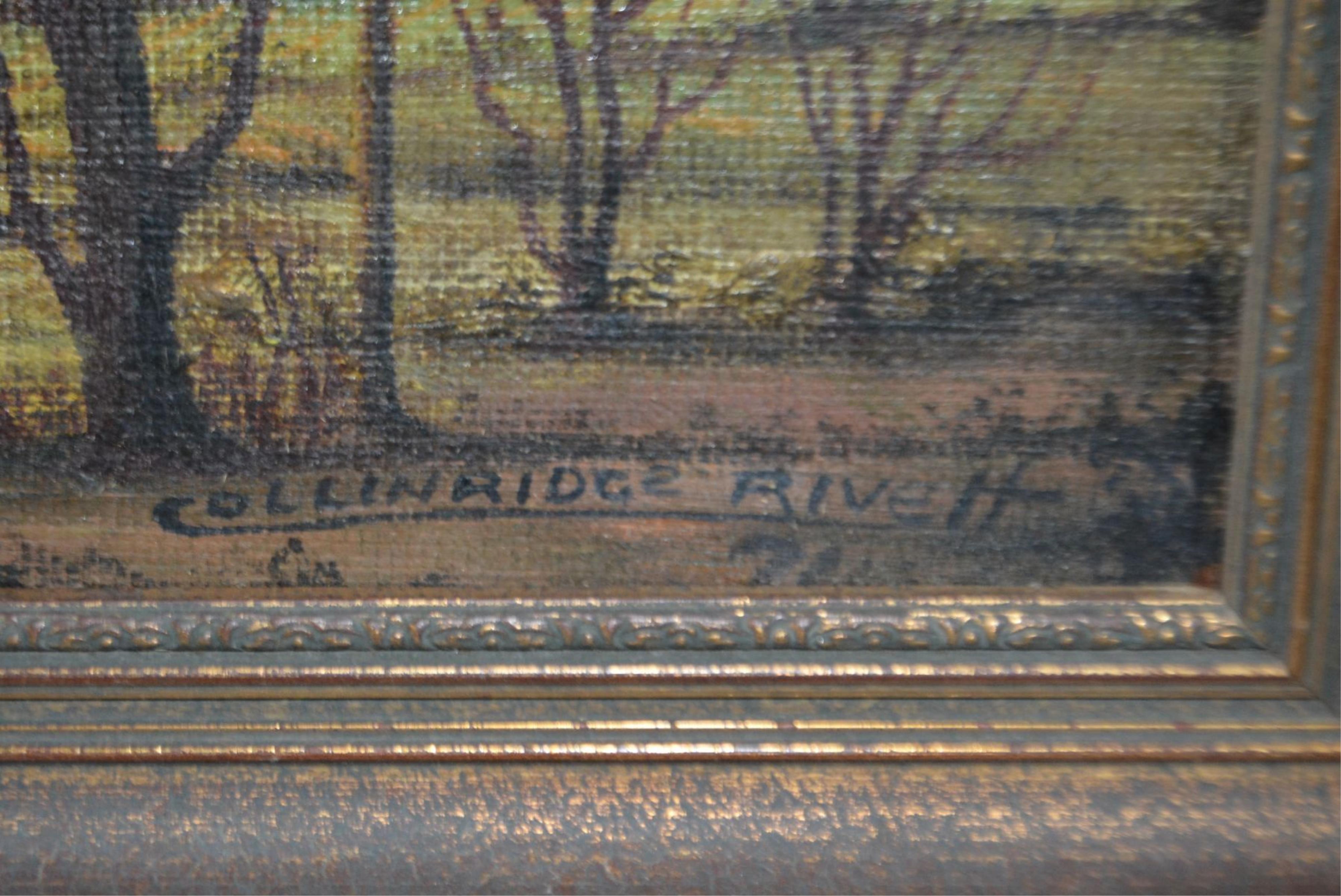
Collingridge Rivett, rural scene with mountain
ORCHID POSTER COMPETITION
A panel of judges, Miss Fai la Brottell (East Sydney Technical College,; Arts and Designs) and Sue Jane and Collinridge Rivett will select the best poster representing the forthcoming orchid show and garden party, drawn by -girls from the Parramatta Super-primary School. The garden party- will be held at thee home of Mr. and Mrs. A. J. Webb, 110 Railway Street, Granville, on Saturday, September 3, commencing at 2 .p.m. Special buses will leave Market Street, Parramatta, at 2 and 2.30 p.m., returning :at approximately 4 and 4.30. A committee meeting to finalise arrangements will be held at the ;Police Station at 8 pm on Monday, August 22. All members are requested to attend. ORCHID POSTER COMPETITION (1949, August 17). The Cumberland Argus and Fruitgrowers Advocate (Parramatta, NSW : 1888 - 1950), p. 4. Retrieved from http://nla.gov.au/nla.news-article111531607
COLOUR, design, balance, layout and artistic. qualities were the points. on which posters designed by girls from the Parramatta Super-Primary School were judged. Subject was the Orchid Show and Garden Party to be held for the Police-Citizens Boys Club .at Mr. and Mrs. A. . J. Webb's home. 110 Railway Street, Granville, on Saturday afternoon.
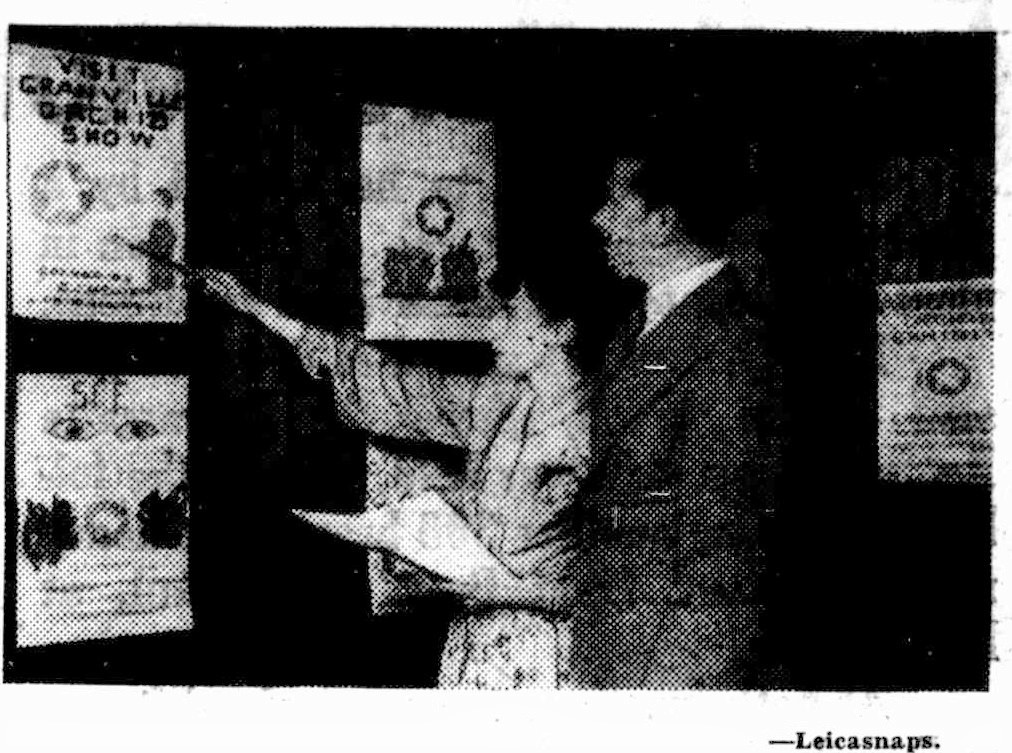
Pictured above are Sue Jane and Collinridge Rivett, who, with Fai la Bottrell, judged the posters, in which they consider the girls showed originality and talent. Mr. Rivett has donated a valuable art prize to the winner, Elaine Warburton, and also prizes to Dawn Robbie, Jill Newell, Colleen Herr, Shirley Griffin, Carmel Piper, Isabel. Wiltshire, Margaret Roche, and Joyce McNair. No Title (1949, August 31). The Cumberland Argus and Fruitgrowers Advocate (Parramatta, NSW : 1888 - 1950), p. 5. Retrieved from http://nla.gov.au/nla.news-article111532280
'A WELL earned rest at Palm Beach was enjoyed by Suzie Jane Rivett, wife of Sydney artist Collinridge Rivett. She played a big part recently in organising the Parramatta Children's Art Prize Exhibition. Roundabout (1949, November 27). Truth (Sydney, NSW : 1894 - 1954), p. 39. Retrieved from http://nla.gov.au/nla.news-article168962169
WITH PEG Behind The Social Scene
Parramatta District Legacy Contact Group held its annual dinner at the "Waratah" Restaurant, Macquarie Street, last Friday evening. The function marked the end of a year's office for retiring Chairman, Mr. Alex Thompson.
The new chairman is Parramatta City Council Alderman F. E. Armstrong, who is also president of Parramatta R.S.L. and headmaster of North Parramatta Public School. Ald. H. Mervyn Symonds takes office as vice-chairman. President of Sydney Legacy, Dr. Eric Blaski, who was official guest at the dinner, handed over the Legacy Charter' to Ald. Symonds. He also initiated a new member, Mr. Hugh Shepherd. Incidentally, I learn from Mr. J. Walmsley-who was the first chairman to hold office in the Parramatta District Group-that since inauguration two years ago as an- independent contact branch of Sydney Legacy, this group has taken under its wing 350 families (making 863 children) throughout the area for which it takes responsibility. And when you remember that when Legacy "takes care of" a family, it assuines medical, dental, educational and legal expenses, those figures make a mighty impressive achievement for two years. WITH PEG Behind The Social Scene (1950, May 24). The Cumberland Argus (Parramatta, NSW : 1950 - 1962), p. 11. Retrieved from http://nla.gov.au/nla.news-article110012536
LONG - HAIRED laddies of Strath Art Group, now exhibiting their work at the Waratah Gallery, Parramatta, say the Devil's Number is simply too too luck bringing. Looks like a "sell out" of their paintings, which will have been on exhibition 13 days by the time the show folds up. The exhibition was opened a June 13; Hyde Park, venue of the previous show, is 13 miles from the Waratah-as the crow flies. Since then 13 members have departed, mostly to Europe. Six other paintings added to the' exhibition last week; 'have come from Gay Paree, 13,000 miles away. Vive le nombre treize. ROUNDABOUT (1950, June 21). The Cumberland Argus (Parramatta, NSW : 1950 - 1962), p. 1. Retrieved from http://nla.gov.au/nla.news-article110012713
As well as being an Artist the Rivett family also collected works by Australian Artists:
BIG PARTY HONORS ART
Original oils and water colors by early Australian artists were displayed at 'the social "Laud" held last week in honor of contemporary artists at the art gallery, Macquarie Street, as a finale to the successful Parramatta Art Exhibition Season, which' closed in July. The paintings were from the Rivett private collection and included works by Calvert, Cayley, Heap and other pioneers of art in Australia in the19th Century, the Victorian and Edwardian periods. The guests of honor were the artists who have exhibited at the Parramatta 'gallery during the 1950 season: George Finey, Vivienne Curtis, Howard Robinson, Sidney Dover, Collinridge Rivett; Tara Chauvin, Earnest 'Fletcher, Rene Beckley, James Riley, Ivan Englund, Sam 'Davey, Bert Flugelman. William Wells, Ron Stewart, June Feltham, Keith Carter, John Coburn, John Paul Tony Fitzpatrick, Jim Riley, Maurice Stubbs, Geoff Allan, Ray Coles, Stan de Teliga, Jo Fitzpatrick, Pat Noonan, John Rigby, Geoff McNamara, Niel Ratcliff, Jon Molvig, Jack Collins.
An apology was received from Mr. Wilfred Gates, who was represented at the party by his son, Mr. Colin Gates. Susie Jane Rivett, who was hostess to more than 200 guests at the function, was also responsible for the attractive floral decorations of lilies, stock and jonquils arranged in tall vases.
Among the guests were Mr and Mrs E. J. Plowman; Mr. Alick McKenzie; Miss Roie Norton; Mr. C. Mcpherson; Mr and Mrs J de Keets (Melbourne) Mr. John Barker (Bellevue Hill) Mr and Mrs Cecil Vild; Mr F A Booth (Cont. Art Society) Mr. Douglas Bullport; Mr and Mrs Minchin; Mr. Brian Howell (Wentworthville); Mr Franck Mitchell (Sydney) Mr and Mrs E. Bartlett; Mrs. Charles Noakes and her daughter, Miss June Noakes; Mr. George Birdsall; Miss Jane Charlton-Musset (Potts Pt).; Mrs. Ivan Englund; Mr and Mrs F. G. Knight; Mr Joseph Mason, Mr. Ivan Roff, Miss Fay Botrill Mr. Bruen Finey, Miss Mitzi Finey.
Others present included h Mr. and- Mrs. S. Davey; Miss Kath Crofts, Mr. Allan Gray; Miss Hilda Crooks; Miss A. Gibbons; Mr. and Mrs. Frank Wilson (Melbourne); Mr. and Mrs. Fred O'Brien; Mr. and Mrs. W. J. Forbes; Mrs. Elizabeth Frazer; Miss Pauline Bell; Miss Norma Price; Miss Shirley' Campbell; Mr. Douglas McGregor and Mr. Douglas Hicks (Epping); Mrs. Eileen Bertram; Mrs. Belsey Lambert; Mr. John Lambert; Miss -Barbara Woodward; Miss -Beryl` McPherson. BIG PARTY HONORS ARTISTS (1950, August 2). The Cumberland Argus (Parramatta, NSW : 1950 - 1962), p. 5. Retrieved from http://nla.gov.au/nla.news-article110013250
AMONG enviable collection of fine arts and furnishings received for her 21st birthday last week (April 7) by Susie Jane Rivett, was an antique French musical carriage clock. The rare gift was from her husband, Collin.. Sue will celebrate her coming-of-age at cocktail party for intimate friends and family, later in month. Social Spotlight. (1951, April 11). The Cumberland Argus (Parramatta, NSW : 1950 - 1962), p. 4. Retrieved from http://nla.gov.au/nla.news-article132146367
THE- constitution, by-laws and list of committee of City of Parramatta Arts Society have just been printed. Any one interested can obtain a free copy by writing or 'phoning secretary Collin Rivett ' (UW9476 or 79 Macquarie Street, Parramatta). Women, by the Way, make up 40 per cent, of Society's membership. Social Spotlight. (1951, July 18). The Cumberland Argus (Parramatta, NSW : 1950 - 1962), p. 4. Retrieved from http://nla.gov.au/nla.news-article132149720
WOMEN HELP WITH JUBILEE CELEBRATIONS
Women of Parramatta are playing an important part in the forthcoming Historical and Arts Exhibition at the City Hall to mark Parramatta's official Commonwealth Jubilee celebrations.
Four local women artists' -—Vivienne Curtis, Beryl Mallinson, Peggy Gregory . . Lee and Madge Staunton -—have had their work accepted for exhibition in the contemporary art section. Miss Lee has also undertaken to design and produce pottery souvenirs for the Jubilee celebrations in Parramatta. Secretary of Parramatta Arts Society and member of the Exhibition's general management committee, Mr. Collin Rivett, said last week that of the antique collectors exhibiting, two out of three are women. Prominent among them are Miss Alice Pringle and Miss Margaret Swan, of Elizabeth Farm House. 'Some of the finest examples of colonial antiques; are coming from Elizabeth Farm House-; — the oldest inhabited building in Australia,' Mr. Rivett said Women are also helping Actively behind scenes'' — as women usually do — attending to the social corners' of the Exhibition, the catering, entertainment and sales of catalogues. Arrangement of fresh flowers, picked from some of the oldest gardens in Australia, for floral displays in and around -the Exhibition, is being carried out by Maureen Wainwright, Belsey, Lambert and Doreen Long. Mrs. Walter Frater, of Carlingford, is lending early Victorian vases for this purpose
CHILD ART
A, special section of the exhibition in which women are expected to take keen interest is that devoted to child art. The young artists of Parramatta and district did not know when they did it that their work was to be exhibited. By thus eliminating competitive spirit, organisers Feel the children's work retains pureness and originality ' without self-consciousness The entries range from infants impressions to work' from 'teenagers of the larger schools, such as -Parramatta Secondary Home Science School and The King's School. The Jubilee Exhibition is being organised by the' Mayor q{ Parramatta (Aid. E. A. Mobbs) and a committee of local historians, artists and cultural workers. It will be officially opened at 3 pm, on Friday, November 2, and will remain open for two weeks, including Sundays and some evenings. WOMEN HELP WITH JUBILEE CELEBRATIONS (1951, October 24). The Cumberland Argus (Parramatta, NSW : 1950 - 1962), p. 4. Retrieved from http://nla.gov.au/nla.news-article132148785
APRIL' is birthday month in artist Collinridge Rivett's family, and to celebrate, they're throwing a party - at the Waratah (Collin's Mine Host there) on April' 26. The five who have birthdays this month are Collin's mother, Mrs. Walter Frater; her husband, Wally; Collin's aunt, Mrs. Sophy Turner; his sister. Mrs. Belsey Lambert; his wife, Susie Jane, and future brother-in-law, Mr. G. Toland. Mrs. Frater, of ' 'Carlingford Lodge,' is arranging the buffet - dinner - dance. Guests, numbering over 100, will arrive from all over the State, and Mrs. Eileen Bassett, of Parramatta, will' act as hostess. Mr. Vin Clayton, of Potts Point, will officiate as M.'C. Cocktails, a lavish Continental supper, a huge birthday cake, a novelty orchestra and ballad items will be features of the social. Social Spotlight (1952, April 23). The Cumberland Argus (Parramatta, NSW : 1950 - 1962), p. 3. Retrieved from http://nla.gov.au/nla.news-article132147275
Mrs. Martha Rivett, of Carlingford, proprietress of the Waratah Restaurant, Parramatta, left recently for a six weeks holiday motoring with friends on an extensive tour of New South Wales. CAR HITS CHILD (1950, July 5). The Cumberland Argus (Parramatta, NSW : 1950 - 1962), p. 1. Retrieved from http://nla.gov.au/nla.news-article110013406
NOT so many days ago, Mrs. Martha Rivett, of Parramatta, packed her ports and departed, ostensibly for a six weeks' motor meander through the wide-open spaces of this State. So her grown-up family of five thought, until one day last week came a letter casually mentioning she'd changed her name, and that the holiday could now be termed a honeymoon. The other half- in this happy happening is Walter Frater, well-known grazier, of Binnaway, and the knot was tied in the local Roman Catholic Church. Commented son Collinridge Rivett: "The news was' a bit of a shock, but the family is perfectly happy about it. Mr. Frater is a' fine fellow and a great friend of mother's since she was widowed in 1945." ROUNDABOUT (1950, July 12). The Cumberland Argus (Parramatta, NSW : 1950 - 1962), p. 1. Retrieved from http://nla.gov.au/nla.news-article110014064
Collingridge Rivett, also produced many cinderellas during the 1960's - 1980's. In philately, a cinderella stamp is "virtually anything resembling a postage stamp, but not issued for postal purposes by a government postal administration". There is a wide variety of cinderella stamps, such as those printed for promotional use by businesses, churches, political or non-profit groups.
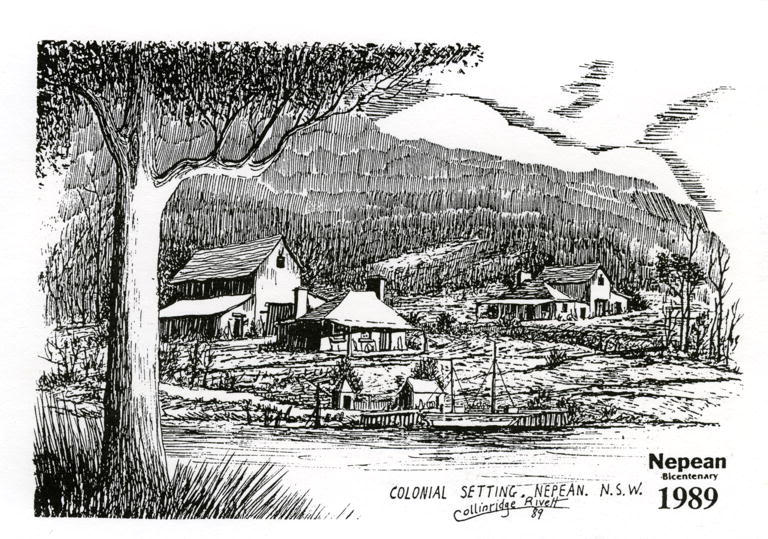
Collinridge Rivett began illustrating and writing Australiana articles in the early 1950s. Most of these items deal with the Parramatta district as it was here that Australia’s early political, religious, cultural and educational movements and organisations emerged.
He also started the Parramatta Art Society and was a founding member of the Parramatta Historical Society and wrote numerous texts on histories as well as catalogue notes exhibitions. Parramatta Council records show:
The City of Parramatta jubilee historical and art exhibition, 1951, 2nd Nov. until 11th Nov., Parramatta City Hall, N.S.W. Bib ID 1128724. Printer; Parramatta [N.S.W.] : Cumberland Newspapers), Description Parramatta, N.S.W. : Parramatta City Council, 1951. 25 p. : ill. ; 28 cm. Summary: Exhibition catalogue, lists artworks and artists including twenty-three Aboriginal artworks, and four paintings by Albert Namatjira mentioned. Notes Organised under the direction of the General Managing Committee for the City of Parramatta Jubilee Historical and Art Exhibition, 1951. Compiled and edited by Collinridge Rivett. Cover title: Parramatta jubilee year historical & art exhibition 1951 souvenir catalogue. "Parramatta City Council Jubilee Celebrations 1951 presents an exhibition of Aboriginal art, pioneer, colonial and Victorian antiques and arts, contemporary art, child art".
The Waratah Cafe's upstairs rooms was the scene of many of these exhibitions:
Parramatta's 115 years of art
One of Sydney's oldest Cultural groups, the Parramatta Art Society, opened their Second Salon Art Exhibition in the Waratah Gallery, Macquarie St., Parramatta, last night.
Residents of Parramatta are most conscious of their town's historical and cultural background and are specially proud that Australia's first Art Gallery was opened in Parramatta in 1838. Many of the exhibitors are descendants of the original art patrons of the district. However, the first gallery was demolished in the gold rushes of 1950 and since that date art enthusiasts in the district have held their meetings in halls, restaurants, hotels and private homes. Now they are working hard to re-establish an art gallery that will serve as a club and meeting place for local artists and students. At least half the exhibitors are women- and all are keen to help establish a permanent meeting place.
TT SUM Food and drink will be available at the club for those who merely want to chat or exchange ideas on the latest phases of art. As Parramatta is a growing industrial centre and the home of many new Australians, their work is prominent in the exhibition. It contrasts sharply with the typical Australian pictures by local residents of old homes and churches, Australian bush scenes, as well as paintings of leading historical and local citizens.
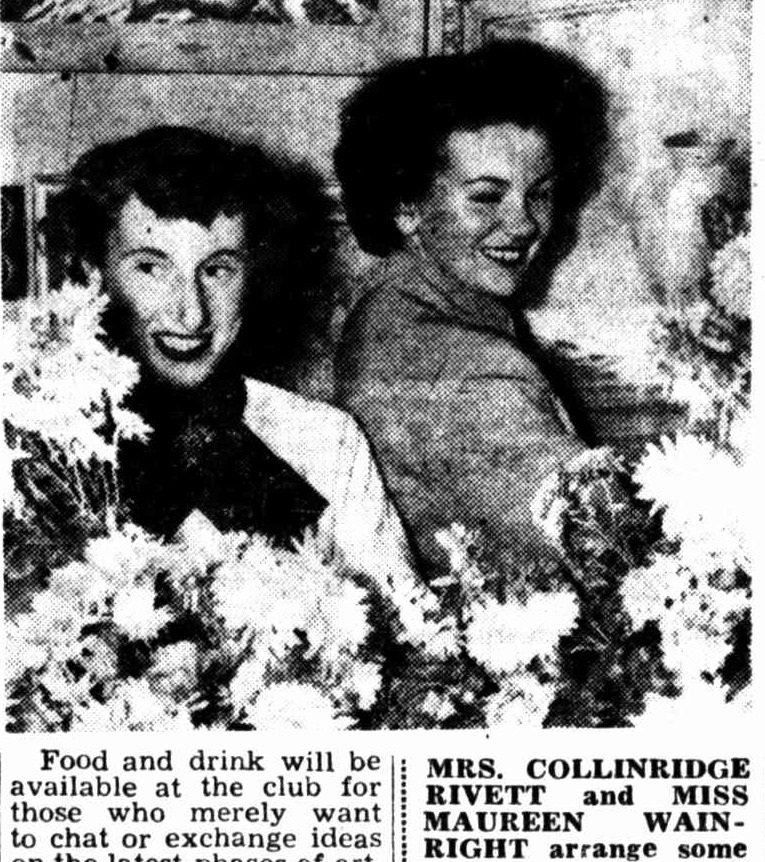
MRS. COLLINRIDGE RIVETT and MISS MAUREEN WAINRIGHT arrange some of the paintings and the floral display at the Parramatta Art Society's Second Salon Exhibition yesterday. Miss Wainright's father, Mr. Richard Wainright, has exhibited a series of pieces carved from local woods. The exhibition will be open until May 27. Parramatta's 115 years of art (1953, May 19). The Sun (Sydney, NSW : 1910 - 1954), p. 23 (LATE FINAL EXTRA). Retrieved from http://nla.gov.au/nla.news-article231044728
Artist Collinridge Rivett, who is secretary of the City of Parramatta Art Society, will have Tuesday all on his own when his exhibition will be opened by Dr. Kevin Fahey at the Waratah Gallery at 8 p.m. MERE CHATTER.. (1953, July 26). The Sunday Herald (Sydney, NSW : 1949 - 1953), p. 25. Retrieved from http://nla.gov.au/nla.news-article18509925
Artists' Costumes Were Weird and Wonderful
Arrival of two 'Redax Trial' teams, complete with midget cars and lull complement of drivers, mechanics and navigators, preceded a lively night at Parramatta Artists' first annual fancy dress hall in the City Hall last Thursday.
The 'Redax' teams, comprising Norm Gilbert, Jack Browney, Pat Lee, Phil Stanley, John Gregory and Allison Bodkin, provided the most topical fancy dress of the evening.' More than three hundred mostly in fancy dress, attended the ball, and many more Watched ' proceedings from the public gallery.
Pioneer of the Sydney Artist's Ball, first held in the twenties, Mr. W. G. Gates welcomed guests.
Among the most original costumes were those worn by Victor Angel and his sister. Living up to their riatfie, they were dressed as angels, complete with wings ; and halos. John Mathews of Auburn, dressed in immaculate dress clothes, but minus trousers, lent humour to the array of colour. Other eye-catching costumes, were worn by Ron Flemming, 'Biscuit King,'. Betty Flint, Jacobean Lady, Colleen Rodd, Spanish dancer, and Shirley Bottrell, most popular lass of the evening, as a French CanCan dancer. Norm Parry, of Harris Park, came dressed in a suit that had belonged to his grandfather. Dress of Colin Rivett's party; which included several Naussies, was fashionable in the 'gay nineties.' Another party organised by Edmund Spencer, defied the rain and dressed in Eastern costumes.
'GOOD AS SYDNEY
Commenting on the standard of fancy dress, Parramatta artist Collinridge Rivett said, 'The originality and variedness of costumes is as good, and even better than those seen at the Sydney Artists' Ball.' Artists' Costumes Were Weird and Wonderful (1953, September 16). The Cumberland Argus (Parramatta, NSW : 1950 - 1962), p. 3. Retrieved from http://nla.gov.au/nla.news-article132141653
First "Outer-Space" Visitors Arrive In Parramatta
Several flying saucers reported by coastal look-outs last Friday night extinguished their atomic power units over Parramatta and drifted down into Church Street on orthodox jets. Robot crews of the saucers appeared friendly and made no attempt to harm crowds watching silently on both sides of the street.
Under the suspicious watch of local police, the space-men were directed by sign language to the City Hall to be welcomed by Mayor of Parramatta, Ald. H. V. Horwood, who was attending the Parramatta Artists' Ball. Leader of the group, who indicated his name as Pat Lee, and his men, mingled with ball guests, who believed them to be other patrons in fancy dress. The deception was so complete that the president of the Art Society. Mr. J. Goldstein, present-ed the robot leader with first prize for the best fancy dress. More than 300 guests in a colourful array of fancy dress made the ball a sparkling success, oblivious of the strange . visitors in their midst.
Prize for the best female fancy dress, was awarded to Miss Joy Jervis, who, dressed as a hideous 'zombie.' Miss Jervis was one of a party calling themselves the 'horror party.' Organised by Colin Rivett, the party included ghosts, witches, and demons painted a sickly green. Colin's wife, Sue, was dressed as bat-girl, with a black face and realistic wings.
INDIANS
Edmund Spencer brought a splash of the wild west with a party of nine Red Indian braves and squaws. The party erected a huge totem pole on their table, and the leader smoked a long pipe of peace. Decorations were. also very good on Mrs. C. Heaton's table, who brought along a party of 20 rowdy pirates. The table was lit by candles stuck in the necks of old rum bottles and a treasure chest spilling over with gems and old coins was placed in the centre of the table. An amusing party was arranged by Barry Edwards, consisting of 12 sheiks and harem girls. The boys took the roles of harem girls and the girls dressed as sheiks. The group staged an impromptu harem dance during the evening.
Fourteen guests dressed as school-children comprised Len Rodd's party. Len Rodd also acted as M.C. for the evening. A Bebarfalds party, headed by manager Mr. R. Lloyd, dressed as the 'Bebarfalds Bluebirds' and took part in the floor show. Some of the best individual costumes, were worn by Monte Miller and Colleen Rodd, who dressed as Caesar and Cleopatra, Dick Hoyes as a skeleton, Mrs.. E. Fraser as a two-faced woman, Mavis Fergeson as "Annie Get Your Gun." Other costumes included cowboys, Hawaiians, Chinese Mandarins, gypsies, Spaniards and pirates. One couple attended as 'Roman Holiday,' and an-other young lady appeared in a daring can-can gown. Three men attended the ball without trousers.
DECORATIONS
Artist members of the society painted special pictures to adorn the walls and a huge drape depicting aspects of art and life in Parramatta was hung across the balcony. The painting was done by Dick Hoyes. A floor show was staged by Victor Angel and Norma Soutan, two talented artists who have performed professionally in many parts of the world. Organiser of the ball, Mr. R. E. Wainright, said he wished to thank every-one who had given him assistance during the months of work prior to the ball. He specially thanked artist, Dick, Gates, who painted several of the posters decorating the hall, and also a picture offered as prize in a guessing competition. Mr. Wainright said the ball had been a greater success than the previous year, and the society intended providing a larger hall for next year's ball, to accommodate more patrons. First "Outer-Space" Visitors Arrive In Parramatta (1954, November 17). The Cumberland Argus (Parramatta, NSW : 1950 - 1962), p. 14. Retrieved from http://nla.gov.au/nla.news-article132142135
TWO-YEAR-OLD Stephanie Rivett and her crying balloon doll nearly stopping the show when her mother, wife of the artist, Colinridge Rivett, took her to sec the art exhibition at the Forum Club. Every time Stephanie turned round to "see the pictures," her bright yellow doll "cried," fascinating fellow viewers who couldn't make out where it came from. Sydney's Talking About— (1954, October 21). The Sydney Morning Herald (NSW : 1842 - 1954), p. 8 (Women's Section). Retrieved from http://nla.gov.au/nla.news-article18454212
Moult-Spiers held a two-person show in 1964, with Collinridge Rivett who was then secretary of Australia Art Associates. The exhibition, at the Penthouse Gallery, Church Street, Parramatta, was opened by David McMillan, the University of Sydney Archivist. Proceeds went to the International House Appeal in aid of multicultural understanding and acceptance, an initiative of both the University of NSW and the University of Sydney. The review described Moult-Spiers as being ‘recognised as one of Australia’s most creative and original contemporary painters’. Raymond Moult-Spiers preparing for the 1959 Road Show, an exhibition he and two other ex POWs took out of the gallery environs and to the people. His absurdist wit at play: “AT FIRST I PAINTED FOR ME ------ NO RETURNS. NEXT I PAINTED FOR PEANUTS ------ BETTER”. Private collection http://www.ozarts.net.au/images/oz-arts/2020-summer/MOULT-SPIERS-PT3.pdf
Joseph Collinridge Anthony Rivett died in 2008 and was interred in the Hawkesbury cemetery Richmond Lawn Roman Catholic K 16 17. Although his artworks may not fetch high prices today, his contribution to cultural life in Parramatta was extensive and long lasting, as was his wifes'.
Fahy Bottrell
Fay Bottrell born January 18th 1927 to Percy Clarence and Winifred Lilian May, nee Tracy, was one of four children. Fay, later spelled 'Fahy', came to Sydney from the Riverina as a sixteen-year old, and worked for a herbalist. After war service with the AAMWS, Service Number - NF481408, she studied art at the East Sydney Technical College and worked in a print and dye business. The Australian Army Medical Women's Service (AAMWS) grew out of the volunteer Red Cross and St John Ambulance Voluntary Aid Detachments.
Her father had served in WWI in the Light Horse and then in WWII until he was discharged to perform duties as a fruit inspector:
APPOINTED as successor to the late Mr. J. H. Hubbard as fruit inspector in the Kurrajong area, with headquarters at Richmond, Mr. P. C. Bottrell, who comes from the Baulkham Hills district, and previously from the Irrigation Area, took up his new duties on Monday. Mr. Bottrell will be staying at the H.A. College (where he may be contacted on week days), and we offer him a cordial welcome to the district. PERSONAL (1946, May 1). Windsor and Richmond Gazette (NSW : 1888 - 1961), p. 5. Retrieved from http://nla.gov.au/nla.news-article85791095
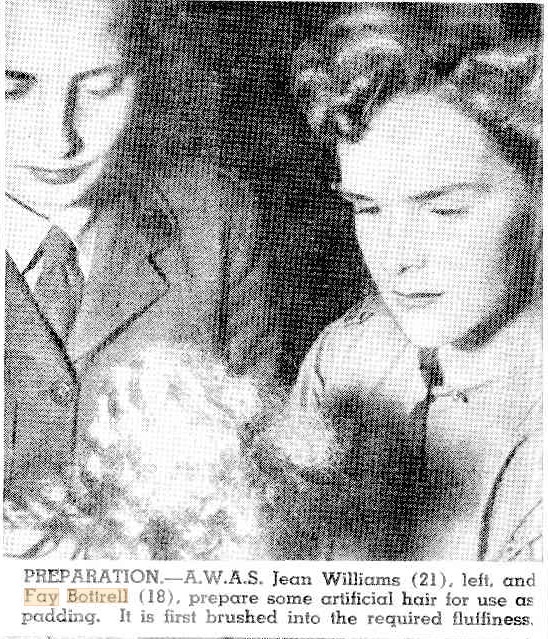
PREPARATION — A.W.A.S. Jean Williams (21), left, and Fay Bottrell (18), prepare some artificial hair for use as padding. It is first brushed into the required fluffiness. Rush For New Supplies Of False Hair (1945, April 19). The Daily Telegraph (Sydney, NSW : 1931 - 1954), p. 8. Retrieved from http://nla.gov.au/nla.news-article248008185
Fay Bottrell has really settled for the artistic life. She's just finished five years of studying design, textiles and art at the East Sydney Tech., has passed her exams and is about to take up her new profession — teaching students of arts and crafts for the Red Cross Society. ARTHUR POLKINGHORNE'S Sydney Diary (1953, January 3). The Sun (Sydney, NSW : 1910 - 1954), p. 5 (LAST RACE LATE CRICKET). Retrieved from http://nla.gov.au/nla.news-article230850753
Fay, later spelled 'Fahy', lived in the commune at Barrenjoey Lighthouse, mixed with the Push and went to India to study cottage industry before settling in North Queensland and then Matcham, NSW (where she was an active conservationist).
Fay became a textile artist and teacher and worked in her field all her life.
In the 1960s she was involved in Mary White’s Design School in Edgecliff, Sydney. In 1961 she married Artist John Endean. they were both at school together – East Sydney Tech. He was panting still lifes then but later worked in films and as a cartoonist. John Endean was a mid 20th century Sydney Bulletin cartoonist. Endean also worked in London in 1952-54. In 1964 he joined the ABC. As a cartoonist he drew for Arna (Journal of the University of Sydney Arts Society) in the c.1940s. At the same time he also began contributing to the Bulletin. He was a Smith’s Weekly cadet in 1945. Three original cartoons drawn for Smith’s – “Caution curve. I told you so!”, “Tell them to repeat the last couple of words” and “Could I talk to you a moment, there’s something I want to get off my chest” – are in Mitchell Library (PXD 840) donated by the wife of a reporter in 1999 along with approximately 20 other originals and a copy of the final issue, 28 October 1950, signed by all the cartoonists.
Endean worked in London in 1952-54, then joined the Sydney Daily Mirror. He continued to contribute to the Bulletin both before and after the ACP takeover in 1960 (Rolfe, 271), eg “Dear Dorothy Dix…!” (woman with knife in back, big original Mitchell Library Px*D 426/14); “Do you have the recipe for this one?” (woman in art gallery in front of still life painting, big original Px*D426/26); (two priests looking at Sistine Chapel-style ceiling consisting mostly of large Baroque female nudes) “It’s marvellous the difference a coat of paint makes to a room” 1961 (ill. Rolfe, 303). 130 original drawings for the Bulletin 1955-60 are in the ML Bulletin collection, while 34 original Endean cartoons for the Bulletin and Australian Business ( Oz Biz ) from 26 December 1978 to 22 December 1981 + n.d. are at ML PXD 739, e.g. 'Of course, Tourism is still Our Main Industry’ (factory assembly line with archetypal tourists rolling off it, included in State Library of New South Wales b/w exhibition 1999). Endean joined the ABC in 1964. - From Design and Art Australia Online, writer: Joan Kerr.
This Artist Is FAST
Says RITA DUNSTAN
John Endean made two-minute sketches of scenes from "Kangaroo’’ while directors told him to hurry! Scene sketches like these show the director how his camera shot will look on the screen. Action. sketches help keep continuity.
NOW THAT THE "Kangaroo" film unit has packed up and gone home, most Australian film fans will be waiting eagerly for the release of the film to see how the Americans have transferred the Australian story and background to the technicolour screen. But there is one enthusiastic young filmgoer who will be in-curious because he already knows every scene of the film backwards.
He is ex-Melbourne artist, John Endean, who has been working with the unit in Sydney and Port Augusta. As visual artist for the unit, he has drawn by hand every scene since shooting began in Sydney last year.
John Endean, who is only 20, unwittingly became the pioneer in this country of a new type of commercial art when he began work for 20th Century Fox. There are no other film visual artists in Australia. When he applied for the job he did not know that, in the film industry, a visual artist's job was to draw lightning sketches of a proposed scene for the guidance of the director, a director, and script writer. Director Lewis Milestone asked him to do quick test drawing of a group ( people huddled together in a small boat tossing about off the coast of Sydney). He drew the scene in a few minutes and got the job.
Mr. MILESTONE introduced the idea of working of artist's sketches when he made his Movie directors need sketches like this to ensure that characters remain in the same position, act in same manner, in case the scene is cut and shot again.
Mr. Milestone told me the pencil drawings of "Kangaroo" were photographed and sent to Hollywood, where the editors used them as a continuity guide. "In Hollywood, where color film is processed, the film editor uses his set of black and whites to preserve the sequence. The artist doing this work must be quick, and above all, imaginative. Sometimes it’s best to give him his head and let him bode on his own ideas. It is fine experience for a young artist. I'm glad to have an Australian for the job."
John Endean's drawings, most of which he hurriedly sketched standing up or using a log for a desk, included anything from a "still" of lovely star Maureen O'Hara, to a dramatic cattle rush. But he was well prepared for this variety of subjects. When he first went to Sydney as a boy, John decided that he wanted to be an artist He spent all his spare time between school hours, sketching children, animals, and landscapes at Taronga Park Zoo, Sydney. He still goes there to practise drawing. His best friend at the zoo is a vulture named George, who answers to his name and puts his head through the com-pound fence to be scratched.
Now that his film job is finished, John intends to return to his old job of cartoon work and illustrating, which he thinks will be like sailing into calm water after a storm.
"Working at breakneck speed doing two-minute sketches, is exciting, but exhausting," he says. "All the time you're working, you know the director is waiting for results so that he can see just how the scene will look before he orders his crew to work. But I'd take the job on again if it were offered." This Artist Is FAST! (1951, April 27). The Argus (Melbourne, Vic. : 1848 - 1957), p. 6 (The Argus Week-End Magazine). Retrieved from http://nla.gov.au/nla.news-article23043202
Fahy didn't move too far from Barrenjoey as they were living at Bayview during 1964:
SYNDICATED CARTOONS
In his article on the history of cartooning in Australia (Walkabout, October), Jack Horner does not mention the devastating effect that the syndication of foreign cartoons (mainly American and English) has had on the development of local cartooning.
Syndicated material from overseas began to infiltrate Australian newspapers and magazines in the late 1940’s and is now present in all forms of journalism and illustration; indeed, Walkabout is one of the very few magazines completely free of it. Editors can buy foreign black-and-white material for a few shillings a time and this has forced local artists to drift into other forms of commercial art.
Political cartooning has survived, however, and despite Mr. Horner’s remarks that local cartoonists have lost much of their sting, I find that the cartoons of Les Tanner in The Bulletin and Bruce Petty in The Sydney Morning Herald contain all the ingredients of acid humour and pertinent social comment.
JOHN ENDEAN
Bayview, N.S.W. Australian Geographical Society & Australian National Publicity Association & Australian National Travel Association. Walkabout – January 1964 edition Retrieved from http://nla.gov.au/nla.obj-754145877
TELEVISION
Flat crime wave
By JOHN HAY
Crimewave, the first of the ABC's Metropolis programmes on Wednesday night, was as dull as a flat surf.
It has no comperes, no commentators, no interviews and there was really no point in making it other than to deliver a series of police lectures on public safety and bank security.
The programme also showed that although policemen are armed with the latest in communications equipment for for catching the lawless ones, it takes Leonard Teale or Inspector Barlow to put personality talk into a programme.
A sixth of the half hour was stolen by Detective Sergeant Jack McNeil, head of the Sydney Hold-up Squad (head and shoulders view only) giving a bank safety lecture that had phrases dropped in like "decent thinking people", "public co-operation" and so on.
But the Board Riders on Impact on Tuesday night were catching some more lively waves.
Was it the effects of LSD they were trying to get across, or an introduction to Zen Buddhism? Stoked with deep involvements and aesthetic sense, feelings of weightlessness, relaxing, danger, like the feeling of falling, challenging and dedication were offered in explanation of their 'religion'.
One point we did gather and which all the addicts seemed to be agreed on was that board riding, in their opinion, was strictly a men-only career.
Reasons varied from one youngster who didn't fancy his women with muscles bigger than his to another toddler who thought that girls "got in the way".
The girls gave their articulate opinions in the next segment, The Gilded Cage. They included such personalities as PLC headmistress Betty Archdale and Vogue editor Sheila Scotter, who did not ajjree with the "searchers for the perfect wave" that "birds are all right in their place",, The problem was, as they saw it, that Australian women were lulled into a beatific apathy by influences ranging from, in particular, their husbands, and by women's magazines . and society in general.
Made with a light touch and with excellent graphics on early convict birds by Sydney artist John Endean, this study of Australian women was as entertaining as a romp through the kitchen with Graham Kerr. TELEVISION Flat crime wave (1966, December 2). The Canberra Times (ACT : 1926 - 1995), p. 18. Retrieved from http://nla.gov.au/nla.news-article106949919
'Forces from the Subconscious, A Conceptual Show by Fay Bottrell', ran in Sydney in 1976.
In the 1970s Fahy collaborated with Wesley Stacey on the 1977 book The Artist Craftsman in Australia - this is described as;
"A beautiful book in which craftsmen working in a wide variety of mediums explain what motivates them and show exciting examples of their work.
In a fascinating combination of carefully fashioned text and superb full colour photographs, the artists convey their attitudes to living and their life styles."
Fahy taught at the Alexander Mackie College and was a design consultant for the first Festival of Sydney. The Festival Theatre Gallery in Adelaide opened in 1973 with her ‘happening’, Fabrication; she returned seven years later to install a second happening, Glad to Be. In 1978-1979 she made a mammoth work for the International Year of the Child for the Arts Council of NSW.
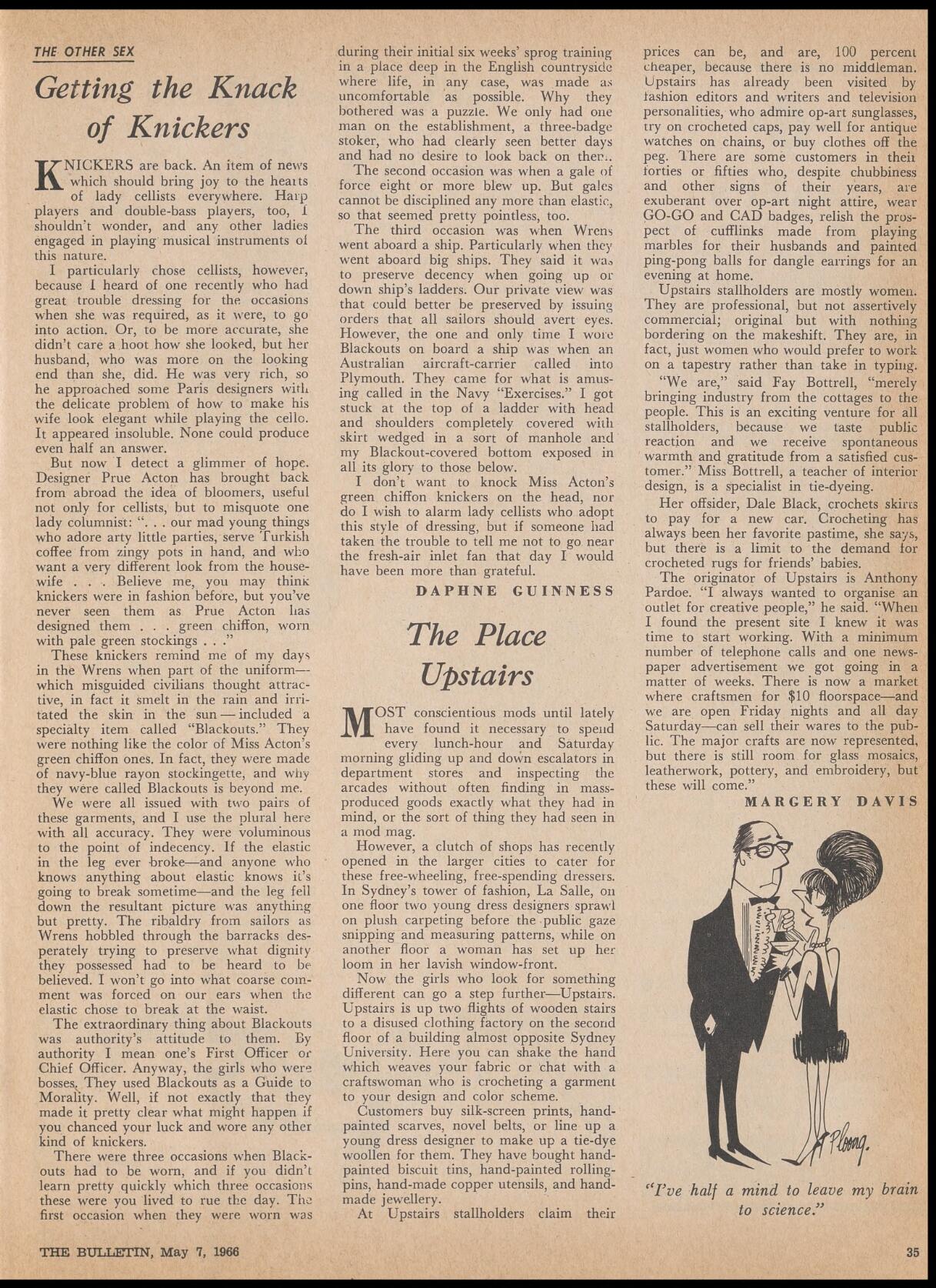
Fahy Bottrell - 1966 article in The Bulletin, courtesy National Library of Australia
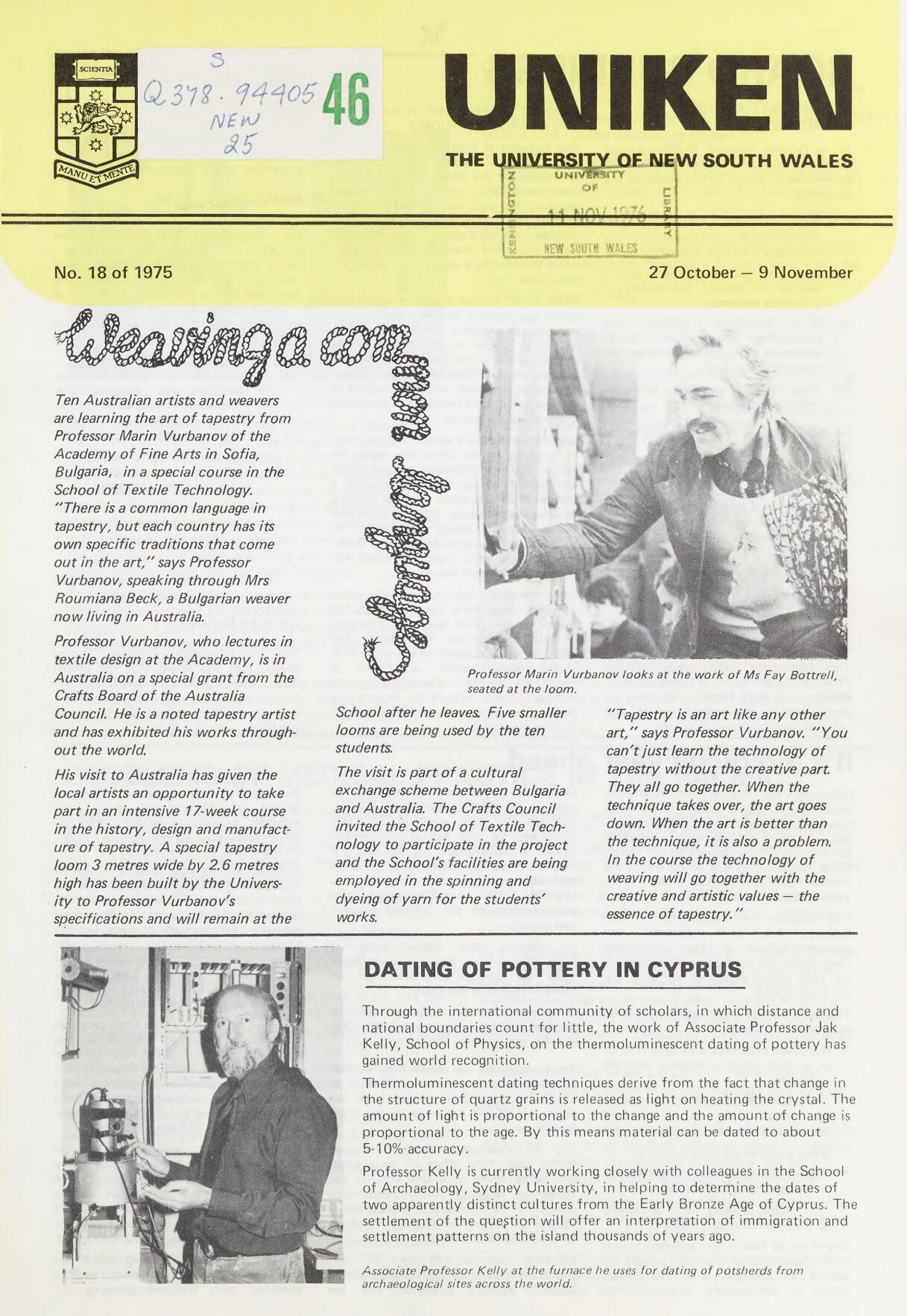
1975 - at the UNSW
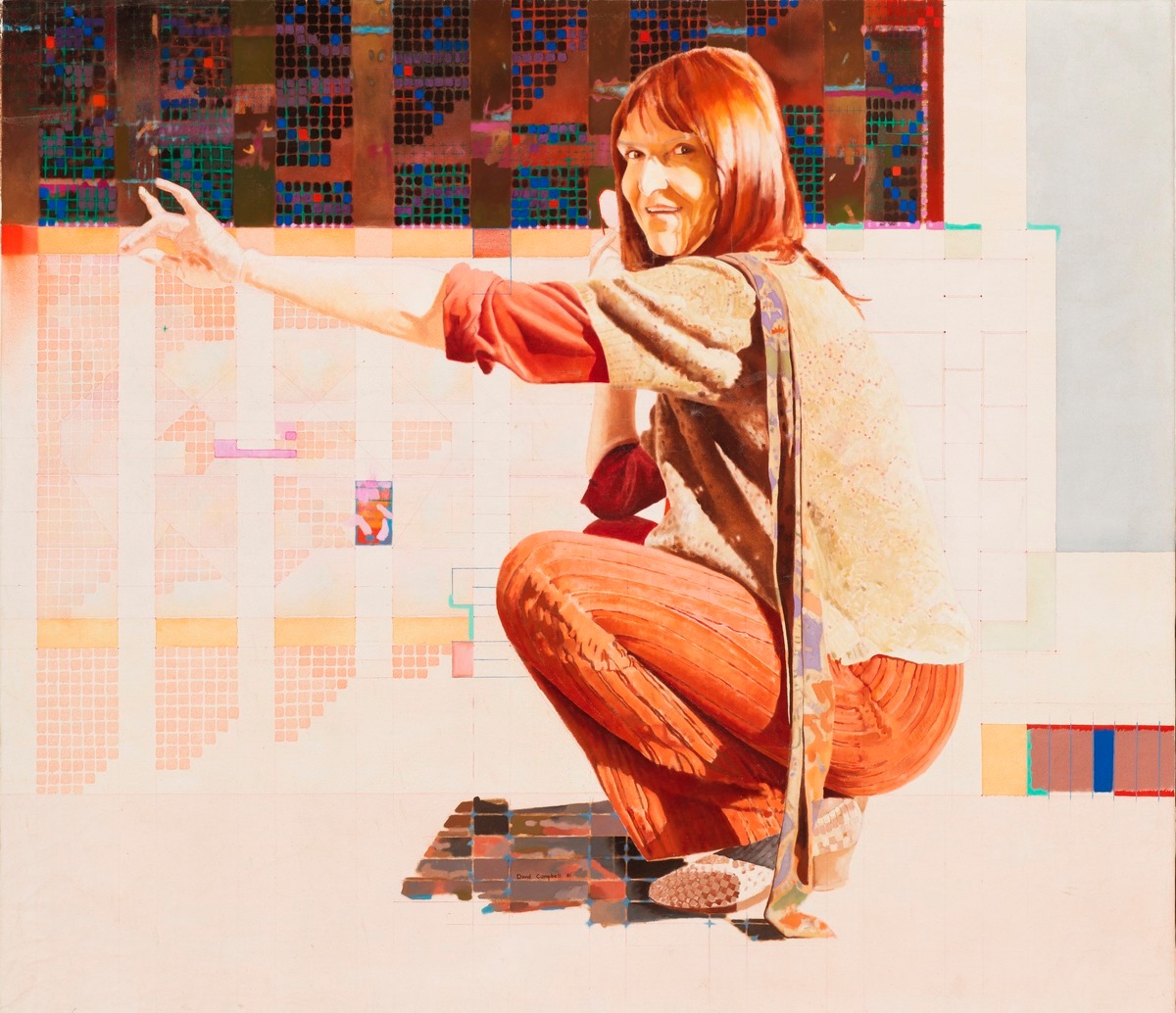
This portrait by David Campbell of artist Fay Bottrell (born 1927) is now in the collection of the National Portrait Gallery, Canberra. Fahy was 54 when this work was completed, David was 29. it was painted for entrance to the Archibald. Gift of Elizabeth Campbell-MacKenzie on behalf of the family of David Campbell 2012. © Estate of David Campbell, courtesy National Portrait Gallery.
Fay Bottrell had taught David Campbell, and shared his Sydney studio in the early 1980s. At his funeral a few years later, a tapestry of flowers by Bottrell was spread over his grave.
Eric Smith's portrait of his dealer, gallery owner Rudy Komon (1908–1982), won the Archibald Prize for 1981. David’s portrait was a finalist though, as was Sali Herman’s ‘The Artists’ Wife’
 WITH ARTWORKS BY DAVID CAMPBELL AND FAY BOTTRELL, C. 1980.jpg?timestamp=1648925728350)
Fay Bottrell (left) with artworks by David Campbell and Fay Bottrell, circa 1980. © Estate of David Campbell, courtesy National Portrait Gallery.
In 1983, artist Fahy Bottrell completed these large-scale intricate twin tapestries, inspired by the Morten Bay fig trees that dominate the view of the Sydney Domain from the Strangers’ Restaurant at NSW Parliament House.
One of the tapestries was even finished in the restaurant itself (pictured). Photos courtesy Parliament of NSW:
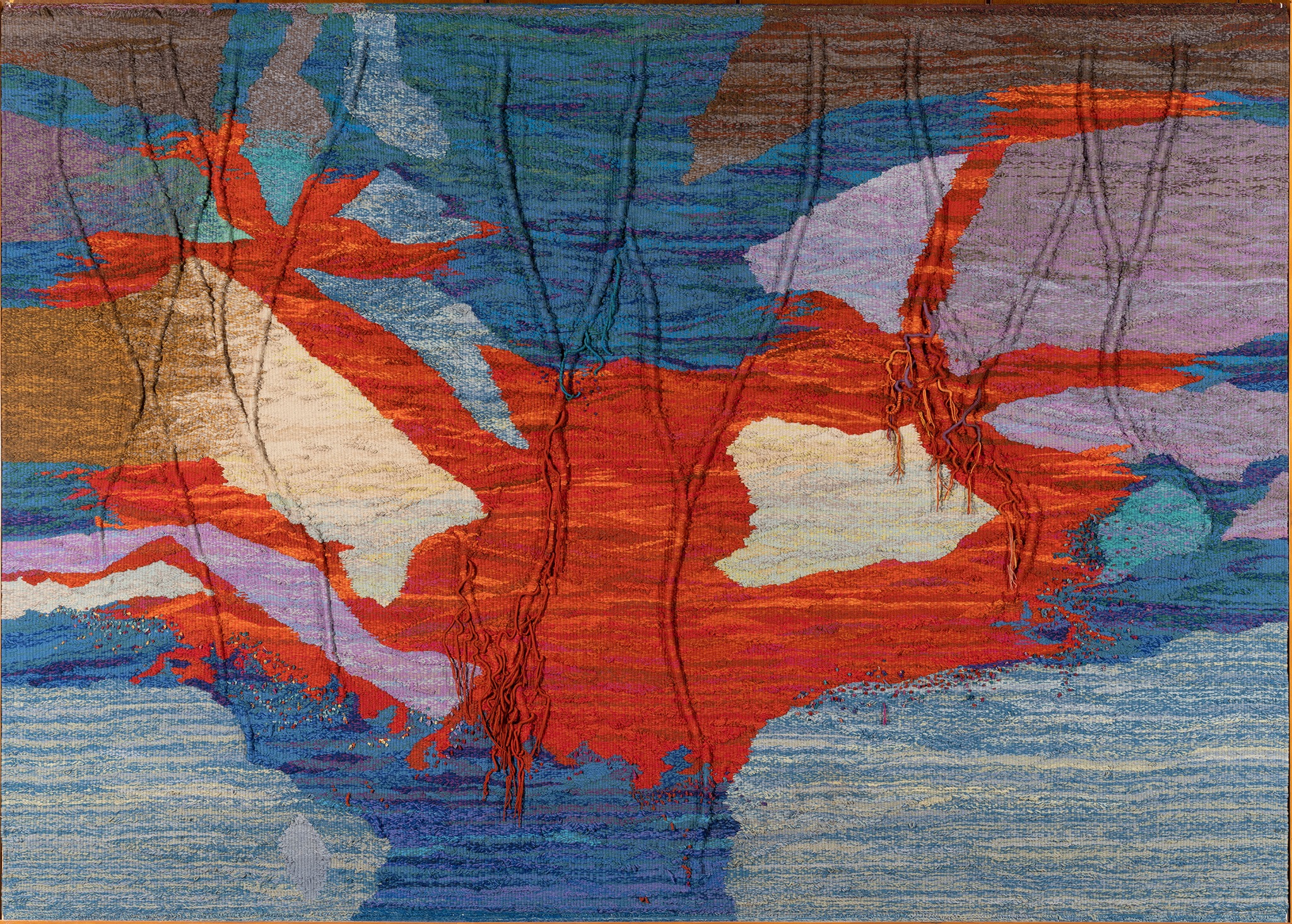
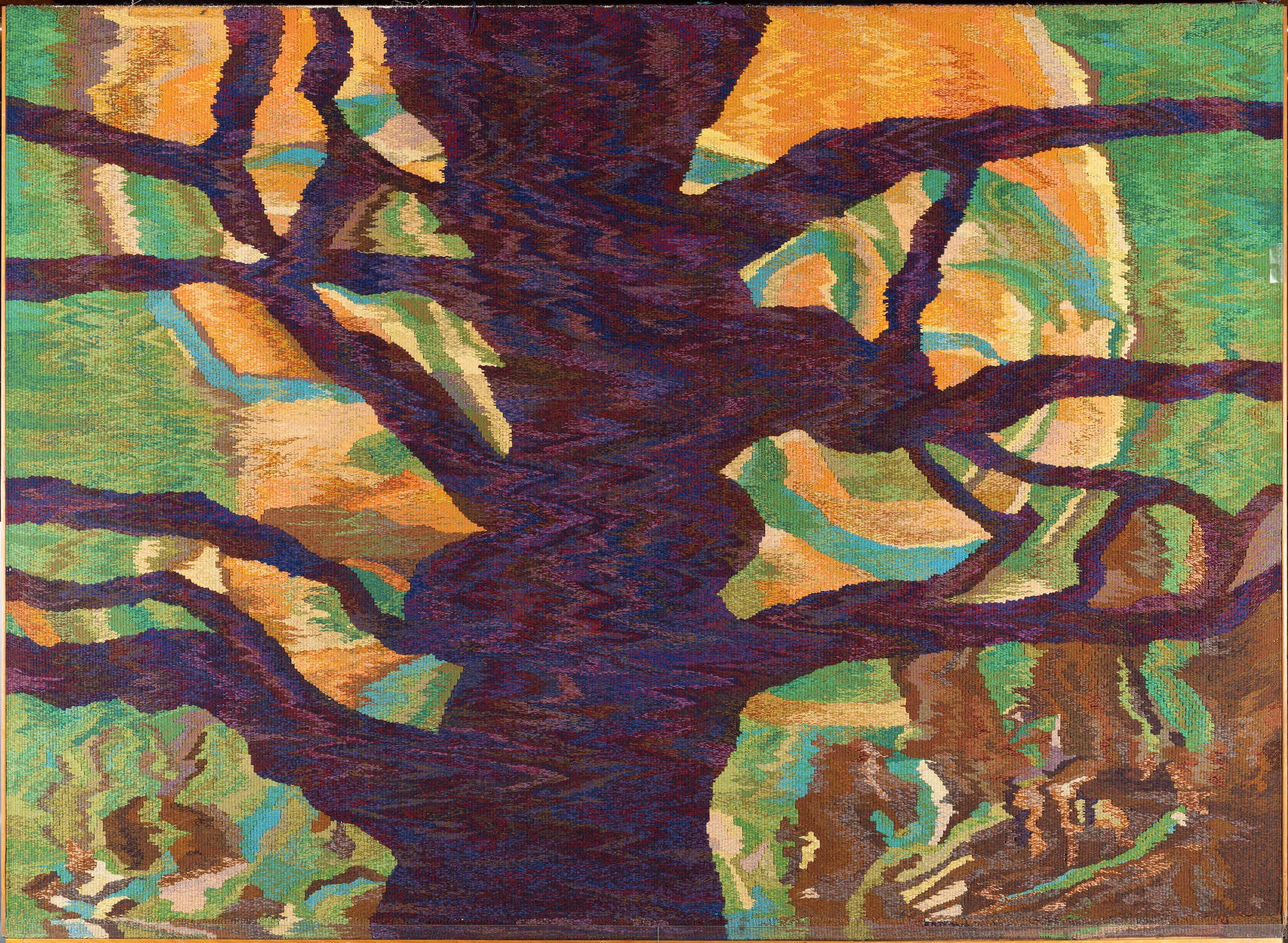
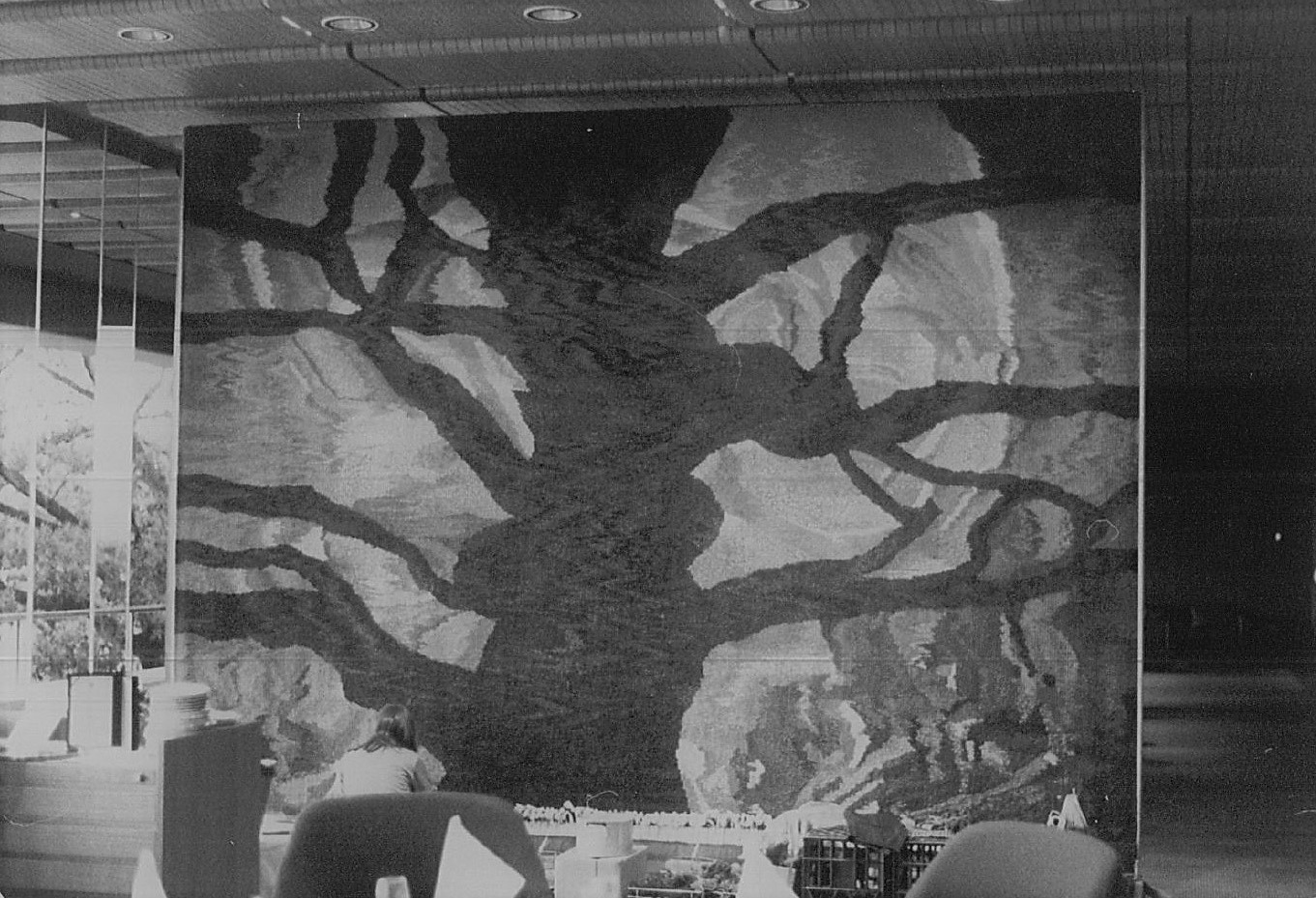
In 1955 the Barrenjoey Artists Commune had a visitor Artist in the late, great actress Katharine Hepburn during a tour with the Old Vic Company in 1955, which took her to Sydney, Melbourne, Brisbane, Adelaide and Perth. Hepburn, who died in 2003, painted several Australian landscapes, including views of Barrenjoey Lighthouse in Sydney. Mostly watercolours, these were auctioned in 2004.
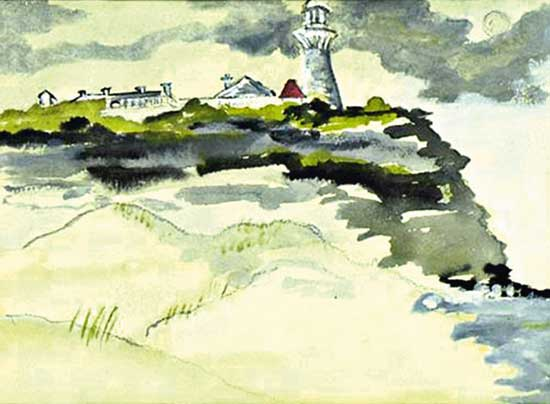
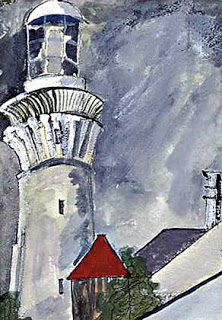
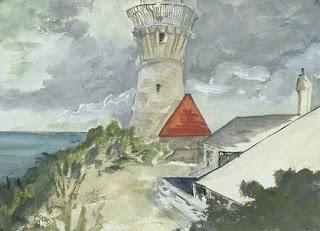
Jervis Sparks, born in Papua-New Guinea (Milne Bay) and educated at the Southport School, Queensland, resided with his Canadian born wife Bridget, at cottage 2, Barranjoey Lightstation, Palm Beach. Jervis leased Cottage 2 from 1968 until 1997 when the management of all Australian lightstations (now all automatic and without any keepers or other protective human presence) was transferred from Commonwealth control, under the Australian Maritime Safety Authority (AMSA), to state control, which in this case was the NPWS. Sparks continued to advise NPWS on all historical and environmental concerns concerning Barrenjoey Headland. Before leaving, Bridget and Jervis Sparks were awarded the first-ever issued Pittwater Medal by Pittwater Council for their years of volunteer, historical and environmental work for the benefit of Barrenjoey, Palm Beach.
In 2013 Pittwater Online interviewed Jervis Sparks. We asked Jervis; How did you end up living on Barrenjoey?
I had a girlfriend who years before lived with a group of artists in the main cottage. One day we decided to walk up to the lighthouse. We were down the bottom at the old pier, which is not there anymore. We sat there eating prawns and had a bottle of wine and then wandered up to the lighthouse and had a look around. They were all closed, the cottages.
So we decided to write and find out from the Department of the Interior who had the leases and if anyone wanted to give them up. On cottage 2, that guy wanted to start a motor car business out in the west and he needed money so he said, you can have the lease for a thousand dollars, then jumped it up to two thousand. But I had the money and said ‘there it is.’ And gave it to him and the rent was only fifty cents a week, this was in 1968.
And you stayed?
Yes, what a terrific place. Ok, it was ruined and what I did was work and work and work to restore it. I had to put on new roofing and painting, there were white ants and so much that needed doing – I was busy all the time. There was no electricity or running water – that was the big problem. First thing I did was build a septic system.
Anyone who speaks of your restoration notes that you worked hard on restoring the buildings as close to their original state as possible – how did you do that?
I went around a lot of second-hand shops and found a lot of Victoriana materials and of course I often worked in the field and would go to old farmhouses across the whole of NSW and would find all this old stuff thrown out in the junkyard.
Jervis passed away on October 31st, 2017, aged 84 years and a Tribute was held at his former home in 2018. His Notice read:
Loving husband of Bridget. Twin of the late Vernon Sparks and brother of Valasi Hey.
Late of Maleny, QLD and formerly for 30 years at Cottage 2, Barrenjoey Lighthouse, Palm Beach.
Challenging the notion of what is considered art, a vision that commenced before World War Two and was carried forward in practical terms, in earning a living from teaching as well as creating in Fahy Bottrell, or developing that to enrich a community, through the historic work and societies fostered by Collinridge Rivett, or applying this practically to a rising sport and art form, in the surfing and surfboards of Bruen Finey, also developed a uniquely Australian voice.
The Barrenjoey Artists Commune may have only lasted around five years, but its impact on our local Arts culture was an inspirational force that is still being felt today. The laughter and ideas that must have rung from that eyrie over Pittwater from a generation that had faced the horrors of conflict and resolved to move forward in a new and fresh way, to forge a future for themselves that inspired and inspires still so many others to 'have a go', even though the road will not be easy, safe, comfortable, has given us an ever coalescing reflection of ourselves that invites clarity as much as whimsical undefined texture into our own lives.
And all this began from an Australian Government program that recognised the Arts are where much is learned and inspired that can be applied elsewhere outside traditional Arts areas.
Investing in our nation's 'Social Infrastructure' so that may be expanded, all its works done; our local libraries and National and State Libraries, our National Archives, Galleries and Museums, our National Broadcaster in the ABC, encouraging and supporting students to go into the Humanities and Arts courses is just as vital as building other forms of infrastructure, for without this cultural soul we are nothing - we have no voice, no forms of expression, no archives to delve into to marvel at how we once thought and looked, what we dressed in, what we ate, where we served in conflicts, what we made to express that and what we made to evolve out of that.
As stated in this 1946 article, when the Barrenjoey Artists were commencing their studies, this is hard work but once pursued sets a person up for life - they not only have a job for life they also have a keeners sense of self through having followed their natural vocation and letting that, and themselves, evolve:
ARTISTS IN THE MAKING
IS an artist born or made?
When asked this question, our Art lecturers at the East Sydney Technical College, looked at each other and smiled. One answered, "An artist is born and made."
"Though talent is inborn, it is developed by teaching, and the mechanics of art is the result of long, hard work. The testing time really comes after the student period. It takes" upwards of 20 years to make an artist, and we have a student for only à few years.
"Some of our students have tremendous talent, hut they don't get far/because they don't apply themselves don't get round to the steady, persistent work that faces an artist before he is successful, either in pure art, or the practical application of art which earns a living in the commercial world.
"In the commercial field often the most talented students don't get as far as some of their less gifted fellows, because they are sensitive types, averse to fighting their way through, -where a student of merely average talent who has personality and push goes much further.
"Sydney is extraordinary rich in artistic talent. We are seeing the work of dozens of students, good, and bad. all day Jong. We no longer grow enthusiastic about merely good work. It has to be outstanding for us lo be moved by it, and in relation lo the ages of these students the quality of some of their work is truly amazing."
FAR more students wish to enrol for art courses than can be accommodated, so 'to secure the cream of the applicants' an entrance test is set. To keep the entries constant against 'the ever ,'increasing applications, the standard ' of these tests becomes higher and higher.
On the average, 80 percent, of the entrants finish their first year of a course. What becomes of the rest?
Many of the students are girls, and college authorities say with some regret that marriage interrupts further study. 'The art, careers, of some are interrupted by their 'taking ' jobs ' on the strength of their training.
One year, only two were left, two of all students at the end of their third year. All the rest had taken jobs.
The first two years for all students entering', the ','Tech." art course are devoted to general groundwork of art, the widest possible experience in the use of tools and equipment.
"The young students "are 'taught" the" fundamentals of drawing, the elements of perspective, design, modelling and painting. They learn the use of pencils, pens brushes and pastels, oils and acids, metal, clay and stone. They study anatomical detail from articulated skeletons, drawings and diagrams. Not till the second year do they gel round to life drawing one day a week-and not till the third year, when students begin to specialise, is this increased to two.
Though some students go through the stage of affecting an "arty" appearance, it doesn't matter much as long as their work measures up. And if it doesn't, ......,
But there is little need to call most of them back to their work'.'" They 'keep their noses down' to it: The atmosphere is of friendly striving, of achievement."
‘’This is the first art school I have seen which really looks like a workshop an American visitor once said. And from this workshop artists go out to earn success as sculptors or landscape painters, cartoonists, illustrators, designers, advertising layout specialists, creators of comics, designers of carpets, and cars, textiles and pottery, painters of theatre scenery and backdrops, posters and cards. There is plenty of scope for artists in this workaday world.
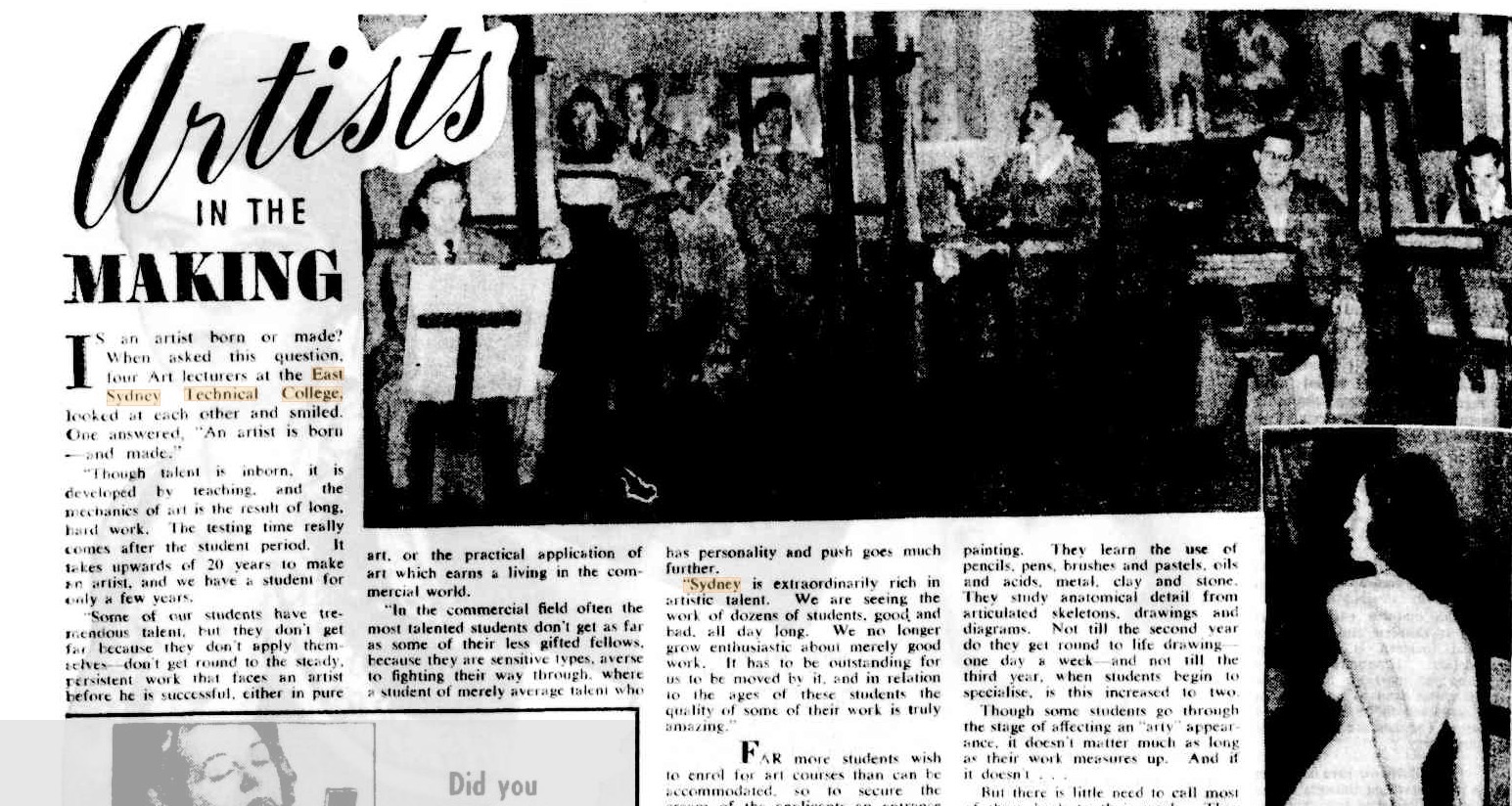
.png?timestamp=1648930671129)
EVEN the model is an ex-Service woman in these pictures of the life class in painting under the Commonwealth Reconstruction Training Scheme. From right, the students above are: W. Romain, Bette Passmore, Frank Norton (war artist, lecturer). Jack Horner, Fred Jessup, Tim Collie, and Garry Lynch. Below: Sculpture students O. Richmond (Tasmanian) and Dunlop (New Zealand). In circle: First-year students. artists IN THE MAKING (1946, May 21). The Sydney Morning Herald (NSW : 1842 - 1954), p. 6 (The Sydney Morning Herald Magazine.). Retrieved from http://nla.gov.au/nla.news-article17987711
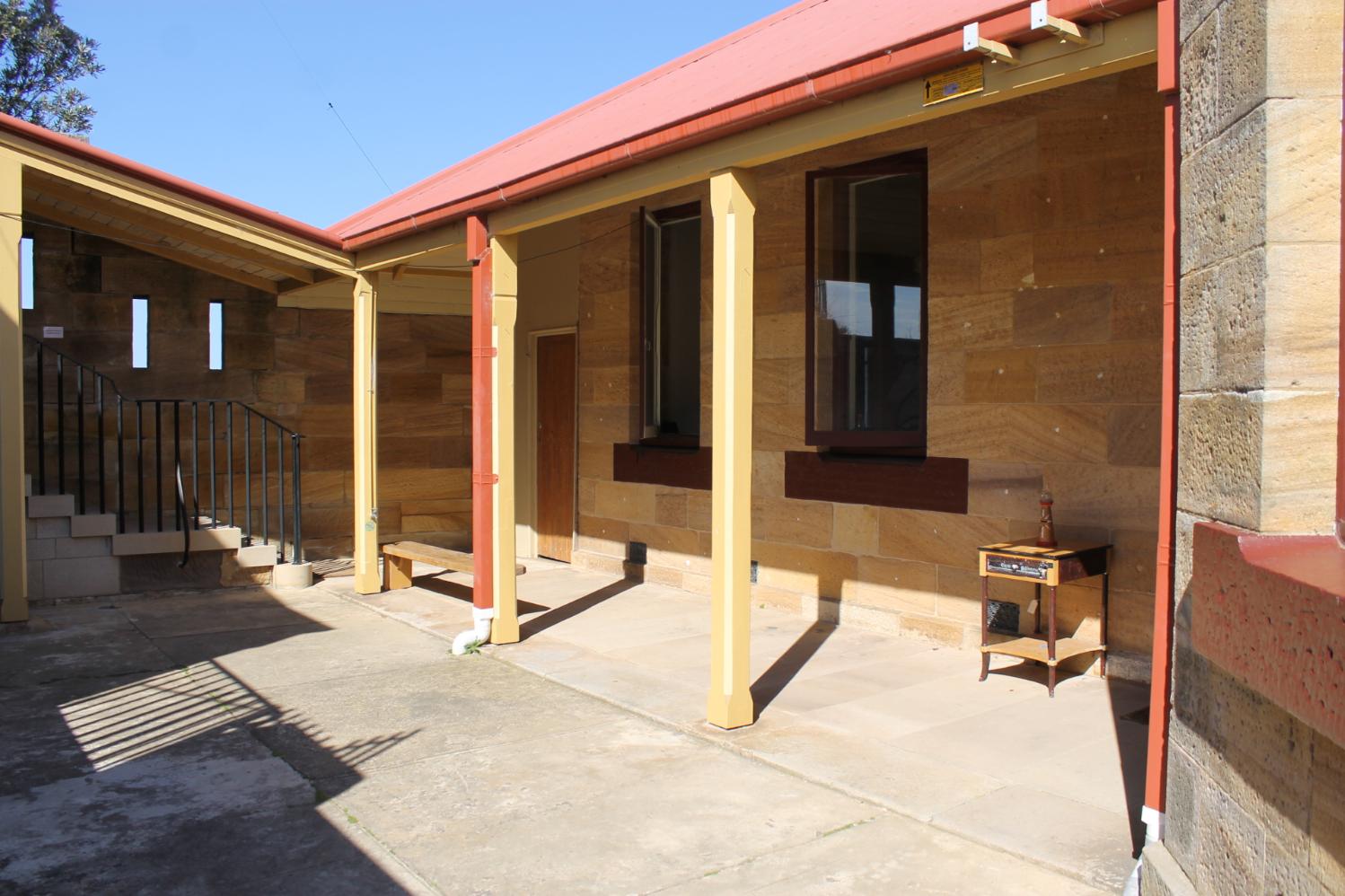
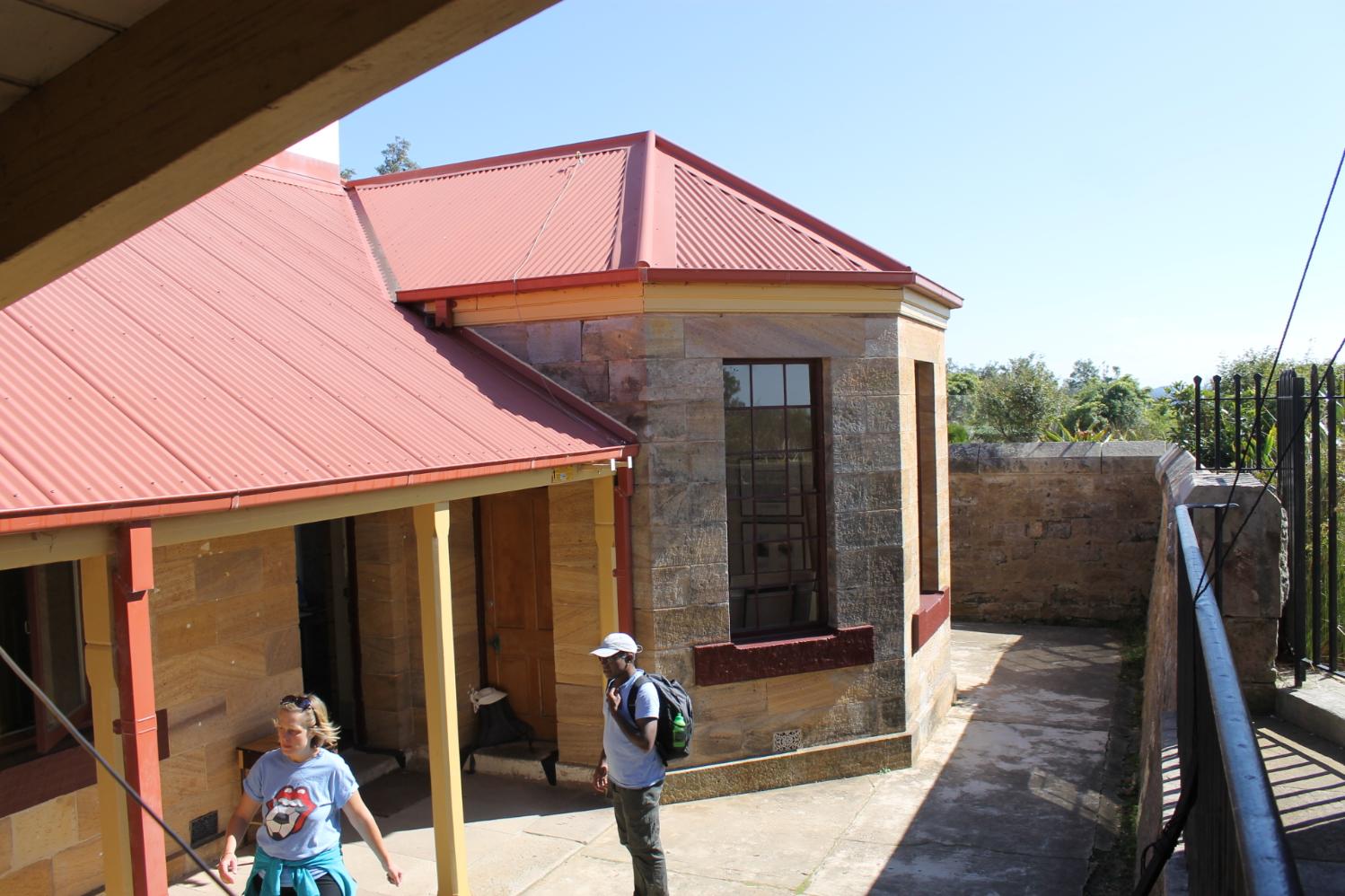
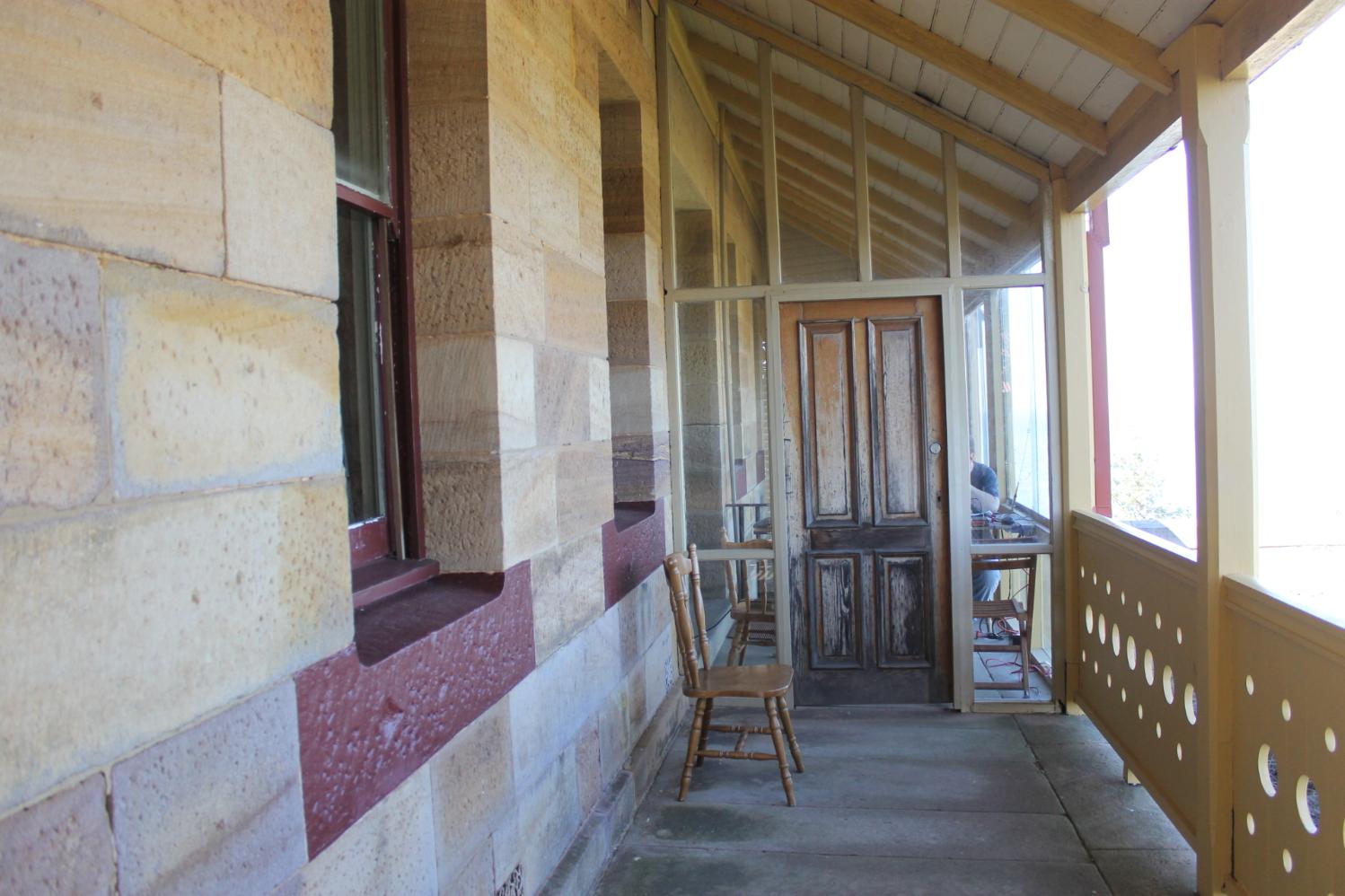
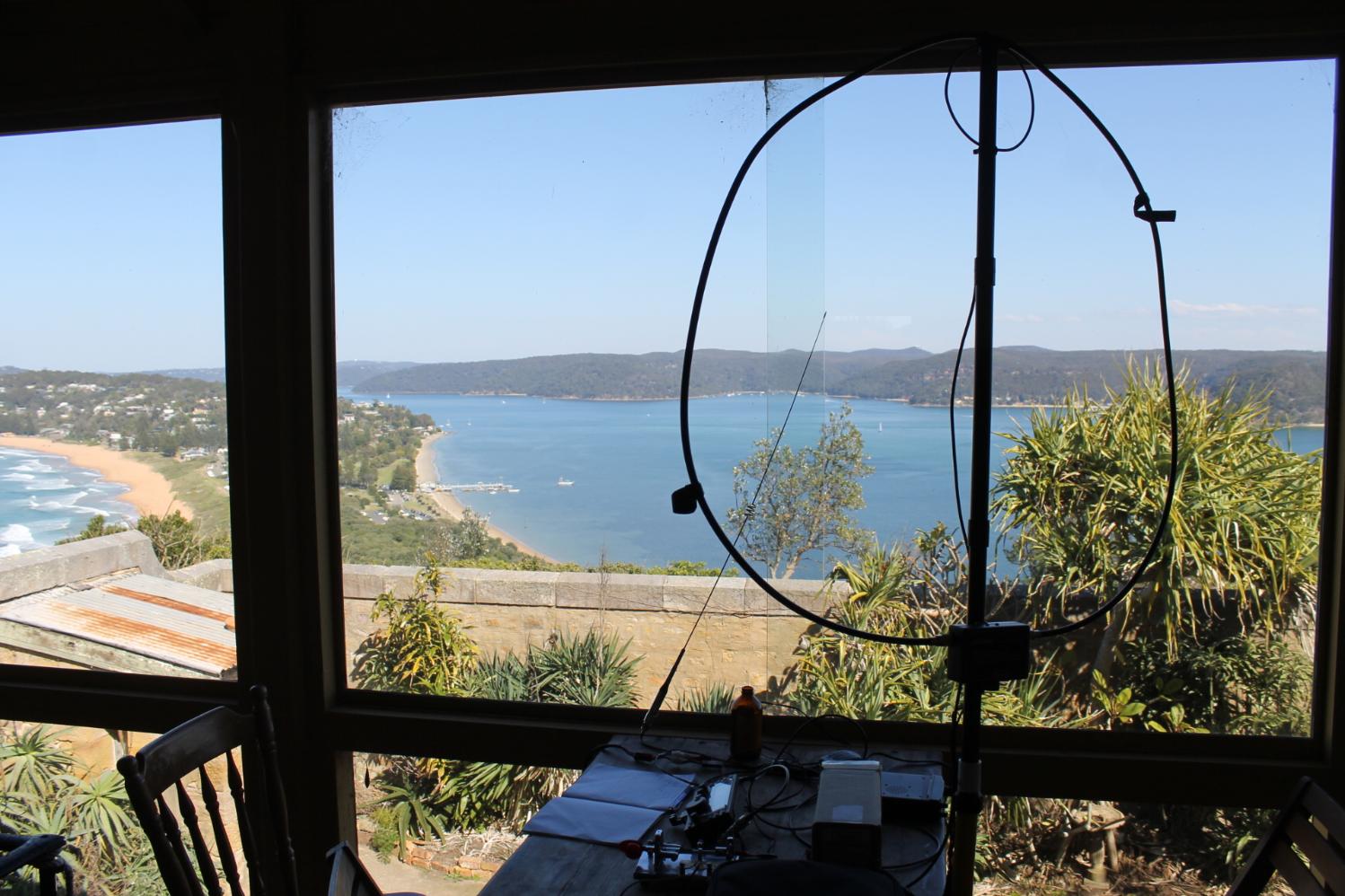
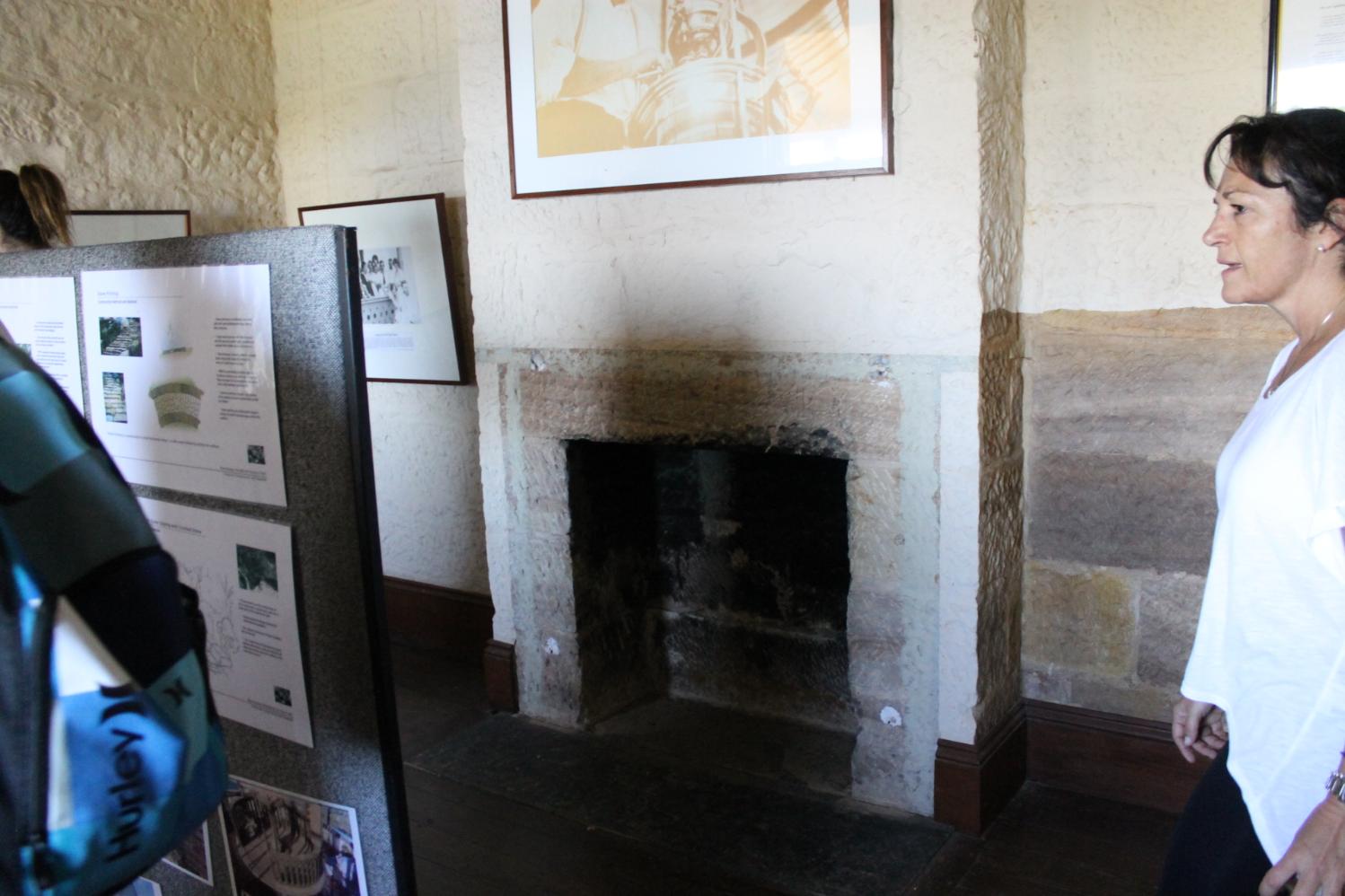
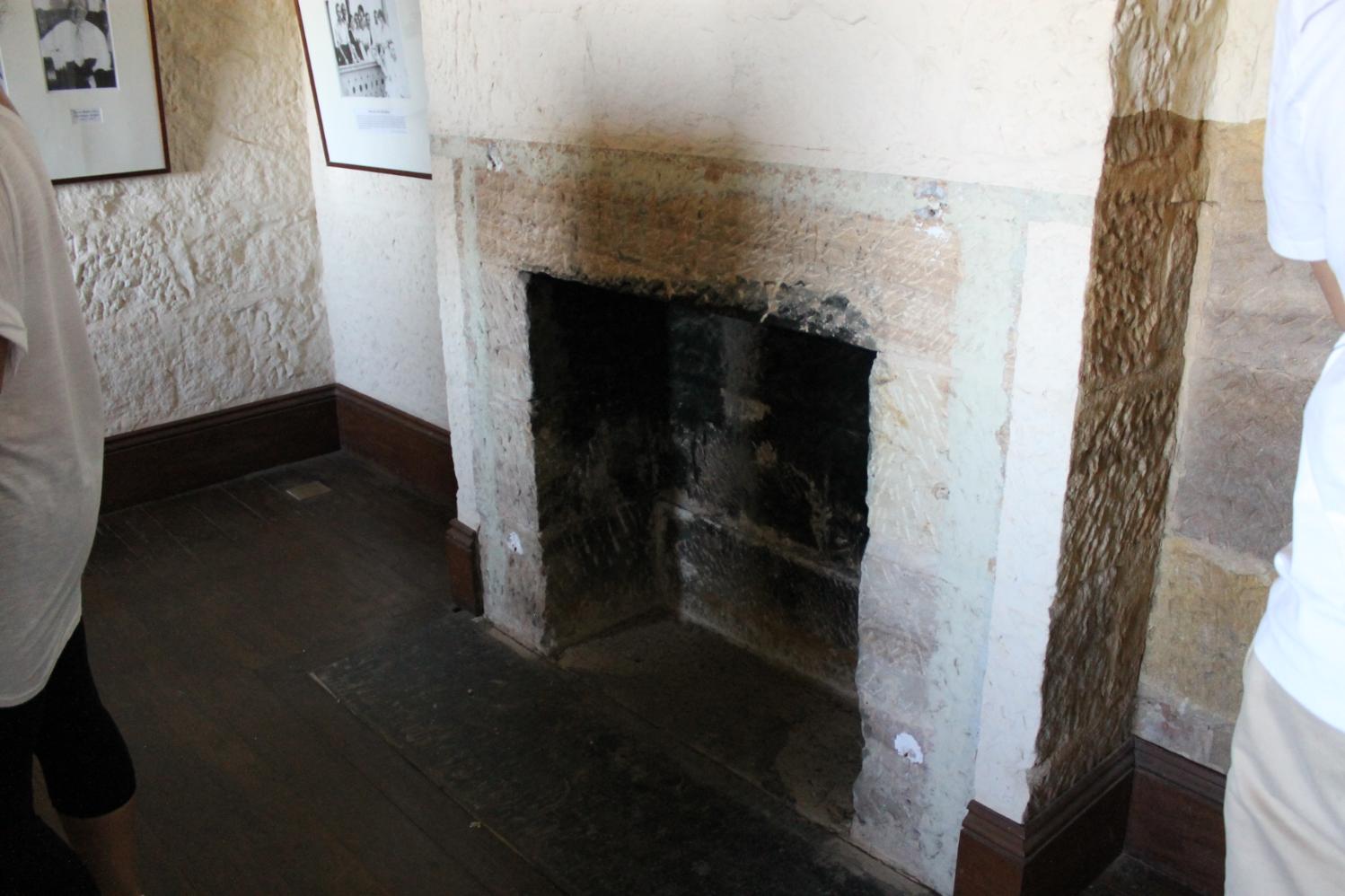

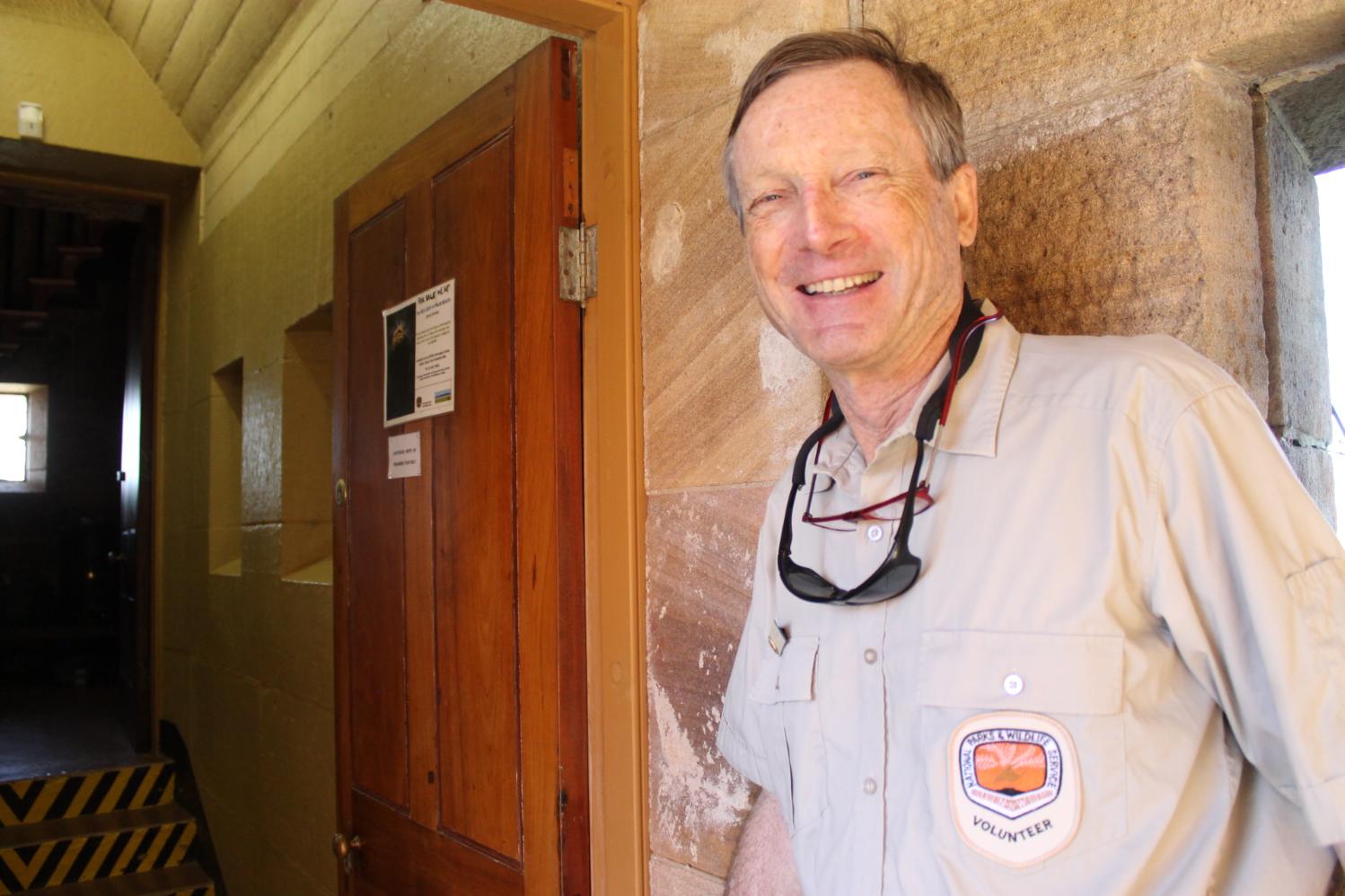
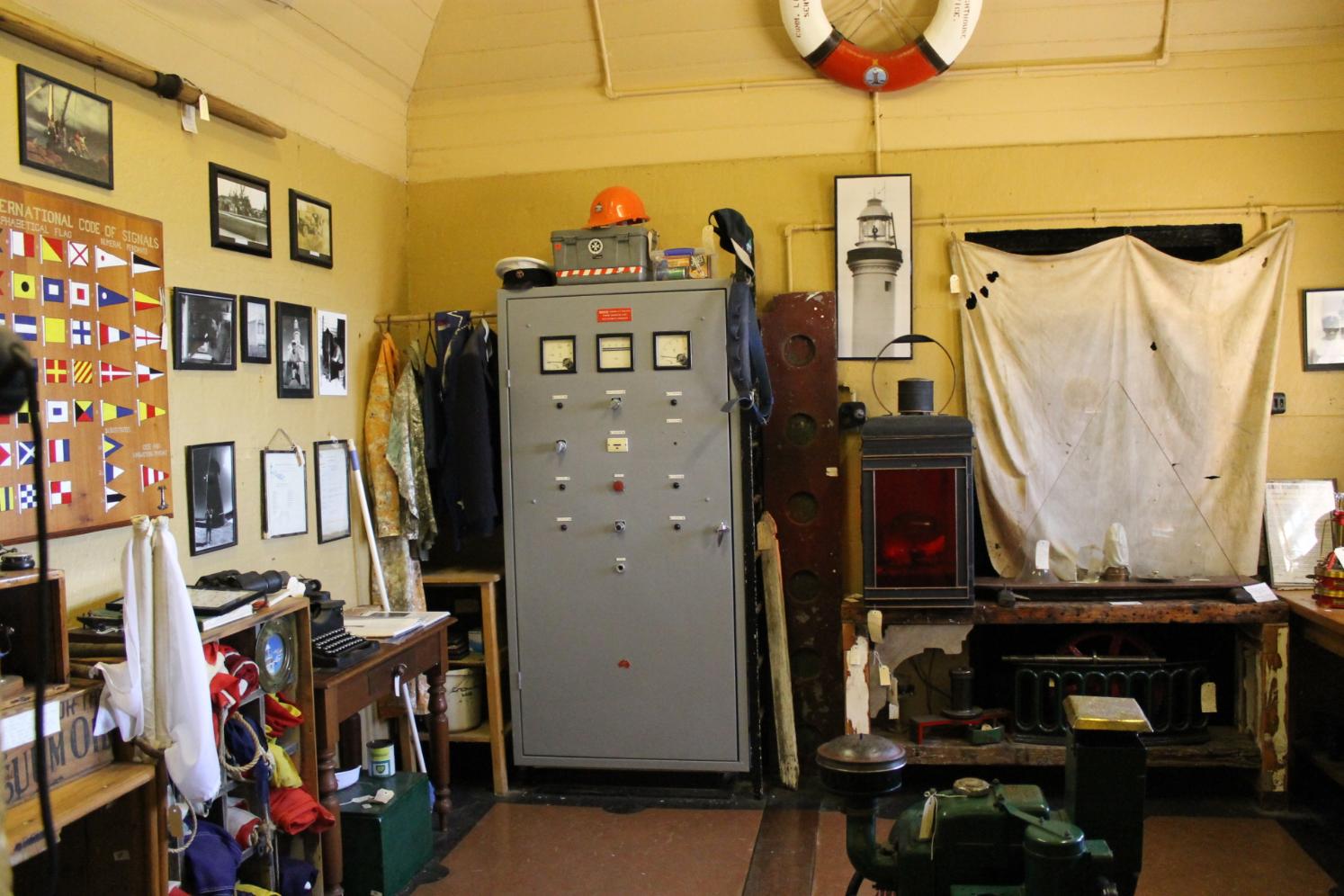
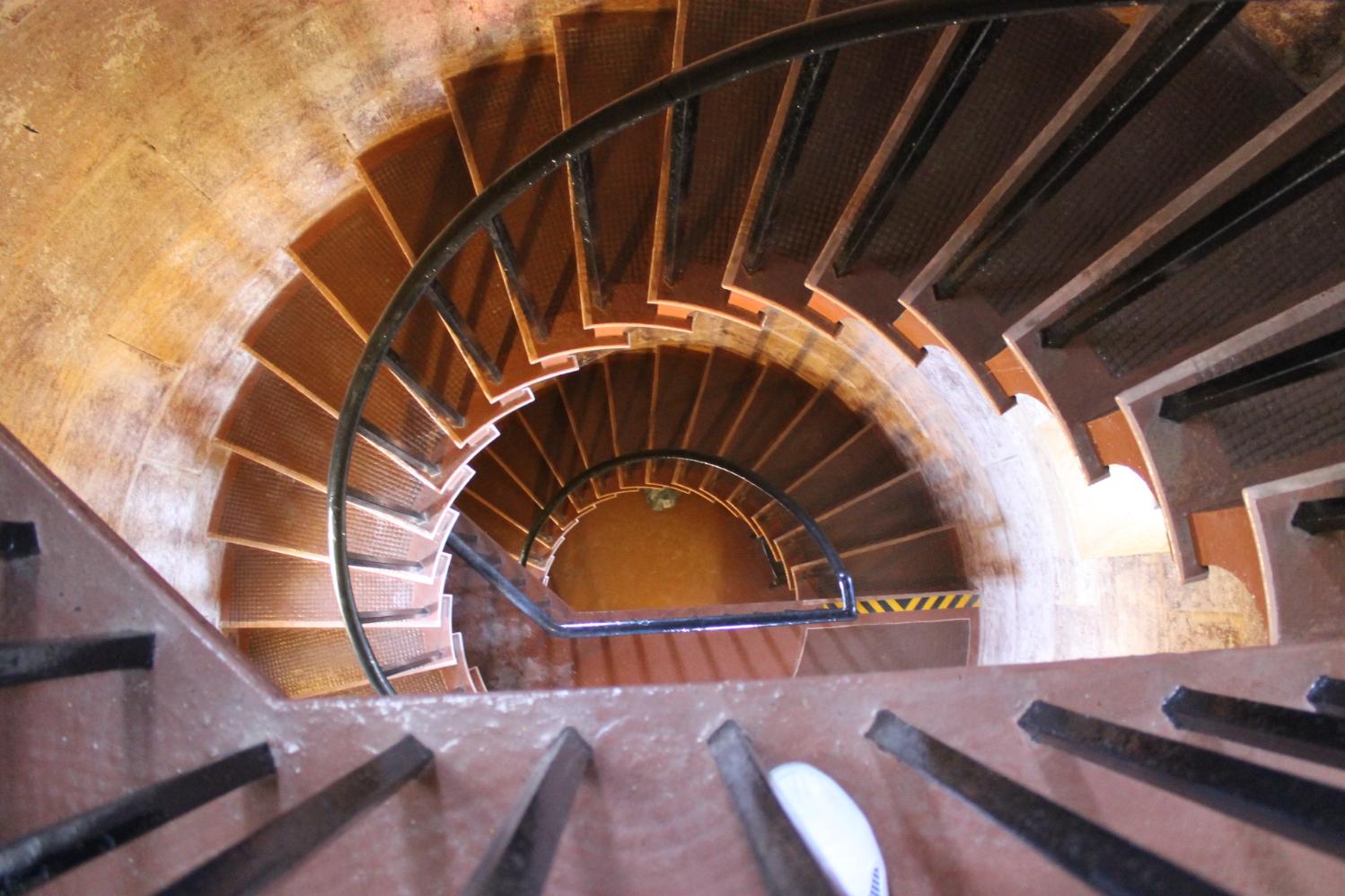
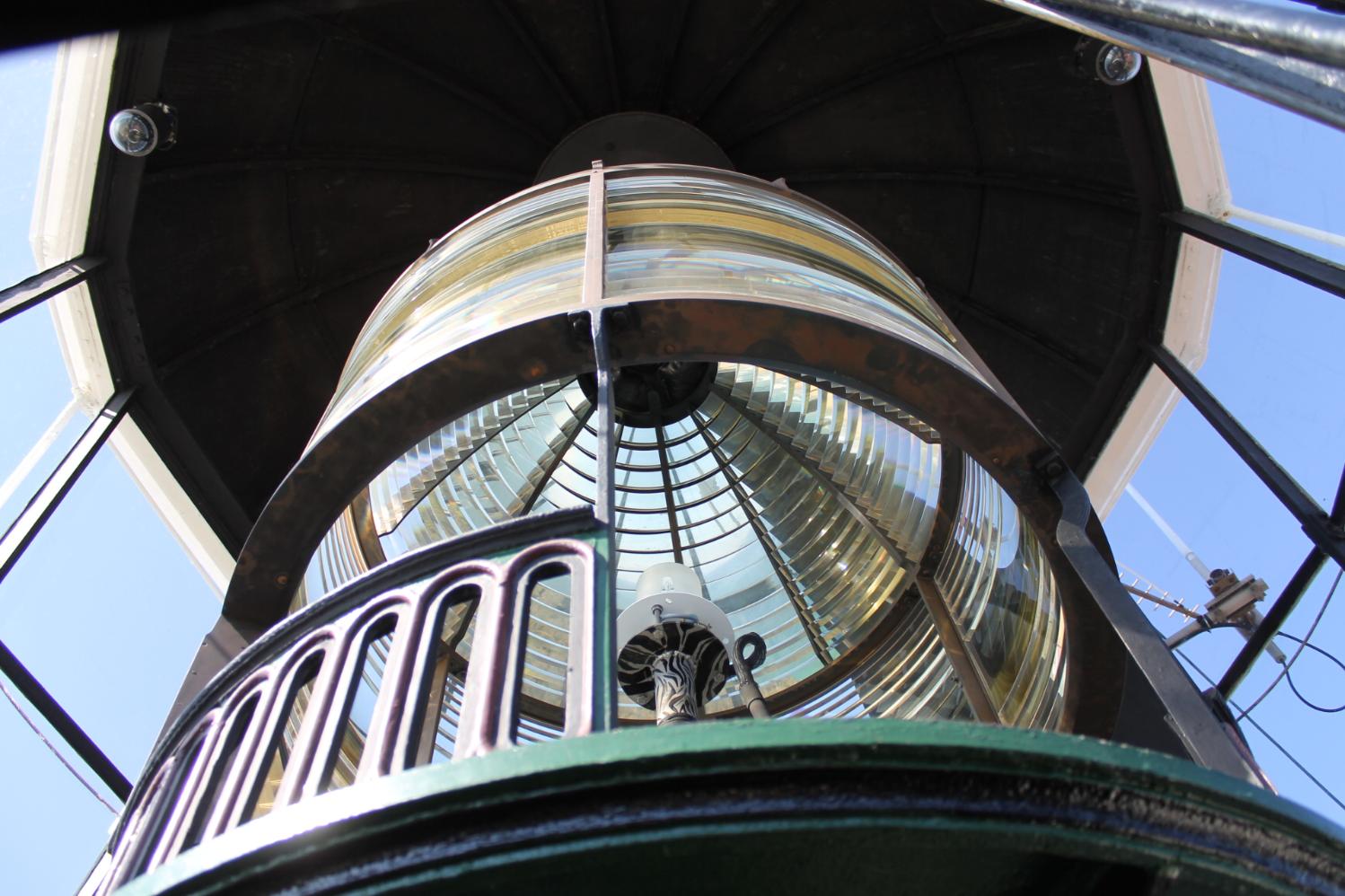
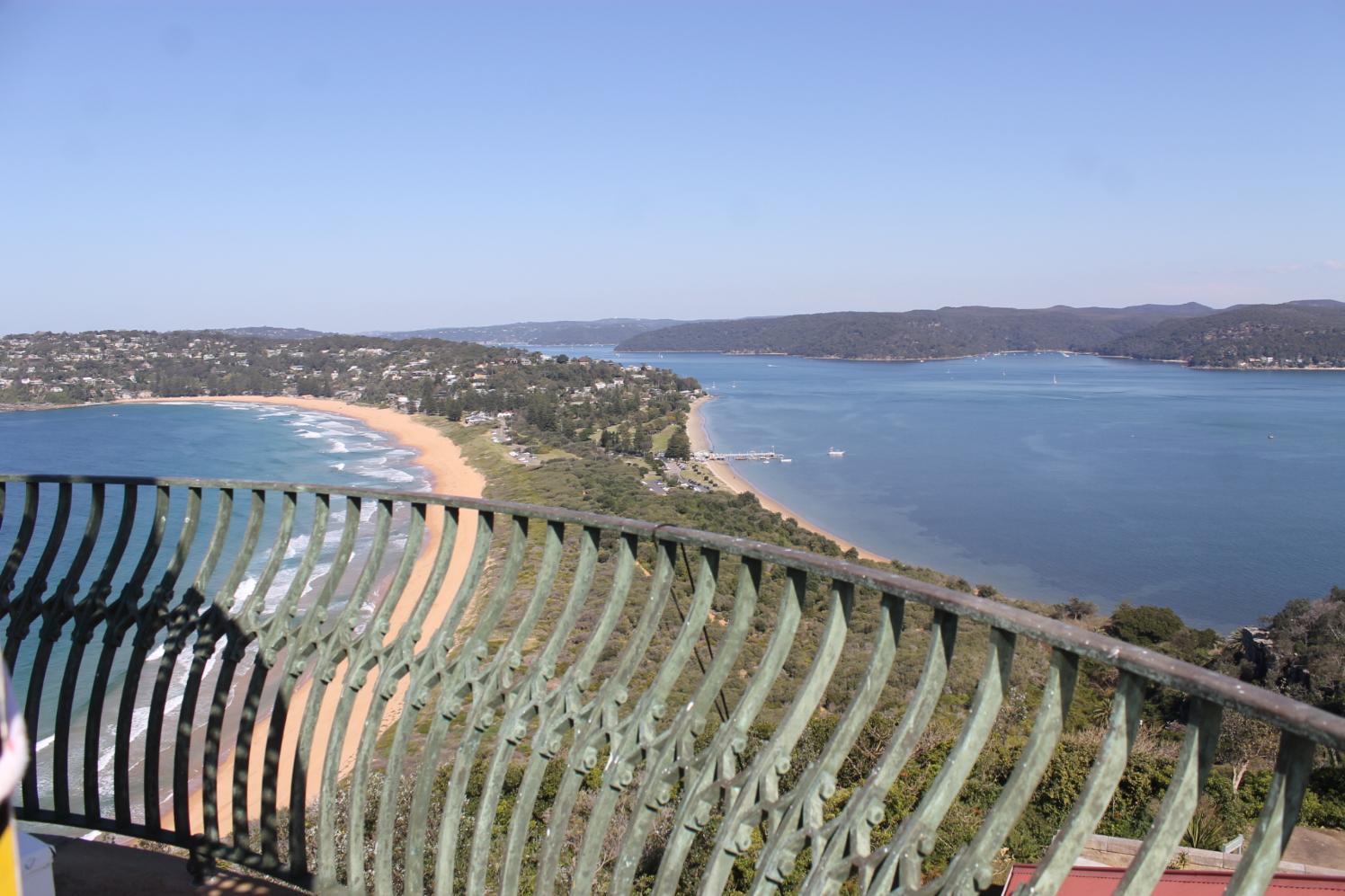
references and extras
- Peter Spearritt, 'Finey, George Edmond (1895–1987)', Australian Dictionary of Biography, National Centre of Biography, Australian National University, https://adb.anu.edu.au/biography/finey-george-edmond-12490/text22469
- TROVE - National Library of Australia
- State Library of New South Wales
- THE SYDNEY PUSH By George Repin AM, Pittwater Online News 2011, Issue 22
- REMEMBERING ROWE STREET By George Repin AM, Pittwater Online News, 2011 Issue 20
- The Northern Line An on-line journal dedicated to the life and work of John Anderson, No 2 Apr. 2007, Edited by Mark Weblin Retrieved from: https://setis.library.usyd.edu.au/anderson/contributors/weblin/tnl/tnl02.pdf
- By Olga Sedevna, ‘Corroboree: White Fella Vision’, Master of Art Curatorship thesis, University of Sydney, 2013 ;
- East Sydney Tech Records - 1946 - 1955: Betty McMillan - possibly Elizabeth Cecelia McMillan, friend Fahy Bottrell.
MCMILLAN, ELIZABETH CECELIA : Service Number - 105709 : Date of birth - 15 Nov 1920 : Place of birth - PADDINGTON NSW : Place of enlistment - SYDNEY : Next of Kin - MCMILLAN HUGH
Birth MCMILLAN ELIZABETH C 54226/1920 HUGH E JULIA PADDINGTON
Parents marriage; 34/1911 MCMILLAN HUGH E COLEMAN JULIA SYDNEY
Father’s death: MCMILLAN HUGH EDWARD 11552/1949 parents; JAMES HENRY and MARY CAROLINE registered at LIVERPOOL
McMILLAN, Hugh Edward - April 27, 1949, at hospital, dearly beloved husband of Julia McMillan and loved father of James, Hugh, Molly, William, and Betty, aged 64 years. At rest.
McMILLAN, Hugh Edward -April 27, 1949, son of Mary Caroline and the late James Henry McMillan and brother of Alice (Mrs. Hansen), Ada (Mrs. Howard), and John, (James Henry and Harold deceased). Family Notices (1949, April 28). The Sydney Morning Herald (NSW : 1842 - 1954), p. 16. Retrieved from http://nla.gov.au/nla.news-article18113119
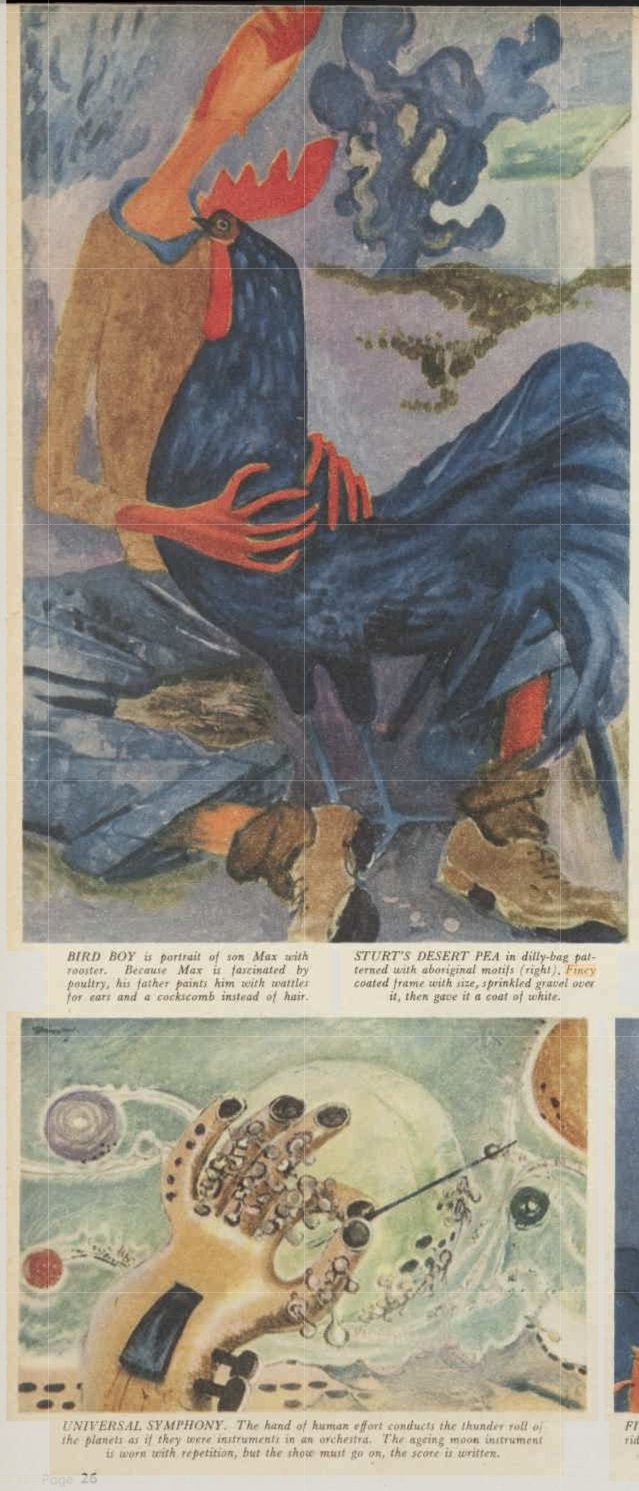
.jpg?timestamp=1648503443007)
.jpg?timestamp=1648503533667)
Circuit diagrams by David Hain - MAAS Collection https://collection.maas.museum › object
Circuit diagrams (2), paper, by David Hain, Sydney, New South Wales, Australia, 1947. Two pieces of paper with hand drawn circuit diagrams in blue and black ... Circuit diagrams by David Hain - MAAS API Documentation https://api.maas.museum › object
Circuit diagrams (2), paper, by David Hain, Sydney, New South Wales, Australia, 1947. Two pieces of paper with hand drawn circuit diagrams in blue and black
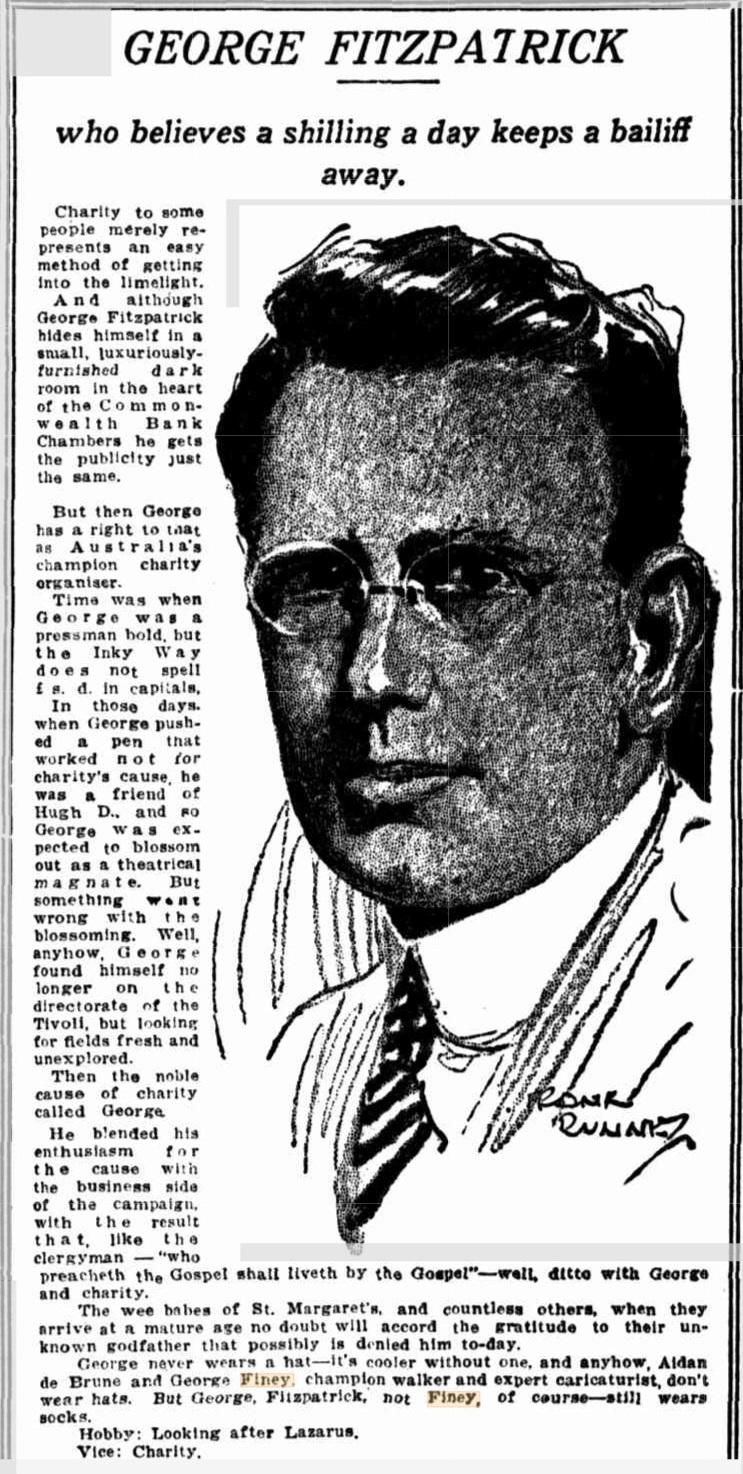
GEORGE FITZPATRICK (1924, September 28). Truth (Sydney, NSW : 1894 - 1954), p. 8. Retrieved from http://nla.gov.au/nla.news-article168713504
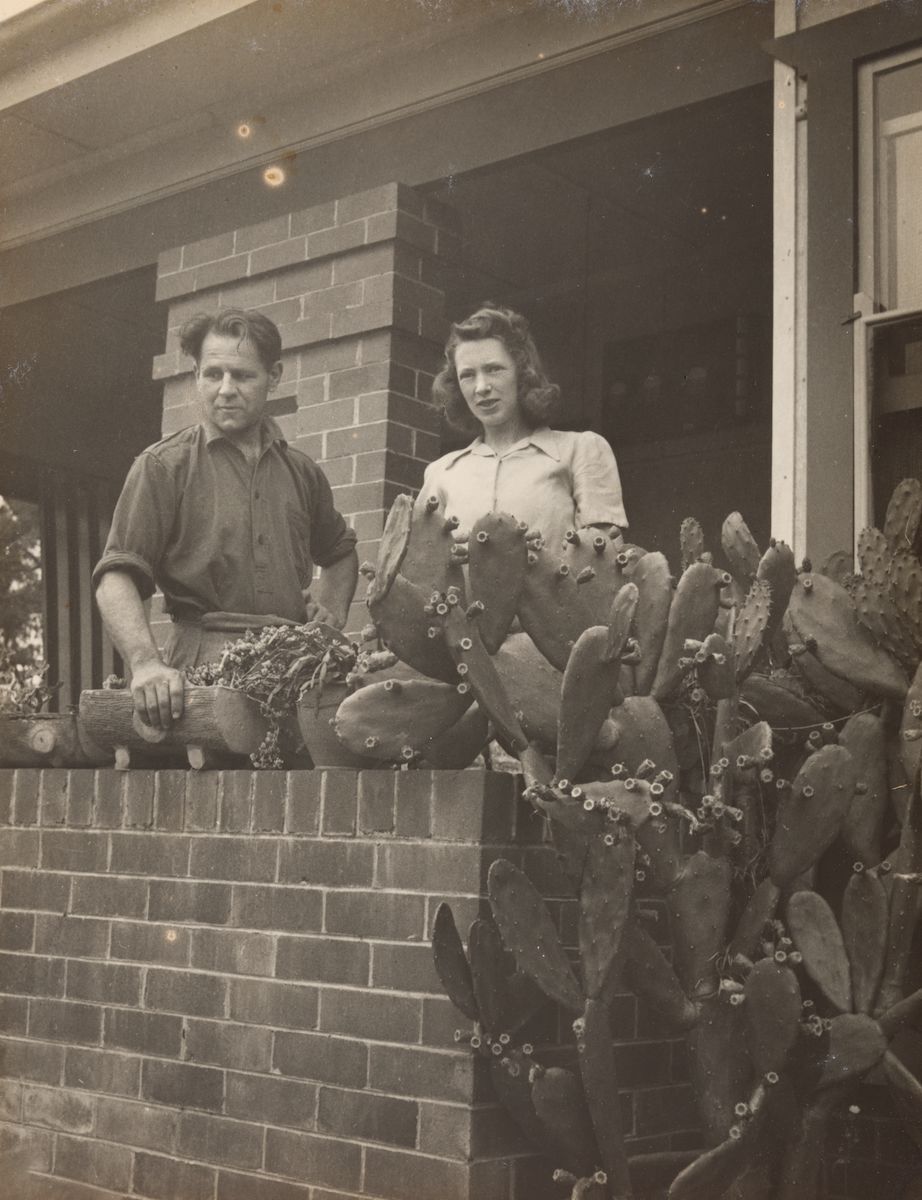
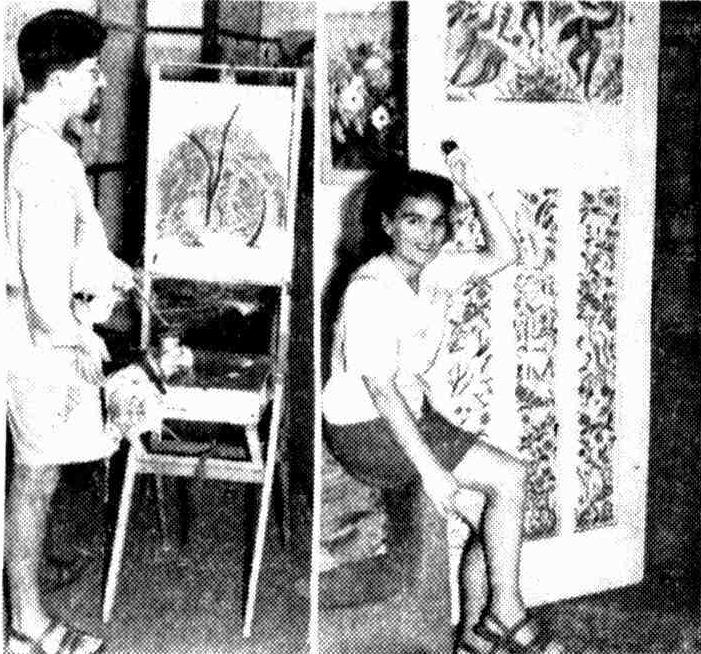
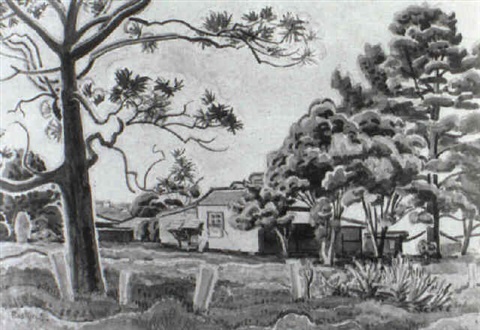
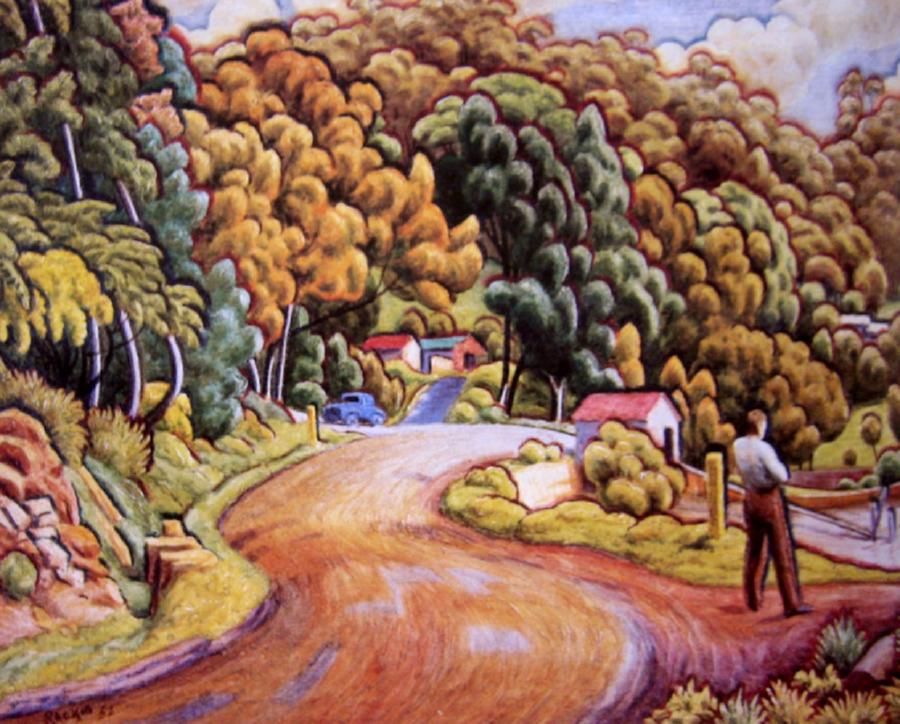
Arthur Murch Wins Archibald Prize. SYDNEY, January 20.
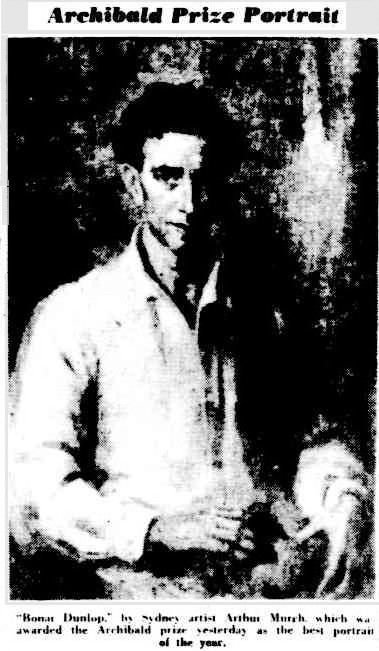
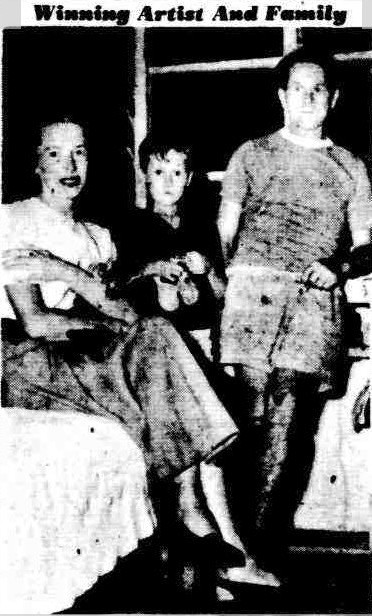 Forty-eight-year-old Avalon (Sydney) artist Arthur Murch is the winner of the 1950 Archibald art prize. He was awarded the prize — which carried with it about £500 prize money— today by the trustees of the National Art Gallery. Sydney. His winning entry was a portrait of another Sydney artist, Bonar Dunlop, of Whale Beach. The trustees inspected 144 entries during the past few days before reducing the number to a few from which the final selection was made today. Simultaneously with the announcement of the Archibald prize, two other leading art awards were also made. They were:— The Wynne Prize for Landscape —Awarded to George F. Lawrence. 48, of Cliff road. North wood, Sydney. The Sir John Suliman Prize for Mural Painting — Awarded to J. Carrington Smith, 42, of Hobart, Tasmania.
Forty-eight-year-old Avalon (Sydney) artist Arthur Murch is the winner of the 1950 Archibald art prize. He was awarded the prize — which carried with it about £500 prize money— today by the trustees of the National Art Gallery. Sydney. His winning entry was a portrait of another Sydney artist, Bonar Dunlop, of Whale Beach. The trustees inspected 144 entries during the past few days before reducing the number to a few from which the final selection was made today. Simultaneously with the announcement of the Archibald prize, two other leading art awards were also made. They were:— The Wynne Prize for Landscape —Awarded to George F. Lawrence. 48, of Cliff road. North wood, Sydney. The Sir John Suliman Prize for Mural Painting — Awarded to J. Carrington Smith, 42, of Hobart, Tasmania.
Lawrence's winning entry was a scene titled 'Two Rivers,' depicting sections of the Lane Cove and Parramatta rivers, Sydney, with a portion of Cockatoo Island dockyard in the background. Smith's winning mural en- titled 'Bush Pastoral' is a pro posed mural for the new State building, Tasmania. The Wynne award carried a prize of £60 and the Suliman prize £90. Today's Archibald prize success by Murch adds to his successes in a brilliant art career extending over more than 20 years. This year's winning entry was his ninth attempt to win the contest. Both Murch and Lawrence were listening to the radio in their studios when details of the awards were broadcast.
'I just went on painting,' Murch said later. Murch described the portrait of Dunlop as being something different from his previous en tries for the Archibald prize. 'I did feel that I had got a little more richness into it this time, although I had no idea I would win the prize,' he said. The portrait was started solely as a demonstration of form for Dunlop, who was a student of his, Murch added. The prizemoney would be used to pay off a few debts and to complete the bush home he is building at Avalon. At present the house consists of only two rooms. George Lawrence, winner of the Wynne prize, said his friends used to call him a week end painter. He has been trying to win the Wynne award for four years. The Suliman prize-winner, J Carrington Smith, who is holidaying with his wife and three children at Lufawanna, Bruny Island, also heard of his success on the radio. 'I thought I had a chance,' he said.
Above Left: Winning Artist And Family: Archibald prizewinner Arthur Murch, with his wife and son at their home at Avalon Beach, north of Sydney, last night. Above right: Archibald Prize Portrait 'Bonar
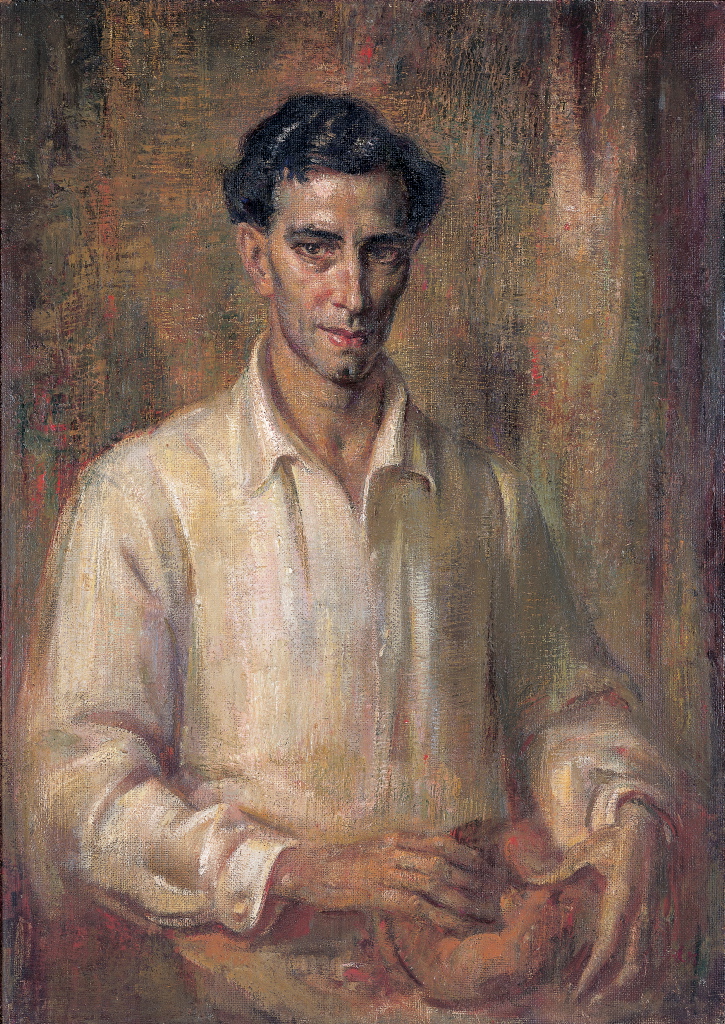
Gertrud Bodenwieser (1890-1959), dancer, choreographer and teacher, was born on 3 February 1890 in Vienna, younger daughter of Johann Theodor Bondi, auction-broker, and his wife Maria, née Tandler. Taught at home by governesses, from an early age Gertrud showed a talent for dancing. In c.1905-10 she was trained in classical ballet by Carl Godlewski, but soon recognized that this art form had 'become a mere exhibition of virtuosity'. Proponents of the New Dance, such as Isadora Duncan and Ruth St Denis, had already appeared in Vienna. From 1910 Gertrud began to develop her own style, aiming to motivate 'the most primordial powers of human sensibilities'. She was influenced by cultural and spiritual renewals occurring in Vienna at the turn of the century, and by pioneers of the New Dance, including François Delsarte, Rudolf von Laban and Emile Jacques Dalcroze. By 1917 she had adopted the surname 'Bodenwieser'. She made her first appearance on 5 May 1919 at the Wiener Konzerthaus with six numbers; the novelty of her style was recognized and praised by critics. Convinced that the New Dance required thorough training, Bodenwieser soon provided instruction at her private school (1919-20) and at the Neues Wiener Konservatorium.
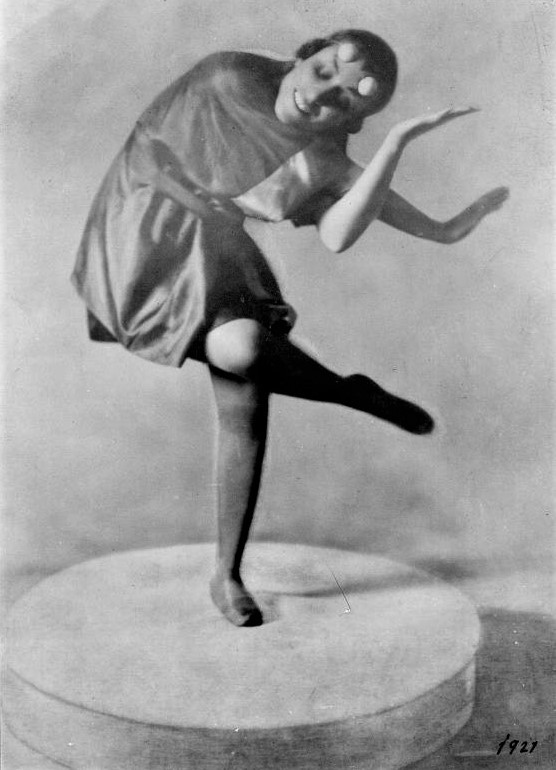
Gertrud Bodenwieser, 1921. Photo: Franz Lowy
On 27 June 1920 in Vienna she married with Jewish rites Friedrich Jacques Rosenthal, a theatre director; they were to remain childless. Between 1920 and 1938 Gertrud taught on a contract basis at the Akademie für Musik und Darstellende Kunst. She incorporated Dalcroze's system into the foundations for her curriculum at the academy and in 1922 appeared with a group of pupils. She was appointed professor in 1928.
From an early stage she had co-operated with the Sprechtheater (living theatre). With her husband's assistance, the 'Bodenwieser-Gruppe' appeared in the 1923 production of Ferdinand Raimund's Der Verschwender at the Deutsches Volkstheater, a production in which the dance was considered to have equal merit with the spoken word, music, costumes and design. In 'Klabund's' Der Kreidekreis her dancers functioned as a mimic choir as well as stagehands. Bodenwieser collaborated with Max Reinhardt in the 1927 production of Das Mirakel; she subsequently taught (1932-34) gymnastics and the dance at Reinhardt's 'seminary'.
Numerous tours from 1926 onward provided her ensemble with essential funds; two of her groups often performed simultaneously in different countries.
Of great significance in Bodenwieser's work was Dämon Maschine (1923)—part two of the dance-drama Gewalten des Lebens—which won several awards in international dance competitions. The performance explored the sinister impact of industrialisation as ‘the machine’ threatens to take over people’s lives and freedom. The dancers would begin by moving freely and individually before gradually becoming parts of a larger machine, moving mindlessly together.
The dramatic performance was enhanced by the sharp, modernist lines and striking colours of the costumes, echoing the ominous power of the ‘demon machine’.
Gertrud usually danced the role of the Dämon herself (until retiring from the stage in 1934); this item formed part of almost every programme of her guest performances and in 1931 was awarded a first prize at Florence, Italy. Bodenwieser regarded the 1934 tour of Japan as also providing an opportunity to publicize Austria: the Wiener Walzer (Viennese Waltz) was invariably performed at the end of each programme.
In her non-abstract dance-dramas, such as Wer will Frau Wahrheit Herbergen? (1930) and Die Masken Luzifers (1936), in which Lucifer personifies intrigue, terror and hatred, Bodenwieser analysed the disintegration of humane values in an era of political totalitarianism. The message of these dance-dramas was prophetic, not only in relation to the impending calamity for the world, but also for the Rosenthals.
Following the Nazis' invasion, she and her husband were forced to flee from Austria in May 1938. Gertrud joined some of her dancers in Bogota, Colombia; Jacques went to France, was apprehended by the Gestapo, interned and died in the concentration camp at Auschwitz, Poland, after August 31 1942.
On her arrival in Sydney on August 23rd 1939, Madam Bodenwieser was met by her main group which had just completed a tour in Australia. Continuing to display amazing energy and creative productivity, she gave recitals, opened a studio and prepared a tour of the Australian capital cities for 1940. Although utterly unaccustomed to her style of dancing, audiences and critics reacted with enthusiasm. During the war she arranged frequent performances for the war effort and for charity.
Gravitating to Kings Cross, she became a familiar figure, dressed always in black, and absorbed in her thoughts and dreams. Her inability to discover the fate of her husband frustrated her efforts to become naturalized until 1950, when he was pronounced dead by a court in Vienna. In her Pitt Street studio she created and rehearsed works for her recitals and tours, entertained visitors and trained her dancers. She conducted a wide range of classes, from creative dance movement for young children to mime and movement for professional actors (attended by Peter Finch and Leonard Teale). Bodenwieser also taught at well-known schools, Hopewood House and Abbotsleigh, and for the Young Women's Christian Association; in addition, she ran classes for the Workers' Educational Association, the National Fitness Council and the Australian College of Physical Education.
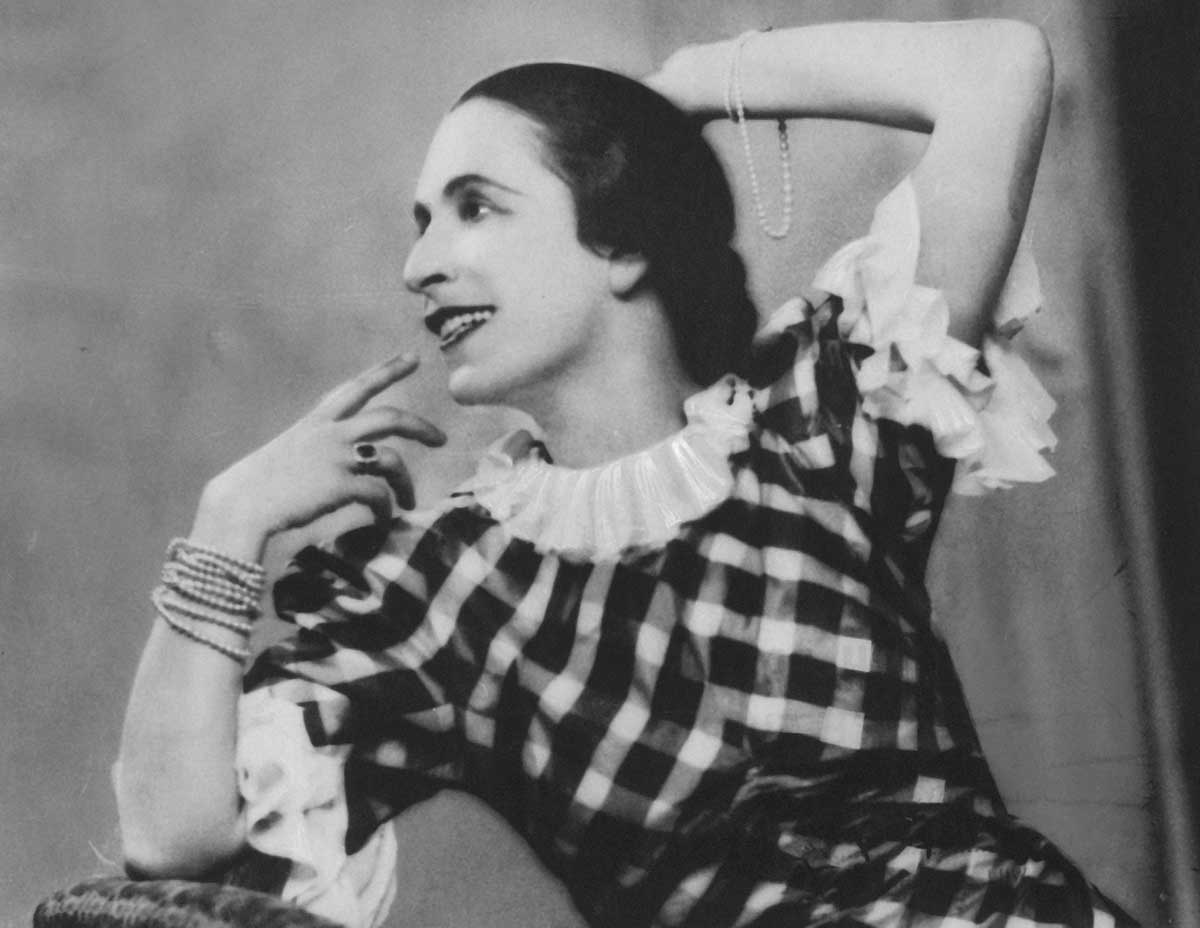
Gertrud Bodenwieser
Always rather fastidious, with beautiful, dark hair and eyes, she seemed small beside her Australian dancers. In manner she was somewhat self-deprecating, but, beneath the grace and charm, she was utterly determined, even ruthless, in pursuit of her artistic aims. Bodenwieser choreographed group dances, solo dances, dance-dramas and comedies, as well as dances for operettas, plays and musical comedies. Her new major dance works, Cain and Abel (1941), O World (1945), The Life of the Insects (1949) and Errand into the Maze (1954), continued to express the gamut of human experience.
From 1940 to 1954 the Bodenwieser Ballet toured Australian cities and country centres. The ensemble was chosen to make the first use of the Arts Council of Australia's mobile theatre unit to bring cultural entertainments to remote areas. She took her company on tours to New Zealand (1947 and 1949-50), South Africa (1950), Rhodesia (1950) and India (1952).
Her dancers took part in the film, Spotlight on the Australian Ballet (1948), and two of her comedy ballets were televised (1958) by the Australian Broadcasting Commission. Gertrud Bodenwieser died of a coronary occlusion on 10 November 1959 at her Potts Point flat and was cremated. She explained her artistic origins in her posthumous book, The New Dance (1970). Her significance has been acknowledged in the establishment of the Bodenwieser Dance Centre and the Gertrud Bodenwieser Archives in Sydney. From: Marie Cuckson and H. Reitterer, 'Bodenwieser, Gertrud (1890–1959)', Australian Dictionary of Biography, National Centre of Biography, Australian National University, https://adb.anu.edu.au/biography/bodenwieser-gertrud-9532/text16785, published first in hardcopy 1993
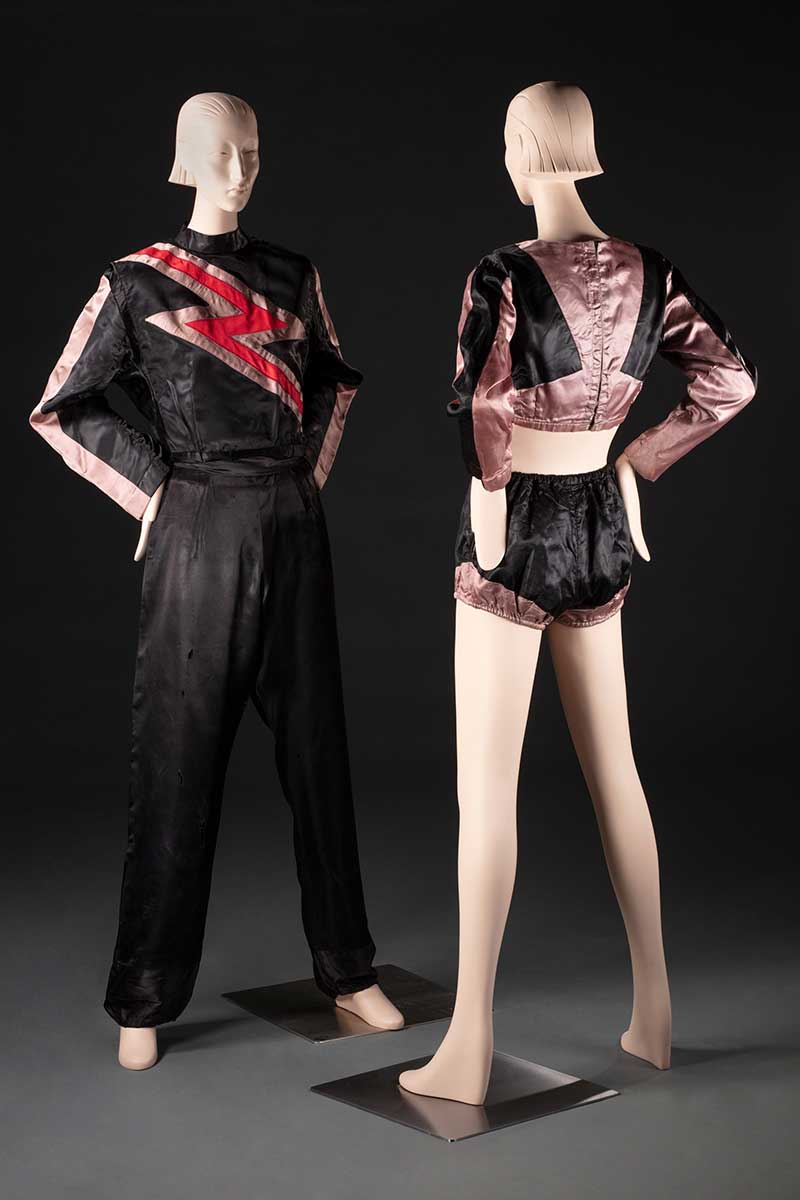
Demon Machine jumpsuit and two piece - courtesy NMA
The National Museum of Australia holds a large collection of dance costumes from several of Gertrud Bodenwieser’s performances, including Demon Machine. The Museum also holds numerous dance programs and advertising leaflets for the Bodenwieser Ballet group, and programs for tribute performances after Bodenwieser’s death. The collection includes several pieces of sheet music for various dance performances. The Museum has a number of personal items belonging to Bodenwieser, brought with her while fleeing from Europe. These include a necklace, dress ring, jewellery box, silver basket, and Bodenwieser’s wedding ring.
